TRANSPORTATION LONG HAUL
Shannon Newton committed to state’s trucking industry
 By Angela Forsyth
By Angela Forsyth
INSIDE: Pickleball explosion | Dynamic Duos | Happy Eggs

Shannon Newton committed to state’s trucking industry
 By Angela Forsyth
By Angela Forsyth
INSIDE: Pickleball explosion | Dynamic Duos | Happy Eggs

We listen carefully, thoughtfully analyze how our processes, services and technologies impact your experience, and customize solutions to meet your supply chain needs. It’s more than just knowing your business — it’s about developing true connections, so when you need help with a problem, you know just who to call.
Ship freight anywhere, at any time, and effectively manage your supply chain — no matter the size of the shipment, type of product or speed of delivery.
Welcome to ArcBest.







As a rm built on relationships, our handshake matters. It means a warm greeting, the privilege of doing business together and knowing you can count on us. A handshake between two brothers, Witt and Jack Stephens, provided the foundation for a family-owned legacy that Jack’s son Warren upholds today. Under Warren’s leadership, Stephens continues to grow as one of America’s largest privately held independent nancial services rms, with of ces throughout the United States and in Europe. Our performance builds relationships with our clients, many of whom have become old friends. It’s why shaking hands with us means just a little bit more.

111 Center Street




Little Rock, AR 72201

(800) 643-9691






















FEATURES MAY 2023

Walmart has committed to more sustainable operations and as part of this initiative, has launched its first truck fueled by natural gas — the first of many to come.

Pickleball — yep, pickleball — isn’t your grandfather’s game, anymore. The game has exploded across the country including here in Arkansas, where pickleball-specific facilities are being built.

It’s time once again to shine a spotlight on those Arkansas “dynamic duos” who are making their presence felt in business and philanthropy.
Joseph Wood, director of transformation and shared services in Gov. Sarah Sanders’ cabinet, has always taken the road less travelled.
PRESIDENT & PUBLISHER
Heather Baker | hbaker@armoneyandpolitics.com
SENIOR EDITOR
Mark Carter
EDITORIAL SERVICES
Ya!Mule Wordsmiths | Little Rock
ASSOCIATE EDITOR
Sarah Coleman | scoleman@armoneyandpolitics.com
STAFF WRITERS
John Callahan | jcallahan@armoneyandpolitics.com
Mak Millard | mmillard@armoneyandpolitics.com
Katie Zakrzewski | katie@armoneyandpolitics.com
MANAGING DIGITAL EDITOR
Kellie McAnulty | kmcanulty@armoneyandpolitics.com
Junior Achievement of Arkansas aims to leave a legacy of financial literacy. Its legacy Award winners are helping it achieve its goal.
ONLINE WRITER
Kilee Hall | khall@armoneyandpolitics.com
PRODUCTION MANAGER
Mike Bedgood | mbedgood@armoneyandpolitics.com
GRAPHIC DESIGNER
Lora Puls | lpuls@armoneyandpolitics.com
SENIOR ACCOUNT EXECUTIVE
Greg Churan | gchuran@armoneyandpolitics.com
ACCOUNT EXECUTIVES
Tonya Higginbotham | thigginbotham@armoneyandpolitics.com
Mary Funderburg | mary@armoneyandpolitics.com
Colleen Gillespie | colleen@armoneyandpolitics.com
Dana Rodriquez | dana@armoneyandpolitics.com
Jona Parker | jona@armoneyandpolitics.com
SALES COORDINATOR
Jessica Everson | jeverson@armoneyandpolitics.com
ADVERTISING COORDINATOR
Rachel Mercer | ads@armoneyandpolitics.com
CIRCULATION
Ginger Roell | groell@armoneyandpolitics.com
Tommy May is banking legend in Arkansas, and he’s featured this month in the latest installment of Arkansas Visionaries.
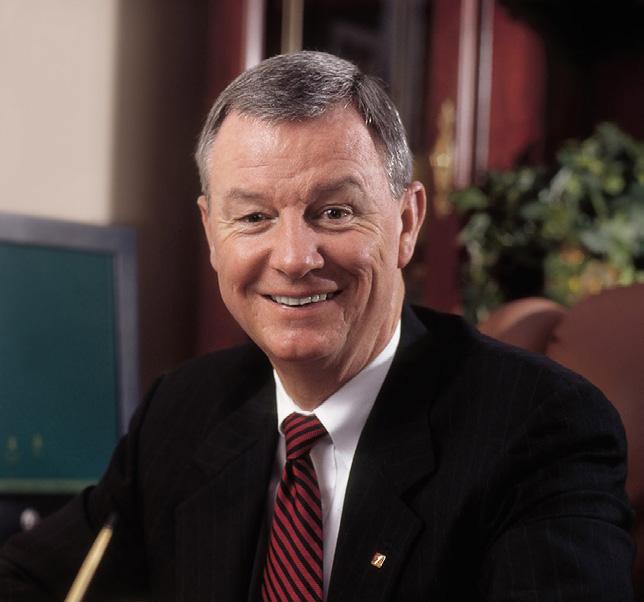
The Arkansas Game & Fish Foundation has launched a corporate partnership program to help realize its mission of conservation.
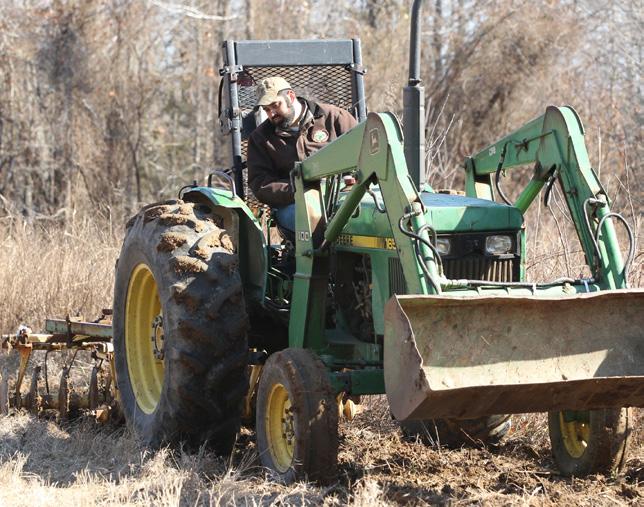
ADMINISTRATION billing@armoneyandpolitics.com

CEO | Vicki Vowell
TO ADVERTISE call 501-244-9700
email hbaker@armoneyandpolitics.com
TO SUBSCRIBE | 501-244-9700
ADVISORY COMMITTEE
Susan Alturi, Scott Hamilton, Tommy Keet, Bobby Martin, Shannon Newton
CONTRIBUTORS
Andrew Balthop, Bryan Clifton, Casey Covington, Evin Demirel, DeWaine Duncan, Angela Forsyth, Becky Gillette, Kenneth Heard, Dwain Hebda, Jason Burt, Stephen Miller, Jamison Mosley, Jeff Standridge, Steve Spencer, Travis Tolkar
Business travelers in Arkansas will find that they have plenty of attractive options, whether business takes them to NWA or El Dorado.

Sam Pittman and his aggressive young staff in Fayetteville are taking Razorback football recruiting where it’s rarely been.

W. Second St., Suite 200, Little Rock, AR 72201.
Inquiries: Subscription rate is $28 for one year (12 issues). Single issues are available upon request for $5. For subscriptions, inquiries or address changes, call 501-244- 9700. The contents of AMP are copyrighted, and material contained herein may not be copied or reproduced in any manner without the written permission of the publisher. Articles in AMP should not be considered specific advice, as individual circumstances vary. Products and services advertised in the magazine are not necessarily endorsed by AMP. Please recycle this magazine.
Specializing in building one-of-a-kind custom homes and combining leading edge designs with exceptional functionality that speak not only to your aesthetic needs, but to your unique vision, through our remarkable attention to luxury in every detail. Innovation-Redefined. Pushing beyond the predictable to create truly unique custom homes.




This month’s cover shot of Arkansas Trucking Association President Shannon Newton was shot in Little Rock by Jamison Mosley. Newton and her efforts on behalf of Arkansas truckers are profiled in this month’s issue.

Page
BARNSTORMER! DELTA CROP DUSTERS A DIFFERENT, ESSENTIAL BREED OF AVIATOR
“He’s a good one! True professional!”
John Snyder
DEVELOPING MENTAL TOUGHNESS: A PERFECT 10 FOR PEOPLE WHO WIN
“Great read!”
Mallory Watson

LITTLE ROCK ATHLETIC CLUB GETTING PICKLEBALL PARK
“Exciting”
Precious M White
JAMA BEST PRESENTED WITH LIFETIME ACHIEVEMENT AWARD
“Congratulations Jama, Quite an honor and achievement!”
Stan Graves
HISTORIC KRESS BUILDING IN HOT SPRINGS UNDER NEW OWNERSHIP
“They will be good stewards of that building.”
John J. Archibald
NORTH LITTLE ROCK COUNCIL TO VOTE ON LUXURY HOTEL FOR ARGENTA
Tiffany S Greene
In January 1942, the newly created War Production Board required all U.S. factories to stop what they were doing and begin production of the war machine necessary to help win WWII.
It’s one of the rare examples of Big Government winning the day.
And the world needed it to be Big that day. Without that specific federal intervention into the free market, there soon wouldn’t have been a market to patronize, free or otherwise.
The great Philip K. Dick imagined an alternate history in which the U.S. was late to the cause and the victorious Nazis and imperial Japanese partitioned the continental United States. But the day indeed was won, and Admiral Yamamoto’s cautionary tale of America as sleeping giant realized in full.
Although one never knows what one will get when it comes to spring weather in Arkansas, it’s been nice to see folks out working in their gardens and to see the signs of spring. And you know what they say, April’s garden rows bring May’s Dynamic Duos.
Each May, AMP shines a light on those “Dynamic Duos” who help make Arkansas such a great place to live and work.
Nominated by AMP readers, the 2023 Dynamic Duos represent married couples, longtime business partners, siblings, mothers and sons — you name it. And through their businesses and philanthropic work, they’re making our communities better.
Also in May, Angela Forsyth profiles Arkansas Trucking Association

The giant no longer sleeps, of course; it’s too busy regulating and seeking out lower-case nazis against which to wage sociopolitical war. And climate change represents as active a front as any.
Inside this issue, Professors Andrew Balthrop of Fayetteville and Travis Tokar of Auburn consider the logistics challenges of a transition from fossil fuels to clean energy. And there are many. As noble a cause as the transition to clean energy represents, society can’t pivot on a dime — something the climate change warriors would do well to appreciate. As the professors note:
“The collective global approach to reducing dependance on fossil fuels has, in many ways, been like a series of crash diets — full of short-term wins but also unintended consequences that hinder long-term success and sometimes create

more problems than they solve. Constant calls for the next all-or-nothing policy, meanwhile, tend to polarize rather than unify, yielding a lack of buy-in that predictably limits positive results.”
The next all-or-nothing policy … That indeed seems to be the approach: You’re either with us — all the way — or you’re against us.
Lexie the golden retriever was a rescue dog, delivered a decade ago from an abandoned home in which she was found chained to the bathroom sink.
She was probably 4 or 5 at the time, we were told, and the severe skittishness which gradually abated attested to those years being hard ones.
Lexie never much cared for bathrooms after that, and understandably so. But she loved any other place we were. And from her customary spot by the front window, she loved seeing her adopted mom or dad pull in the driveway.
A trooper to the end, Lexie embodied unwavering trust and unconditional love. And she’ll be sorely missed.
By Heather BakerPresident Shannon Newton, who shatters the stereotype of what a trucking executive should look like. Dwain Hebda goes the extra mile or 26 to bring us more of his outstanding work, which this month includes a visit with Arkansas Visionary Tommy May, another look at generational businesses in Arkansas and much more.
Also inside, you’ll find at look at some of the state’s top business hotels, Q&As with two of the state’s top transportation execs, and the stories behind Happy Egg Co. and Pediatrica Therapeutics.
As always, thanks for reading. We have big plans for the future and would love for you to join us on the journey. Hit me up with story ideas at HBaker@ ARMoneyandPolitics.com.
An off-script remark about big oil companies during President Joe Biden’s State of the Union address gave his political opponents an opportunity to unite in mock laughter. But what shouldn’t be missed in the partisan exchange is that it highlighted the need for a more consistent, incremental and, dare we say it, bipartisan approach to a clean energy transition.
Biden was building his case for quadrupling the tax on corporate stock buybacks and lamenting “record profits” by the oil industry that, he said, “made $200 billion in the midst of a global energy crisis.” Then he departed from the teleprompter to explain why.
“They invested too little of that profit to increase domestic production,” he said. “And when I talked to a couple of them, they say, ‘We’re afraid you’re going to shut down all the oil refineries anyway, so why should we invest in them?’ I said, ‘We’re going to need oil for at least another decade.’”
As Republicans laughed at the 10-year timeline, Biden worked his way back to the prepared remarks. But while the president moved on, the core issue revealed in his comments is worth revisiting. To paraphrase Kermit the Frog, it ain’t easy going green.
The collective global approach to reducing dependance on fossil fuels has, in many ways, been like a series of crash diets — full of short-term wins but also unintended consequences that hinder long-term success and sometimes create more problems than they solve. Constant calls for the next all-or-nothing policy, meanwhile, tend to polarize rather than unify, yielding a lack of buy-in that predictably limits positive results.
For most countries, and especially the United States, quitting fossil fuels “cold turkey” is neither practical nor responsible. Certainly, some pain is inevitable if we are to transition to cleaner energy sources, but the current policy trajectory could result in crippling economic damage.
Last year’s rise in diesel prices provides one way to better understand where the United States stands and how we got here.
Distillate fuel oil, of which diesel is the most important and well-known component, is used in cars, buses, trucks, boats, trains, heavy construction
vehicles, tractors, and airplanes, not to mention electricity production. Importantly, it is also used as heating oil, so demand fluctuates seasonally.
On the supply side, distillate fuels are refined from imported and domestically produced crude oils. Both of these sources have become more restricted: U.S. crude production has yet to rebound to pre-COVID-19 levels, while the Russia-Ukraine war has disrupted global crude supplies and trade patterns.
The annual winter increase in demand, combined with the disruption of supplies, predictably caused distillate prices to rise considerably. And those prices aren’t likely to drop significantly, in part because of what is happening with refineries.
Those concerned about climate change welcome the idea of gently increasing fossil fuel prices because it reduces consumption and incentivizes cleaner energy alternatives. However, record high “crack spreads” are

a warning that the country isn’t easing into this transition. Crack spreads — the difference between the price of crude inputs and refined outputs — are an indicator of short-term refinery profits.
Normally, a high spread would induce refiners to increase production; however, more output is not coming. Why? Because refineries are already operating at maximum capacity.
The next logical expectation is that companies would expand capacity. After all, if there is money to be made, shouldn’t someone be willing to capitalize? But, as with greater output, any additional refinery capacity seems unlikely.
“I don’t think you are ever going to see a refinery built again in this country,” Chevron CEO Michael Wirth told The Washington Post last year. “It’s been 50 years since we built a new one. In a country where the policy environment is trying to reduce demand for these products, you are not going to find companies to put billions and billions of dollars into this.”
The same applies to any potential expansion efforts — or even routine upkeep that would allow existing refineries to maintain current production. In fact, between September 2019 and September 2022, the U.S. lost about 786,000 barrels per day in distillation capacity as refineries simply shut down after weighing the costs against the benefits of continued operation.
Activists might applaud this capacity reduction, but they should be more circumspect. Aging refinery infrastructure, much of it located in coastal areas subject to natural disasters, makes the energy supply chain dangerously fragile. Resultant disruptions increase the pain of energy transition and erode popular support for meaningful climate policies in years to come. Thus, urgent action is needed to make the refining industry more resilient.
Embracing some basic insights from the field of supply chain management can help policymakers understand and more effectively navigate the transition to cleaner energy, reducing stress on the economy and the lives of consumers. These three areas are starting points to ponder prior to diving headfirst into the next fad approach to policy:
Reduce demand uncertainty. As Biden noted, few companies are willing to invest in maintaining or expanding refinery capacity because of uncertainty in future fossil fuel demand. Refineries are enormous, long-lived and irreversible investments. Returns on these investments are predicated on the demand for refined fossil fuels over 30 years or more.
Climate policy uncertainty makes it impossible for the industry to forecast demand, plan phaseouts and determine where investment is needed. Industry will delay needed supply chain investments until policy uncertainties have been resolved.
A bipartisan approach is essential to creating policies that industry leaders can buy into and plan around. Politicians from both parties need to look beyond their personal horizons of two to six years and compromise to create phased-in, 20-to-30-year solutions.
One potential approach is carbon pricing. This would involve a carbon tax levied against companies emitting carbon dioxide, or a cap-and-trade program. The tax is a fix priced per ton of CO₂ emitted, while the cap-andtrade program limits how much CO₂ a facility can emit.
These policies create incentives to decrease demand but can be phased in slowly and with clearly established timelines, thus creating clarity for refiners. While such programs have strong objectors, supporters aren’t limited to climate-change activists. Industry leaders such as BP recently voiced support for the Climate Commitment Act in Washington state, which involves “cap-and-invest” regulation.
Reduce product assortment and complexity. An excess of refined fuel types has created unnecessarily complex supply chains; e.g., local variation in air pollution regulations has turned the U.S. into a “boutique fuels” market, with more than 50 different gasoline “reformulations” alone. These regulations significantly reduce industrial flexibility, making it difficult to react to disruptions and provide consumers a consistent supply of fuels.
State and local regulators should be encouraged and incentivized to standardize and consolidate requirements across broad geographical markets, making it easier for refiners to forecast and plan for demand. As total fossil fuels consumption falls, so does environmental justification for these diverse standards.
Reduce logistical constraints. The Jones Act has regulated U.S. shipping since 1920 and prevents foreign ships from moving goods between U.S. ports. Only 55 tankers qualify under the act to move diesel from Gulf Coast refineries to the Northeast, where the diesel shortage is more severe. This policy-created dearth of transport capacity leads to conditions where the cost to move oil by ship is twice what it would be in an unrestricted market, according to a report by CNBC.
Eliminating, suspending or redefining elements of such legislation can ease logistical constraints so that the supply chain operates more efficiently and inventories meet demand during the transition period from fossil fuels to cleaner energy options.
Whatever approach lawmakers take, efforts need to start immediately. The U.S. is losing refineries every year, and such closures could accelerate as worsening economic conditions make it even less likely that companies will invest sufficiently to maintain production capacity.
Because many homes are heated with petroleum products and virtually everything we consume rides on the backs of diesel-powered trains and trucks, the implications are enormous for both cost and product availability for every U.S. resident.
History has proven that supply chains, like people, don’t respond well to crash diets. A strategic and long-term approach is the only way to offset unintended consequences and produce a healthy transition.
Travis Tokar (PhD, University of Arkansas) is a Professor of Supply Chain Management at the Neeley School of Business, Texas Christian University. His research focuses on issues of both managerial and consumer judgment and decision making in supply chains, with particular interest in demand planning activities such as forecasting and replenishment. He is also interested in the interface between supply chain management and public policy. His work has been published in several leading supply chain management academic journals.
Andrew Balthrop (PhD, Georgia State University) is a research associate within the Supply Chain Management Research Center at the Sam M. Walton College of Business at the University of Arkansas. His research focuses on the interaction between supply chains and public policy.
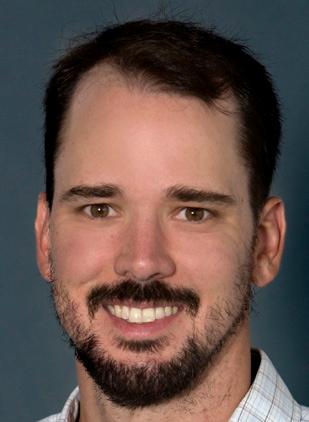
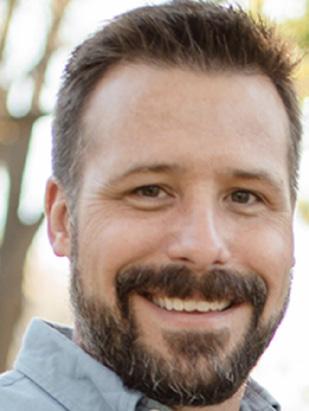
“Our transportation decisions determine much more than where roads or bridges or tunnels or rail lines will be built. They determine the connections and barriers that people will encounter in their daily lives, and thus how hard or easy it will be for people to get where they need and want to go.”
Adequate and accessible public transportation is vital to a thriving city. Metroplan member Rock Region METRO strives to make central Arkansas as equitable and healthy as possible by providing transportation mode choice and access.
Since the pandemic, METRO has provided more than 1.3 million passenger trips annually through a network of 15 fixed bus routes, eight microtransit zones and paratransit, streetcar and vanpool service.
What does this mean for the environment and central Arkansas air quality?
According to the Centers for Disease Control and Prevention, “For every passenger mile traveled, public transportation produces only a fraction of the harmful pollution of private vehicles: only 5 percent as much carbon monoxide, less than 8 percent as many volatile organic compounds, and nearly half as much carbon dioxide and nitrogen oxides.”
METRO participates in Metroplan’s Ozone Action Days public awareness initiative, encouraging central Arkansas residents to ditch the keys and share their rides to help reduce harmful groundlevel ozone. Breathing this type of ozone can cause detrimental health impacts, from chest pain to congestion, particularly among vulnerable populations.
Sharing your ride with others helps mitigate carbon emissions and reduce ground-level ozone, improving our collective air quality. METRO’s mass transit system is inherently sustainable and continues improving its sustainability by converting its fleet to low- and noemission vehicles and optimally matching service with demand to boost service productivity.
Some ways the agency is doing this include: incorporating compressed natural gas-powered buses into its fleet and, in the near future, zero-emission battery-electric buses, as well as utilizing technology to gain efficiencies and investing in customer-friendly strategies to make transit use more appealing.

How does the central Arkansas community make use of this sustainable service today?
The transition to more frequent use of public transit doesn’t happen overnight. We can appreciate our public transit system sustainably connecting employees to jobs, students to school and residents to health care and groceries and encourage more use by promoting “first steps” to incorporating multiple modes of transportation in our own lives.
For example, is your student attending one of the six academic institutions that offer fare-free Little Rock and North Little Rock METRO bus and microtransit rides to students through paid partnerships
with METRO? All it takes is a current school ID to take advantage of this sustainable and convenient perk.
A fare-free transit pass can offer a more sustainable ride to school, work, health care and nutritious foods. For example, a Philander Smith College student’s research project on Little Rock food deserts, linking food insecurity and access to reliable transportation, helped lead to the college’s new fare agreement with METRO.
Finally, from an economic development perspective, we know a more sustainable community is a community set to thrive in the 21st century. When we accept that not every member of our community has access to reliable private transportation, we can encourage ridesharing as a smart, sustainable way to get employees to work and to get patients to the health organizations that depend on them for financial stability.
Multiple transit options exist in our market to do this. For example, employers can bring people from outside of the Little Rock metropolitan area to job sites in Little Rock, North Little Rock, Benton, Bryant, Cabot, Jacksonville, Sherwood and Maumelle through Arkansas’ first public-transit-funded vanpool program. Individuals with disabilities who need transportation to jobs and health care appointments can use accessible buses, microtransit vehicles and paratransit vehicles.
On-demand microtransit service and the existing bus route network can help those employees whose ride arrangements fell through at the last minute to get to work or wellness visits. Consider arming your employees with information on how your team and clients can get to your site with a more sustainable commute.
What’s next?
Later this year, METRO’s investments and innovation will also make it easier than ever for residents to share their rides to mitigate harmful ground-level ozone levels when their fleet of battery-electric buses hit the streets! As more people gain access to these services, we’re excited to continue to see how technology transforms the transit industry.
Encouraging public transit use is just one among several ways we can improve central Arkansas’ air quality. Engaging in active transportation (walking, cycling), and working remotely when able are even more. Let’s take these small steps now for a brighter tomorrow. Learn more at Metroplan.com.
Nestled discreetly in a densely wooded area of Jefferson County is the U.S. Food and Drug Administration’s only research lab located outside of the Washington, D.C., metropolitan footprint.
The National Center for Toxicological Research (NCTR) was established in 1971 with a vision to “conduct scientific research to provide reliable data for FDA’s decision-making and develop innovative tools and approaches that support FDA’s public health mission.” This makes NCTR part of an entity that regulates 25 cents of every $1 in consumer spending.
The FDA serves as an essential oversight. NCTR is here to protect consumers, providing an essential safeguard to assuring that products ranging from lifesaving drug treatments to farm-raised produce are safe for public use. Animal testing has long been a method that NCTR researchers have used to determine product efficacy and safety. However, promising new techniques are leading NCTR into an exciting alternative direction for testing.
Dr. Laura Schnackenberg is an Arkansas Research Alliance (ARA) Academy Member and NCTR’s director of the Division of Systems Biology. She leads a multidisciplinary team exploring a wide range of innovative research. One area of research is focused on reducing the use of animal testing in nonclinical studies. After all, many drugs are withdrawn post market simply because animal physiology is not a perfect predictor of how a drug will affect humans.
This discrepancy between man and animal can lead to a significant cost. In the United States, about 45 percent of the population takes at least one prescription medication. On average, about 4,500 drugs and devices are pulled from U.S. shelves each year. Of course, animal testing is not to blame for all drug recalls, but the price tag of drug recalls can cost companies (and eventually customers) hundreds of millions of dollars. Any effort to mitigate testing discrepancies would lead to significant consumer savings.
“Traditionally in the development of a new drug, there has been a reliance on animal testing,” Schnackenberg explained. “Animals currently serve as surrogates for humans, but no animal can completely mimic a human. What we’re trying to do is develop in vitro models that can theoretically better mimic the human situation.”
The answer may lie in two-dimensional models derived from humans, which can capture accurate genetic components. The 2D model works well as a quick screen, but a more complex version of this technology is called a tissue chip (or “organ on a chip”) — engineered microsystems that represent units of human organs (such as the lung, liver and heart) modeling both structure and function. A tissue chip is more physiologically relevant, as it includes four
major cell types that account for about 95 percent of the cell.
Tissue chip technology will likely make drug development, especially toxicology and efficacy screening, more reliable. It may also eliminate the need for animal testing — eventually.
“The technology is very promising, but for the time being cannot fully replace animal testing,” Schnackenberg said. “For now, animal testing must still be used to validate the results garnered from in vitro models.”
Schnackenberg says that the NCTR Division of Systems Biology is also working on computational models, which will also help in speeding up the drug development process. Currently in NAMS research, it that would take almost 80 different organs on a chip to recapitulate the holistic system of what can be done in one mouse model.
In the meantime, Schnackenberg is hoping that the work conducted by the NCTR Division of Systems Biology, currently staffed by 15 research investigators, receives its well-deserved notice.

“The Systems Biology Division is something I’m very passionate about,” she said. “We have some incredible investigators who are doing some amazing work. I’d love to see them receive the recognition they deserve.”
Discovery Economics is a monthly feature highlighting the work of the ARA Academy of Scholars and Fellows, a community of strategic research leaders who strive to maximize the value of discovery and progress in the state. ARA recruits, retains and focuses strategic research leaders to enhance the state’s competitiveness in the knowledge economy and the production of job-creating discoveries and innovation. Learn more at ARalliance.org.




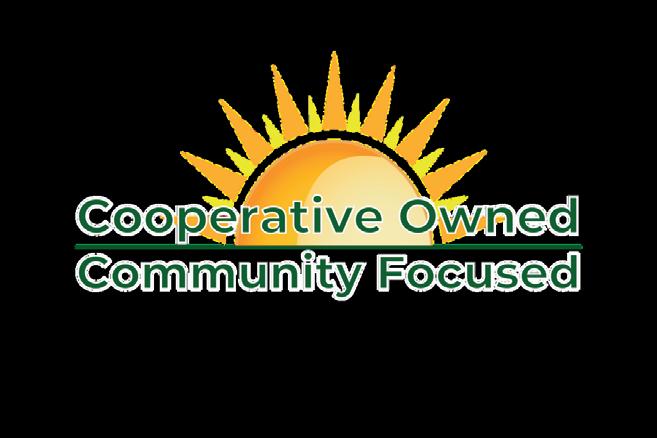









Pushing for better policies and a better image for Arkansas truckers, Shannon Newton manages the large and small of the Arkansas Trucking Association. Her’s might not be the face you picture when you first hear the title, “president of the Arkansas Trucking Association,” yet Newton has held this position for a couple of decades. And although she’s not a literal truck driver, she has steered the organization through multiple economical ups and downs while driving Arkansas’ trucking business forward.
The native Arkansan came to work at ATA in 2003 shortly after having obtained her bachelor’s in accounting. So how does a young woman with an accounting degree end up as the leader of the Arkansas Trucking Association? The answer is, with a good head for business, a thirst for industry change and a little bit of coincidence.
After attending high school in central Arkansas, Newton attended the University of Central Arkansas in Conway and completed her accounting degree. She had clicked with a recruiter at a job fair and gone directly to work as an accountant at Maverick Transportation in North Little Rock. Maverick happened to be a very engaged member of the ATA, and Newton was consequently exposed to the organization. Maverick’s chairman at the time was also on the board of directors of the association.
By association, she came to know the current issues board members were working on and details about what was involved. After working at Maverick for one year, she was offered an opportunity to work at ATA.
Newton was the perfect candidate for the job. The association needed someone with an accounting background to manage its insurance group. To this day, ATA still offers an insur-
ance package for its smaller members. It allows small business members to pool their risk together and cover their own insurance. The association manages bookkeeping and accounting for this program.
In June of 2023, Newton will celebrate her 20th year with the association. In her current position as president, she leads a small staff while taking on the greatest responsibilities of the nonprofit. ATA is owned and governed by more than 300 trucking companies and suppliers — some with less than five trucks and others representing the nation’s largest fleets. The agency works to advance the trucking industry’s image, efficiency, com-
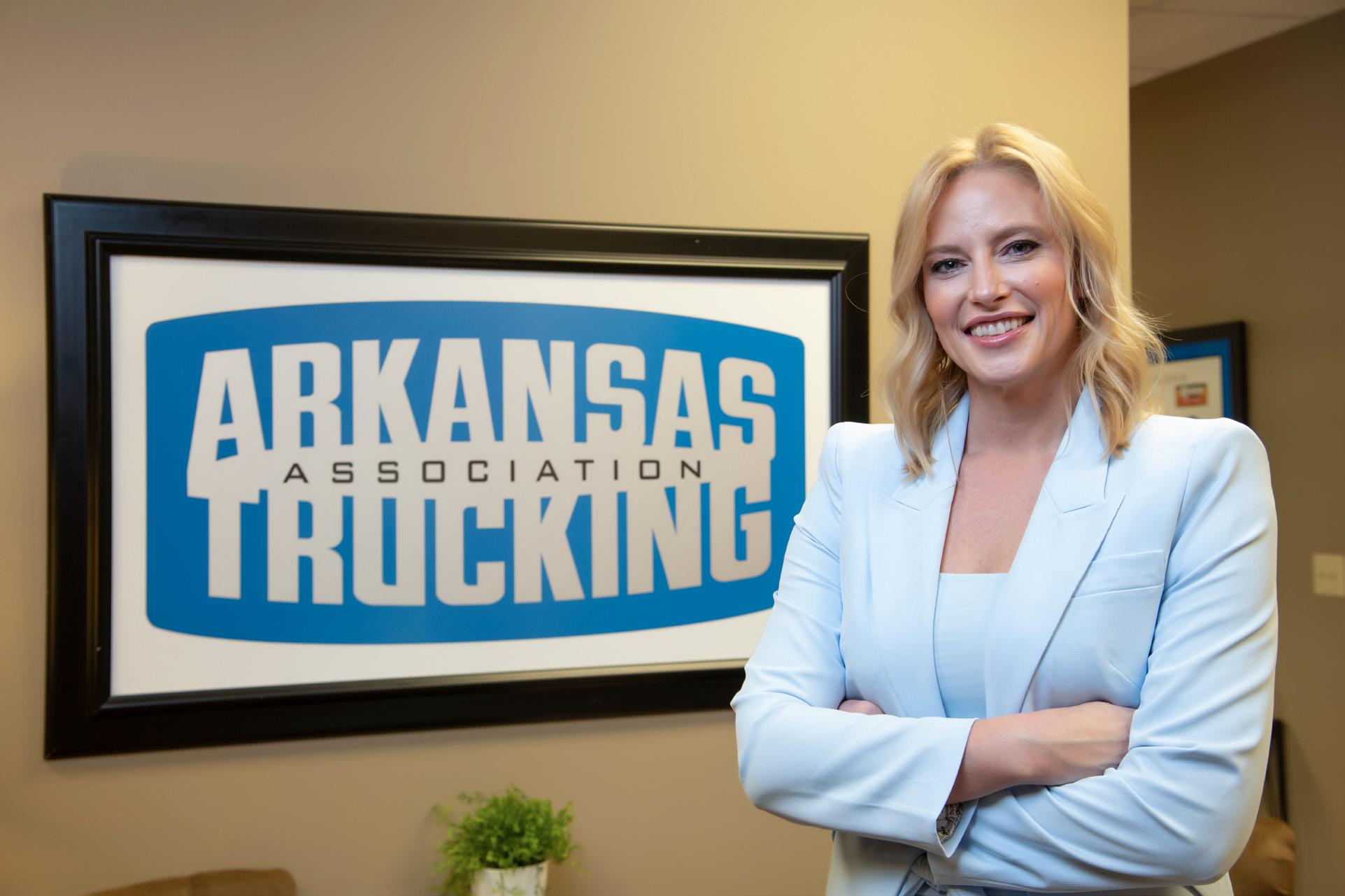
zation does have contract lobbyists,” she explained, “I’m still the face of the trucking industry at the capitol for every policy that is proposed that impacts our industry — whether it be insurance issues, tax issues, transportation issues or the rules of the road. From January until April, I’m at the beck and call of policymakers.”
For Newton, collaborating with policymakers includes engaging on issues that could benefit the trucking industry, in which case she wants to be there in person to weigh in, support and advance those regulations. In other cases, policies proposed by others outside of the trucking business might have unintended consequences. In those situations, ATA goes to the capitol to educate and advocate on behalf of the industry.
For this married, working mother of two teenaged kids, those months of high-level legislation can feel “all-consuming.” But when the season ends, the immediacy and demand for multiple hours a day dedicated to that part of the job ends. There may be some scheduled follow-up conversations over the next few months, but for the most part, the days are cleared up for her other responsibilities.
petitiveness and profitability. It works with leaders in Washington, D.C., to push the industry’s interest forward while organizing tradeshows, member-led industry groups and corporate services.
It’s a big job, and one about which Newton feels very passionate.
“One of my favorite things about this job, and the reason that I’ve been here 20 years, is that every day still feels like a new adventure because there are no two days that are the same,” she said. “I would say that I could best describe it as seasonal.”
Newton found herself smack dab in the middle of the recently concluded legislative season, and is heavily involved in governmental affairs outside of the office. “While the organi-
One of her other main responsibilities includes covering public relations. If there’s ever any sort of breaking news story or accident — such as the crack in the Interstate 40 bridge over the Mississippi River a couple of summers ago — whatever she had planned for the workday goes out the window.
When she’s not running to Washington or putting out PR fires, she’s managing the association the same way a business leader would manage a company. She oversees seven employees and all the “regular” work — planning, budgeting, managing personnel, signing checks, reviewing contracts.
“It’s similar to running a small business in that aspect,” she noted. “One day, I might be approving a social media campaign or hiring someone to do a video … and then, I still have the selfinsurance.” Newton still oversees the books for the insurance trust, although now, she has help from her team in handling the day-to-day aspects of it.
After being a part of the trucking world for 20 years, Newton has had plenty of chances to ride the highs and lows of the industry. One of the challenges she currently deals with is the significant workforce shortage that has plagued the trucking industry even before the pandemic.

“The problem is complicated,” she said. “There’s a perception problem. There are industry image issues to overcome. I know people of my generation, and at least one generation behind me, we’ve had a sort of doctrinal belief. We define success as going to a four-year school and getting a job. There are so many opportunities in our industry. We have to reprogram that way of thinking. You can actually get a really great job in transportation without a four-year degree. Making parents, educators, counselors, teachers and young people all aware of the opportunities that exist and what the actual path from education to employment looks like in our industry has been a challenge. It’s something we’ve taken on pretty aggressively over the last four to five years.”
On the positive side, Newton is happy to see the increased interest in truck driving post-pandemic. As bad as it was, she’s
grateful for one silver lining. It gave truck drivers the opportunity to display what they do while the world watched.
“We received some positive attention on different levels, and it has been nice for people to think of the industry more positively.” Even with the gained interest in trucking, finding drivers remains a challenge. “We still have unseated trucks, but definitely the trend has been more positive for us coming out of the pandemic.”
One of Newton’s desires for the trucking industry is to normalize seeing women in the business. She noted that “it’s not really that different” from changing other perspectives about the industry. “A lot of people who think about trucking, think about white males.”
Although the industry is overwhelmingly made up of that demographic, she sees an opportunity for improvement. “Organizations are attuned to the fact that that’s not necessarily the best way to run an industry or business. There is actual value in diversity and value in difference of opinions. Having different perspectives at the table actually contributes to a more innovative, evolving and profitable business. The data backs that up.”
“One of my favorite things about this job, and the reason that I’ve been here 20 years, is that every day still feels like a new adventure because there are no two days that are the same.”








Walmart makes strides to reduce emissions with alternative fuel vehicles
 By Dwain Hebda
By Dwain Hebda
As one of the nation’s largest retailers, Arkansas-born Walmart, has pioneered a number of industry firsts. Its latest achievement may well be its most impressive and lasting yet, as the Bentonville-based giant makes good on its commitment toward more sustainable operations, introducing the first truck in its fleet to run on natural gas.
Unveiled last month, the rig runs on the inaugural X15N, a 15-liter compressed natural gas engine built by Cummins and fueled by Chevron. The Walmart truck, the first of an initial lot of five, will make its inaugural trip from Indiana to California, making pit stops along the way to refuel at Chevron stations.
At the end of the first run, the truck was at the Advanced Clean Transportation (ACT) Expo in Anaheim, Calif., May 1-4. There, the vehicle was displayed and made available for attendees to experience firsthand.
“Walmart transportation is focused on the continuous piloting of solutions that aren’t just changing the industry, but are having a lasting impact on the world,” said Fernando Cortes, senior vice president of transportation at Walmart in introducing the rig. “We are proud to team with Cummins and Chevron to develop industry-leading advancements that pave toward a lower carbon future.”
The news is the latest in a string of announcements by Walmart over the past 18 months that underscores the retailer’s commitment to going green throughout its transportation operations. In 2020, Walmart announced a bold new initiative to achieve zero emissions across global operations by 2040, and the natural gas truck is just one of several first-of-their kind initiatives.
“As the world’s largest retailer, with a world-class transporta-
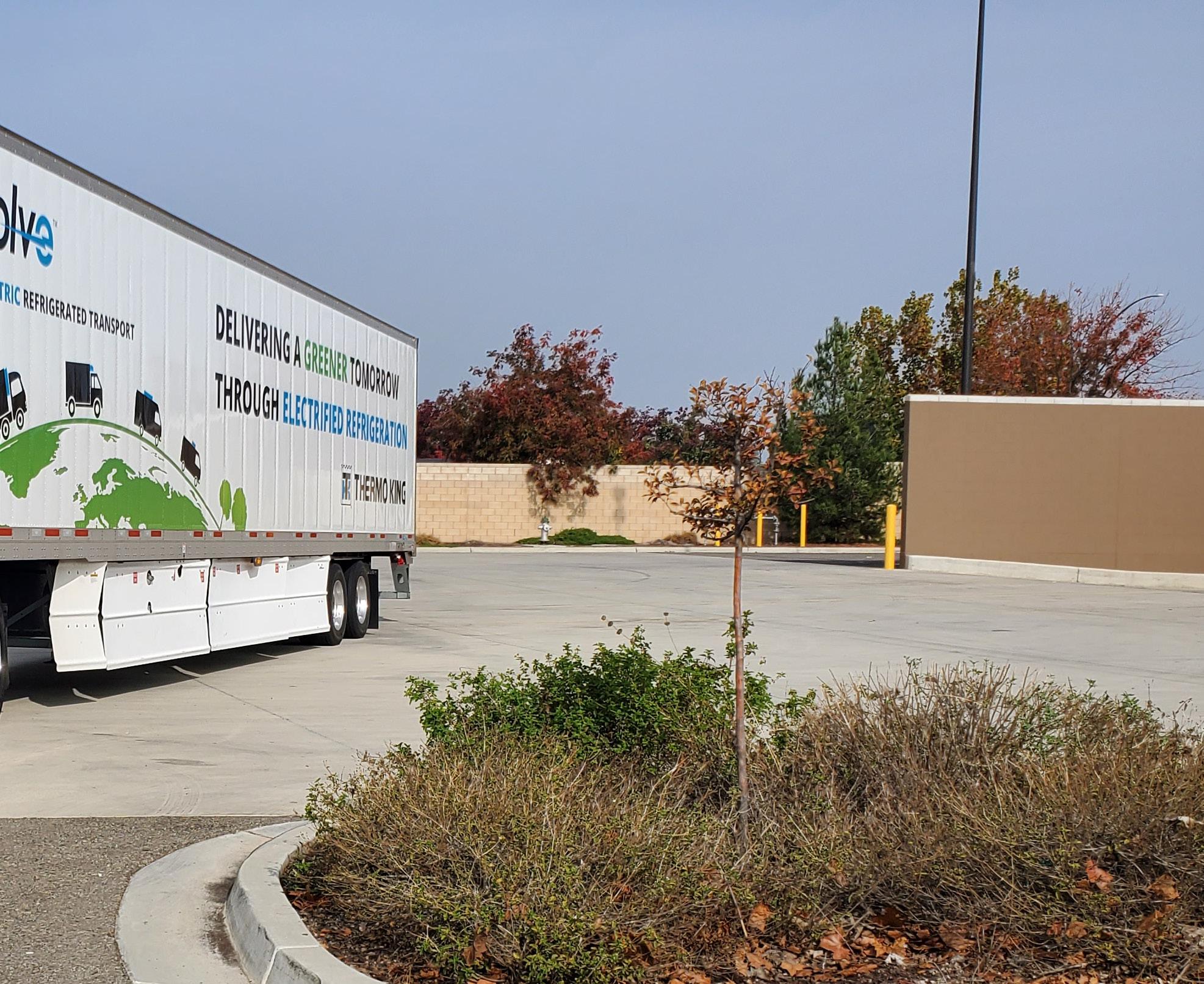
tion network, we have the ability to make a meaningful difference when it comes to reducing greenhouse gas emissions,” Cortes wrote in a blog post last June.
“This includes our last mile delivery fleet, an area that is uniquely positioned for innovative solutions. But there’s another fleet we’re committed to transforming, one that will have an even bigger impact on achieving our zero emissions goal: our Class 8 transportation fleet.”
Of all the measures Walmart is taking in this initiative, overhauling its trucking operations represents the gold ring in lowering the company’s carbon footprint. Walmart reports having one of the largest fleets in the U.S., comprised of 12,000 drivers, 10,000 tractors and 80,000 trailers driving 1.1 billion miles every year. At that scale, Class 8 trucks made up about 24 percent of the company’s Scope 1 emissions in 2020.
Walmart is targeting this substantial segment of emissions via threefold technologies — natural gas, hydrogen and electric — for over-the-road (OTR) and yard trucks. Besides the justdeployed Cummins natural gas engine, to be used for long-distance hauling, Walmart is positioning itself to be among the first to utilize hydrogenengine technology for yard trucks.
Using an engine that’s considerably lighter and faster to refuel, hydrogen fuel cell-powered trucks are a promising, if prohibitively expensive, option. Company officials said as the technology develops, they expect to see wider deployment of such vehicles as the price comes down. Even before that happens, Walmart has already begun transporting liquid hydrogen to its various grocery distribution centers to power forklifts, and the company is testing hydrogen fuelcell yard trucks, made by Texas-based Capacity, in the coming months.
Electric engine technology is also playing a major role in Walmart’s emissions reduction efforts. While limited current range and lack of reliable charging infrastructure makes allelectric OTR hauls impractical at present, the company ran a battery-electric day-cab proof of concept of Freightliner’s eCascadia and Nikola’s Tre BEV for short-range runs between suppliers and its distribution center in Fontana, Calif.

Walmart is also introducing refrigerated semi-trailers that run on electricity rather than diesel.

“We use 10,000 of these refrigerated trailers to safely distribute fresh and cold groceries to stores,” Cortes wrote. “Today, they rely on diesel fuel to keep them cold, which contributes to our overall CO2 emissions.
“We recently worked with Thermo King to haul Walmart’s first-ever refrigerated trailer operated on battery electricity in the U.S. The trailer is designed to run on 100 percent electricity until the batteries are fully depleted. If the electricity is depleted mid-haul, the refrigeration unit cuts over to diesel.”
As Cortes noted, the trial has been more than promising; over two months, Walmart ran 18 routes hauling groceries between its Shafter, Calif., distribution center and stores in the surrounding areas, whereby the test trailer ran electricity-only 83 percent of the time.
The company generated even more buzz last year with the summertime announcement that Walmart would be purchasing 4,500 all-electric delivery vans from EV manufacturer Canoo, with an option to buy up to 10,000 vehicles.
Canoo modified its Lifestyle Delivery Vehicles to the retailer’s specifications, offering
120 cubic feet of cargo volume and boasting a range of up to 250 miles. Just one month after the announcement, a handful of the vans were on the streets of the Dallas-Fort Worth market, delivering orders via Walmart’s InHome delivery service for online orders.
Walmart also made headlines on the delivery front for its 2022 announcement it would be expanding its drone delivery service by year’s end to customers in Tampa, Orlando, Phoenix and Dallas market areas. While that fell short of original projections that it would make the service available to up to 4 million customers over six states, it’s a quantum leap forward toward bringing drone technology into the everyday lives of consumers.
Some industry observers are quick to write off Walmart’s efforts as merely keeping up with the Joneses. In a July article announcing the deal with Canoo, Business Insider sniffed the shift to alternative fuel vehicles had as much to do with the competition as it did a carbon footprint.
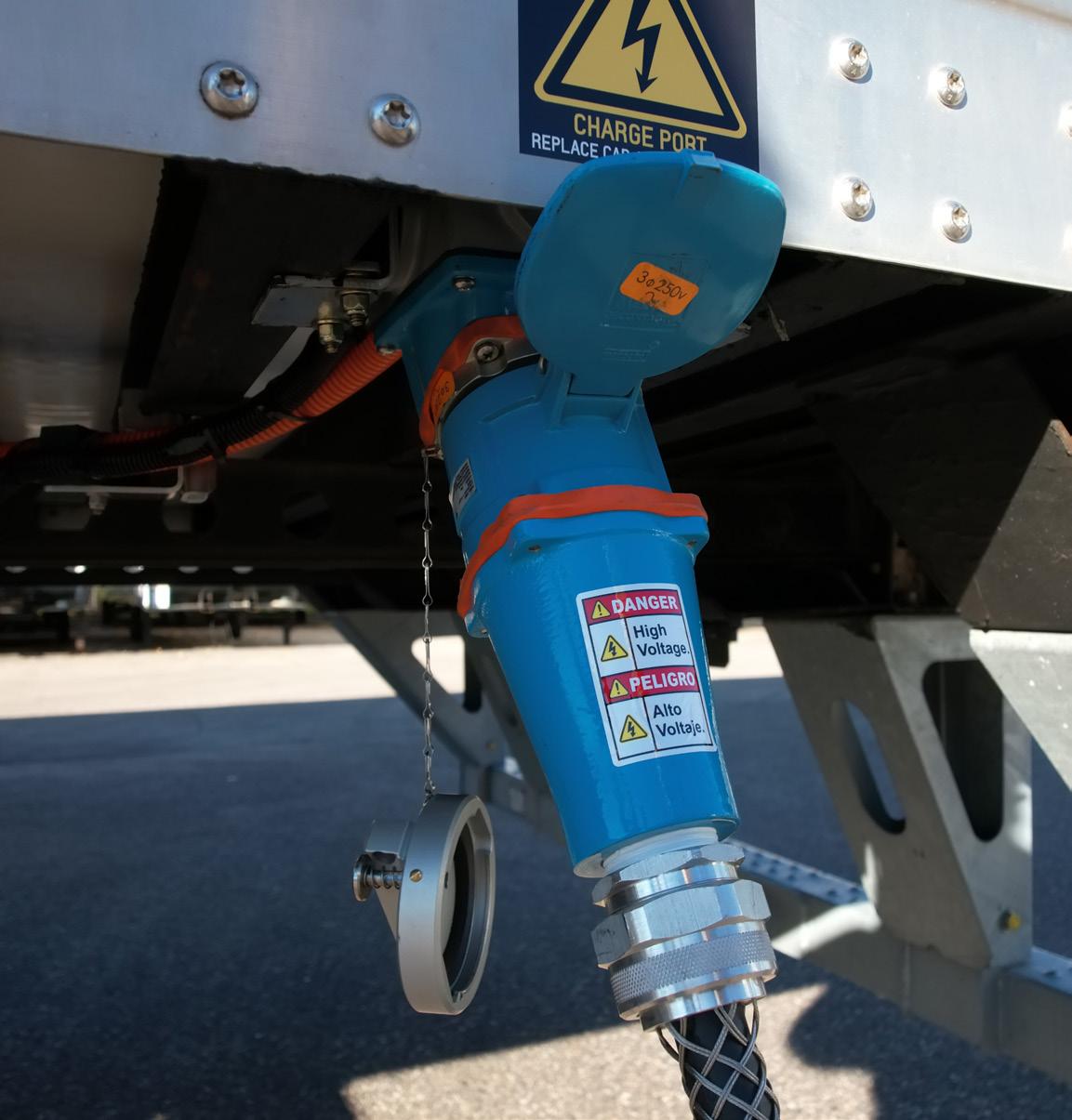
“The latest news from Walmart could be viewed as a response to Amazon’s 2020 unveiling of electric delivery vehicles,” wrote Áine Cain. “The two retail giants have long been in heated competition, with Amazon dethroning Walmart as the biggest retailer in the United States for the first time in 2021.

“In light of that growing rivalry, Walmart has begun using 3,800 stores as online fulfillment centers. As competition with its online rival Amazon continues to heat up, the brick-and-mortar company touts its ability to ‘reach 80 percent of the U.S. population with same-day delivery on a growing assortment of items.’”
While market pressures have always demanded response, the company’s most recent announcement related to EVs shows the company’s innovative vision goes beyond its own use of the technology. Last month, Walmart unveiled a plan to greatly expand EV charging stations at its retail stores and members-only Sam’s Clubs, a move officials hope will push EV
“By 2030, we intend to build our own EV fast-charging network at thousands of Walmart and Sam’s Club locations coastto-coast,” said Vishal Kapadia, Walmart’s senior vice president of energy transformation. “This would be in addition to the almost 1,300 EV fast-charging stations we already have available at more than 280 U.S. facilities.
“We are uniquely positioned to deliver a convenient charging option that will help make EV ownership possible whether people live in rural, suburban or urban areas. Our goal is to meet the needs of customers and members where they live and open the road to those driving across the country.”
The move to bring low-cost reliable charging is a good example of the company balancing a potential revenue stream with the greater-good initiative of advocating EV ownership in com-
“We want to play an important role in transforming the world’s supply chains to be regenerative.”
munities coast to coast.
“Easy access to on-the-go charging is a game-changer for drivers who have been hesitant to purchase an EV for concerns they won’t be able to find a charger in a clean, bright and safe location when needed,” Kapadia said.
“With our chargers located on-site with our Supercenters, Neighborhood Markets and Sam’s Clubs, we can offer customers and members the convenience of being able to pick up essentials for their families or grab a bite to eat while they charge. And in line with our purpose, we aim to offer ‘Every Day Low Price’ charging, helping ease transportation costs, still the second highest household cost for much of our country.”
The advancements in transportation-related alternative energy and their related benefits to the environment further accentuates what has been an ongoing effort at Walmart for nearly two decades. The results have been impressive; in 2020, the company reported it powered nearly a third of its operations with renewable energy and diverted about 80 percent of waste from landfills and incineration.
In announcing its zero-emissions initiative, the company also illustrated how such practices have accentuated operations, not hindered them. Walmart’s fiscal year revenues grew about $200 billion between 2006 and 2020 while simultaneously cutting CO2 equivalent emissions by about 3 metric tons. And that was two years before the company’s testing and deployment of alternative fuel vehicles began to gain traction in 2022, suggesting the company’s most dramatic reductions in emissions are yet to come.
“We want to play an important role in transforming the world’s supply chains to be regenerative,” said Walmart President and CEO Doug McMillon in a statement. “We face a growing crisis of climate change and nature loss, and we all need to take action with urgency.
“The commitments we’re making … not only aim to decarbonize Walmart’s global operations, they also put us on the path to becoming a regenerative company — one that works to restore, renew and replenish in addition to preserving our planet, and encourages others to do the same.”
In an effort to lure more employees into truck driver roles throughout its transportation system, Walmart is hoping its latest offer is one people can’t refuse.

Last year, the Bentonville-based retailer announced it was creating its own truck driver’s school to train interested supply-chain employees to become over the road drivers for the company. The 12-week program, offered in Dallas and Dover, Del., is taught by existing company drivers who have been trained as instructors through Walmart Academies.
And there’s more — upon completion of the program and attainment of a commercial driver’s license, employees are in line for some of the highest-paid private fleet jobs in the country. Walmart announced last year its drivers can now earn up to $110,000 in their first year, and veteran drivers can earn even more depending on tenure and location. Per Glassdoor statistics, that’s about twice the industry average.
The move is the boldest yet to address the truck driver shortage that has hampered the nation’s supply chain for years. The driver deficit hit a record high in 2021, with more than 81,000 driver jobs going unfilled, per Bob Costello, chief economist with the American Trucking Association. While focused marketing and rising pay have helped bring that number down to an estimated 64,000 vacancies in 2023, the future isn’t trending in the right direction.
Speaking to fleet executives at the ATA’s Management Conference & Exhibition in October, Costello predicted if current numbers hold, the driver shortfall could reach 120,000 vacancies by 2031. To avoid this, the industry must find a way to hire 1.2 million drivers over the next decade to fill current jobs, replace impending retirees and keep up with growth.






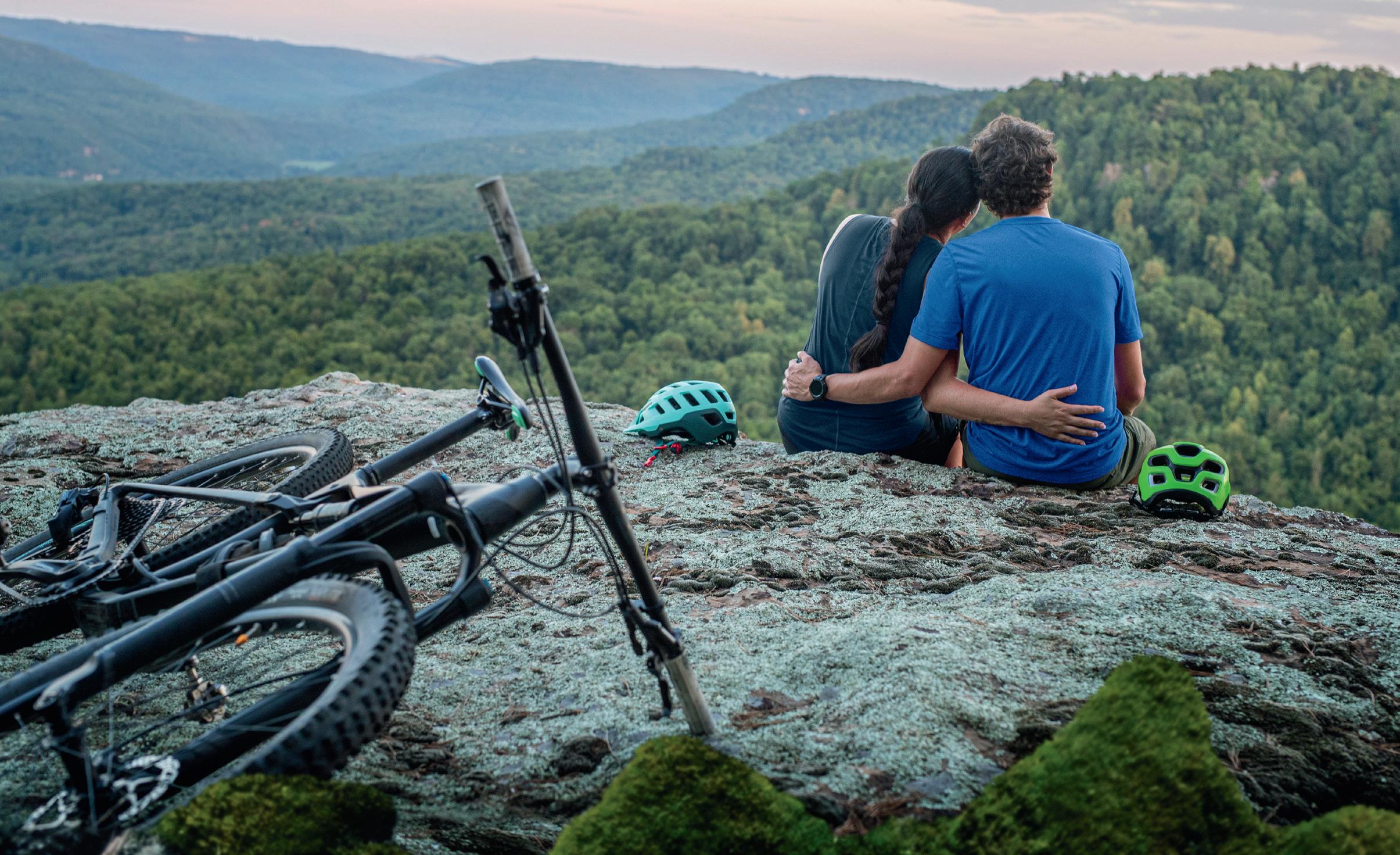







Like all trucking companies, Tontitown’s PAM Transport has learned to roll with the industry punches. Last year, it acquired New York carrier Metropolitan to expand its presence in the Northeast, and the company continues to make inroads into Mexico. By 2018, the company was leading all domestic carriers at the port of Laredo with more than 300 crossings per day to and from major Mexican markets.
Indeed, PAM is in cautious expansion mode, explained CEO Joe Vitiritto, who joined the firm in 2020.
Vitiritto has spent the whole of his career in trucking, starting out as a dedicated manager for Schneider and a terminal manager for Colton before moving up to SVP for Knight Transportation and then taking the same role for the merged Knight-Swift in Phoenix.
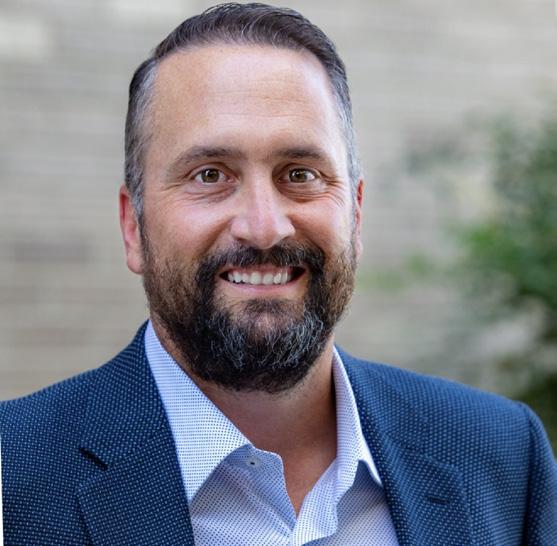
AMP: How is the industry handling the workforce shortage, and what is PAM doing to counter it?
Joe Vitiritto: Trucking has been dealing with a workforce shortage with drivers for many years. The pandemic exacerbated the issue. There has been some movement in the right direction, but mainly because of the impact of a changing economic and freight environment coupled with some supply chain issues getting resolved. But because of the longer-term trends of growing tonnage and the ever-increasing average age of truck drivers, we will continue to have issues with a shortage.
At PAM, we have hired and trained new drivers for a long time. It has helped us navigate this, but it still is challenging. There are just not enough people wanting to drive a truck over the road as a career. The industry is trying to overcome it, but there isn’t a silver bullet strategy to navigating our industry’s workforce shortage.
AMP: Discuss the Met acquisition and PAM’s expansion into the Northeast.
Vitiritto: Met was a solid multigenerational, privately run truck-
Vitiritto guided PAM safely through the pandemic, and though a soft freight market in the first quarter of 2023 resulted in an earnings loss, PAM managed a 1 percent revenue bump to $221.7 million.
Launched by Paul Allen Maestri in 1980, the company that bears his initials started with fived used Freightliner tractors and 15 trailers. Six years later, Maestri took the company public. In the ensuing decades, PAM’s fleet has grown to include 2,000 tractors, 6,000 trailers and 2,400 drivers.
Vitiritto visited with AMP about the ongoing shortage of drivers, how the Met acquisition infused the company with expansion confidence, possible future expansion markets and the secret to PAM’s success.
ing company, founded almost 90 years before we acquired it. Like so many other smaller trucking companies, there was just not a desire for the next generation to take over and continue to run the company.
By acquiring the business and running it as a separate entity, we were able to add coverage into an area where we didn’t have much coverage, maintain their brand identity and culture while helping them with economies of scale and best practices. They have a very experienced workforce and leadership team, which was a key part of the decision.
This also gave us access to additional customers that we didn’t have a relationship with before the acquisition.
It also has given us the confidence to go out and do more strategic acquisitions in the future.
AMP: What does the company look for in a new market or expansion target?
Vitiritto: There must be significant opportunity in the business segment or the geographical region of the potential expansion. We also look at the size of the addressable market and the competition. But the other factor we look for is sustainability of that expansion, and then we evaluate the ability to get the type of returns that our shareholders will expect. And can we diversify our customer base while still providing a high level of service? We also want to grow in areas that we know will give our people the opportunity for both personal and professional growth.
AMP: Will Mexican markets remain a priority, and are there new markets being considered?
Vitiritto: Because of nearshoring and onshoring, we believe Mexico is a critical growth market for us for many years to come. We also see that as global trade continues to evolve, there could be opportunities in the future in Central and South America. We also see Canada as on opportunity for growth at some point.
AMP: The company celebrated its 40th anniversary the same year you joined the team. What are some of the factors behind PAM’s success over multiple decades?
Vitiritto: I would say that our people are a big factor. You couple that with a long-term majority shareholder that is committed to growth and the long term, and you have a great recipe.
AMP: What attracted you to PAM? Any previous ties to Arkansas?
Vitiritto: I had been to Arkansas to visit customers in the past, had been to the University of Arkansas to recruit potential employees, and was always impressed with the talented people we hired, but had no additional ties. Since coming here, I realized quickly how friendly and hard-working the people in Arkansas are. I have lived in a lot of areas over my career and can say that Arkansas people are my kind of people.
It was a decision that I couldn’t pass up coming to PAM. There are not many public trucking companies, which limits the opportunity to be a CEO in our industry, and the plus was that it was in Arkansas.

“We believe Mexico is a critical growth market for us for many years to come. ... There could be opportunities in the future in Central and South America.”
 By Mark Carter
By Mark Carter
Most, if not all, of ArcBest Corp.’s almost 100 years have been good ones, the last few of them very, very good for the logistics provider based in Fort Smith.
Last May, ArcBest CEO Judy McReynolds was featured on the cover of AMP’s transportation issue on the heels of the company reaching the $4 billion benchmark.
The company’s ABF Freight subsidiary alone accounts for roughly two-thirds of company revenue and makes ArcBest one of the nation’s top 15 for-hire carriers, per industry journal Transport Tropics.
Last year, ArcBest generated fourth-quarter net income of $37.3 million with full-year net income of almost $300 million, a second consecutive year of record growth. Following its sale of subsidiary FleetNet, it returned $76 million to shareholders through its stock repurchase program.
Founded in 1966 as Arkansas Best and rebranded in 2014, ArcBest has grown into one of the nation’s top transportation companies, and it’s played a significant role in helping brand Arkansas as a hub of “logistics solutions.”
ArcBest has accounted for many of those solutions over the years. One of its latest is the Vaux freight movement technology. Using custom mechanical engineering and proprietary cloud software, Vaux transforms how freight is loaded, unloaded and transferred in warehouses, distribution centers and even over the road.
AMP: What’s the secret to the company’s success?
Newcity: We’ve experienced a lot in our 100-year history; what sets us apart is our ability to adapt. We listen to our customers, build trusted relationships and help them pivot quickly to respond to supply chain disruptions. We listen to our people, who are truly the heart of our success. And we listen to the environment, not only to what’s happening in our industry, but also to what’s happening with emerging technologies across many outlets – the new venture space, academia and innovators across the globe.
We are curious and capable, which has led to a long history of innovation — it’s ingrained in our culture — and we empower our employees to bring their ideas to the table. It’s that kind of transformative thinking that has enabled us to navigate
The man overseeing all this innovation is Michael Newcity, ArcBest’s awardwinning chief innovation officer and president. Newcity, who’s been with ArcBest since 1993 and previously served as CFO and SVP/CIO, visited with AMP about its record growth and the drive for innovation necessary to keep pace in a fastmoving industry.
uncertainty and continue to grow.
Michael NewcityAMP: Speaking of innovation, can the company’s new freight movement tech be a game-changer?
Newcity: Vaux is revolutionary in that it transforms how key supply chain issues are managed. It opens the door to significant efficiency gains by cutting traditional trailer load/unload times from hours to mere minutes, in turn creating a safer working environment, improving sustainability and requiring fewer freight touches (which means less damage). Solving those issues is definitely game-changing.
AMP: What are the most pressing issues facing logistics providers? What keeps supply chain managers up at night these days?
Newcity: Our customers rely on us to keep their supply chains moving, so that’s what we’re focused on. What’s keeping them
ArcBest says its new Vaux system, with its innovative platform (right), can drastically reduce the amount of time spent loading and unloading. (Photos provided)
up at night are challenges like cost control, dock congestion and changes in consumer demand. We leverage our full suite of logistics solutions and leading-edge technology to help them overcome supply chain disruptions and volatility, and we go to work every day finding ways to improve our operational efficiency so we can serve them better.
AMP: How do you manage a dynamic supply chain?
Newcity: The ability to adapt to an ever-changing economy is critical for our customers and for us. Our integrated logistics approach combined with 100 years of experience provides customers with the right solutions for their situation. Technology is the key enabler, allowing them to pivot quickly and use their supply chain as a competitive advantage, but it’s not just about new software.
Dynamic supply chains require new thinking on all fronts – material handling equipment, tech-infused partnerships, data science and more. Supply chains are complex. The successful enablers of dynamic supply chains must overcome that complexity.
AMP: Any forthcoming innovation from ArcBest that you can tease?
Newcity: Going back to our innovative mindset, we’re continuously looking for ways to think outside industry norms and make it easier for our customers to do business. We invest nearly $150 million each year in technology, with half of that investment prioritized on transformative initiatives.
Vaux is a great example, developed in our 235,000-squarefoot warehouse, where we conduct R&D in a space that’s similar to our customers’ environment. Without going into detail, we have a clear vision for strategic innovation to continue driving our industry forward. And we remain focused on the complex supply chain issues our customers are facing.


3 Rivers Logistics
AAA Cooper Transportation
ArcBest
Arkansas Freight Solution
Bowerman Trucking
Brent Higgins Trucking
Brew Crew Transportation
Bruce Oakley Inc.
CalArk
Carman Inc.
CC Jones Trucking
CCS Transportation
Celo Transport
Central Hauling
Convoy Logistics
Dedicated Logistics
Diamond State Trucking
Distribution Solutions
DMT Services
EOS Inc.
FedEx Freight
Glory Transportation
JB Hunt
JD & Billy Hines Trucking
JM Bozeman Enterprises
Keen Transport
Laubach Freight
Truckload and LTL brokerage services for both refrigerated and dry loads along with flatbed, hotshot, bulk and intermodal brokerage services.
Less-than-truckload, truckload, dedicated contract carriage, brokerage and fleet maintenance.
Intermodal and international shipping, less-than-truckoad, trade show shipping, time critical, flatbed and temperaturecontrolled services.
Freight transportation services and hauling cargo.
Nationwide dry-van freight transportation.
Refrigerated and frozen products.
Steel transport crew offering flatbed services.
Dry bulk transportation.
Dry-van trucking services in addition to temperature-controlled warehouse and distribution.
Freight shipping and trucking.
Heavy hauling and specialty transport; produce.
Truckload dry-van and refrigerated van services.
Expedited hot shot, point-to-point delivery, less-than-truckload, long distance, critical delivery and secure delivery.
Dry-box full-truckload carrier.
Full truckload, less-than-truckload, intermodal, drayage, cross-dock and warehousing.
Non-hazardous freight carrier and trucking brokerage.
Flatbed, van and conestoga trailer services.
Full truckload, less-than-truckload, dry van, temperaturecontrolled, long haul and regional shuttle.
Dry-van plate trailers for ground transportation.
Transportation services.
Less-than-truckoad services for shipments weighing between 150 pounds and 20,000 pounds.
Temperature-controlled carrier with trucking brokerage.
Intermodal, dedicated, final mile, refrigerated, full truckload, less-than-truckload, flatbed, expedited and single source services.
Customized services to move wood chips to paper mills in addition to flatbed trailers.
Dry-van truckload carrier and logistics.
Heavy-haul logistics and transportation for the construction, mining and agriculture equipment markets.
Full truckload, less-than-truckload, intermodal deliveries, hot shot, flatbed, conestoga flatbed and interplant shuttle.
Gillett
Fort Smith, Little Rock, Jonesboro
Fort Smith
Little Rock
Searcy
Mulberry
Farmington
North Little Rock
Little Rock
Fort Smith
North Little Rock
Conway
Springdale
Mabelvale
Crossett
Crossett
Malvern
Harrison
Siloam Springs, Van Buren
North Little Rock
Little Rock
Fayetteville
Lowell
Prescott
Malvern
North Little Rock
Paragould
Lew Thompson & Son Trucking Regional and dedicated truckload services.
Loggins Logistics
MAGS Trucking
Marrlin Transport
Maverick Transportation Inc.
MC Express
McSheer Trucking
Morris Transportation
Old Dominion Freight Line
PAM Transport Inc.
RCX Solutions
Rich Logistics
Flatbed services in nearly 30 states.
LOCATION
Huntsville
Huntsville
Dry-van. Cabot
Long haul carrier for dry goods.
Flatbed, dedicated, glass and brokerage services.
Irregular route carrier with trailer leasing and dedicated service.
Truckload transportation, dedicated routes and full-service brokerage.
Long haul, regional, short haul and local services.
Less-than-truckload freight leader with air-expedited transportation, brokerage services, warehousing, supply chain consulting and container drayage.
Dry-van truckload, expedited truckload, intermodal and logistics for manufacturing, retail, and automotive industries.
Truckload, less-than-truckoad, flatbed, intermodal, temperature-control, expedited shipping and international shipping.
Scheduled truckload, expedited freight and door-to-door services.
Southern Refrigerated Transport Inc. Temperature-controlled, dry-van and hazmat services.
Southland Transport Service
Specialized Services Transportation Inc. (SST)
Stallion Transportation Group
Star Transportation
Transco Lines
Tri-City Transport
Tri-National Logistics
Twin City Transportation
USA Truck
Wayne Smith Trucking
Woodfield Inc.
XPO Logistics
Hopper bottom freight, dry-van freight and temperaturecontrol freight.
Temperature-sensitive freight, dry goods and pharmaceuticals.
Long-haul, regional and dedicated trucking services.
Delivers petroleum products to more than 15 states.
Truckload, less-than-truckload, drayage and specialized services.
Van Buren
Little Rock
Jonesboro
Rose Bud
Hamburg
Fort Smith, North Little Rock, Jonesboro
North Little Rock, Tontitown
Little Rock
Little Rock
Texarkana
Stuttgart
North Little Rock, Stuttgart
Beebe
Jonesboro
North Little Rock, Russellville
Dry and refrigerated transportation services. Rogers
Warehouse, truckload and dedicated services.
Third-party logistics and trucking brokerage company that offers air ride dry-van trailers and flatbed services.
Dedicated, dry-van, expedited, flatbed, intermodal, lessthan-truckload, over-dimensional and temperature-controlled operations.
Ground transportation services.
Dry-van truckload services.
Less-than-truckload transportation, truck brokerage, last mile logistics, intermodal, drayage, contract logistics, ground and air expedite, global forwarding and managed transportation.
Bryant
Little Rock, Prescott
Van Buren
Morrilton
Camden
Fort Smith, Little Rock, Jonesboro, Springdale
Source: ATA










Traveling for business has been a part of the human condition from, well, almost from the very start.
It’s believed the Lascaux caves in France, which date to 1500 B.C., were “developed” to accommodate members of other tribes. And some 2,023 years ago, there was an inn in Bethlehem doing brisk business with “business” travelers — very important business, indeed. But it was the Japanese ryokans of the seventh century that came to represent what’s considered the birth of hotels. The first modern hotel, as we know them, was built in England in the early 19th century, per HotelTechReport.com.




Continental breakfasts have come a long way since prehistoric Lascaux and the prospect of a dewy cave wall and a beetle.
With lines between business and pleasure blurred by the day, modern business travelers expect to be feted. And in Arkansas, they are.
Whether business takes one to the state capital, to the bustling of NWA or elsewhere in The Natural State, travelers can find some exceptional destinations. Below, AMP takes a look at a few of these first-class hotels across the state, which so deftly accommodate travelers, business and otherwise.
Any way you look at it, a stay at Little Rock’s Capital Hotel is a unique and memorable experience. Tourists and business travelers have long appreciated the excellent service, fine dining and convenient location of the historic property, and these amenities also sets it apart when serving business meetings and corporate groups.
“When you’re talking about The Capital Hotel, you’re talking about the very best in ambience, facilities and service levels,” said David McWhorter, director of sales and marketing. “Our meetings space can accommodate a range of group sizes on up to a complete buyout, which is a unique feature of our hotel. You can take over all of the property’s meeting space.”

The Capital is the only AAA four-diamond hotel in Little Rock — and one of only three statewide. Hosting a business event there is the pinnacle of luxury and attentive service. Each meeting room is equipped with the latest in audio visual and multimedia capability and not only offers catering but is paired with its own designated kitchen to ensure the highest food quality, presentation and service.
McWhorter said the hotel’s experienced sales team helps take the guesswork out of planning and running an event.
“When you reach the sales and catering department, you’re speaking with a team of 25 years-plus of experience,” he said. “You’re not talking to someone who’s just starting in the industry. Our ladies and gentlemen have been in the industry for a while, and they’re here for a reason.
“We dedicate one specific person per event, and they’re the client’s main liaison from start to finish. A lot of our corporate individuals entertain very high-profile clients, and the last thing they want to do is worry about if it’s going to go well. They know they can count on us to go above and beyond to handle every detail.”











The hotel offers 97 guest rooms for overnight stays and features two of the most celebrated food and drink destinations in the South. The lobby restaurant, now known as One Eleven at the Capital, has been a place where generations of power brokers have gathered to talk shop and do deals over award-winning food and a world-class wine list.

The elegant and cozy confines of the Capital Bar & Grill is also a place to see and be seen among Arkansas’s elite of business, society and politics, where new business alliances are celebrated over the state’s most creative cocktails.
“Our people are talented in hospitality, and they take that mantle of customer service and run with it,” McWhorter said. “All departments here communicate very well to ensure that back of the house is aligned to provide a personalized experience to each corporate group we serve. Our reputation has been built by delivering on an expectation of luxury; that’s our trademark, and we work very hard to live up to it, every time.”

Whether traveling for business or pleasure, Bentonville’s iconic 21c Museum Hotel is perfect for either occasion. But located in the heart of Walmart country, it accomodates business travelers just as well as it does those in town to visit the renowned Crystal Bridges Museum of American Art or any of the city’s growing attractions.

Facing the Bentonville town square, the hotel is but a short walk away from the museum and a short drive or ride from Walmart’s corporate headquarters or any of the numerous Walmart vendors.
The 21c experience is not one of typical chain hotels, however. It offers guests a unique and boutique experience with contemporary art, a cultural center and The Hive restaurant, which is led by Executive Chef Micah Klasky. An award-winning restaurant, The Hive offers a great location for executives to catch up or meet over a fantastic meal made with only the highest-quality products.
The 21c also features a bar and lounge inside of the restaurant, which serves as an ideal location for guests to entertain important clients or to grab a casual bite in between those scheduled meetings.

21c Museum Hotel has 104 rooms, each modeled after the hotel chain’s flagship location in Louisville, Ky. Not only is there plenty of space for those traveling to northwest Arkansas, but each room booked includes free Wi-Fi, a 42-inch HDTV flat screen, alarm clock and docking station, Malin+Goetz bath amenities, luxurious bedding, original artwork and cleansing wipes.
Visitor have the option to book a luxury suite, 21c suite, deluxe double queen, deluxe king, luxury double queen or luxury king to enjoy their stay. With over 12,000 square feet of exhibi-





tion space to enjoy contemporary art, in-room dining provided by The Hive, a 24-hour fitness center, a business center, laundry service and complimentary bike valet, storage and washing station, this hotel is built to satisfy guests on any occasion, business included. It’s no wonder the 21c is a preferred destination for business executives or even Hollywood celebrities.
According to General Manager Claire Thompson, a major draw for business travelers booking at 21c is being able to enjoy different aspects of Bentonville with ease.
“Business travelers are coming to the area for work, but we’ve seen them start to embrace all that we have to offer in Bentonville in northwest Arkansas as a whole,” Thompson said. “We are walking distance from Crystal Bridges and located right on the trailhead, making it really accessible for our guests that mountain bike or road bike. We are also really close to a variety of restaurants and shops guests can walk to and enjoy depending on their level of downtime between meetings.”
In between meetings, guests can also enjoy guided museum tours or visit a current exhibition. The museum features “Buzzkill,” an immersive installation located inside The Hive and “A Sudden Gust of Wind,” which is Bentonville’s site-specific installation. “Elevate – Bentonville” will be on display at the museum through June 2023, and “Still, Life! Mourning, Meaning, Mending,” will remain on display through December 2023.



The Waters Hotel officially opened in 2017, but its roots go back nearly a century. Located on Bathhouse Row in Hot Springs’ Central Avenue Historic District, the Waters makes its home in the Thompson Building, one of the city’s most recognizable landmarks dating back to 1913. Designed by George R. Mann, the principal architect of the Arkansas State Capitol, the structure features Corinthian pilasters and glazed terra cotta frontings. The building’s vintage details were preserved as the hotel underwent multimilliondollar renovations, giving guests the chance to connect with the history of Hot Springs while enjoying modern amenities.
These restorations came about thanks to the work of local architects Bob Kempkes and Anthony Taylor and investment banker Robert Zunick, who purchased the building in 2014. In 2020, the 62-room boutique hotel joined the Tapestry Collection by Hilton, a portfolio of hotels selected for their singular styles and personalities. Further investment in the hotel came earlier this year from Denver-based company 5 Senses Hospitality, which has been actively managing the property since 2022.


Though Hot Springs is known as an ideal stop for tourists, The Waters is also uniquely suited for business travelers. Its location makes it a perfect venue for corporate gatherings, and its proximity to the city’s entertainment and natural offerings gives guests a variety of ways to blow off steam.


The Whippoorwill Room is a private meeting and event space at The Waters that accommodates up to 40 guests. There’s
also The Avenue, a full-service restaurant and lounge, and The Rooftop, Hot Springs’ only rooftop bar, offering a view of both downtown and the Ouachita Mountain scenery. The hotel has a number of city-view rooms overlooking Central Avenue and Hot Springs National Park.


The AC Hotel by Marriott Little Rock Downtown may have gotten off to a rough start when it opened in February of 2020, mere weeks before the beginning of the pandemic, yet it has both survived and thrived as a hub for Little Rock’s business crowd.



Guided by the principle of being “obsessed with every detail,” the AC Hotel seeks to optimize every aspect of guests’ stay.
Located in the Capitol-Main Historic District, the AC Hotel is just down the street from the Richard Sheppard Arnold United States Courthouse and within easy distance of any other downtown centers of business, law or administration. For leisure, one can find the Riverfront Park, Downtown Athletic Club, River Market District, Museum of Discovery and Rock Town Distillery all within less than a mile.
The AC Hotel occupies two adjacent buildings, both of which are on the National Historic Register. The first is the 1923 Hall Building, designed by Frank Ginocchio and Charles Thompson, forefathers of what is now Cromwell Architects Engineers. The second building is the Davidson Building, constructed in 1946 as an annex to the Hall building and used primarily as a textile factory to support its neighbor’s retail space.
Both buildings underwent a two-year, $25 million renovation led by Campo Architecture and Interior Design. Though the structure and design of the buildings were significantly altered to suit the sleek, minimalist vision of AC Hotels’ founder, Antonio Catalán, a great many of their historical features were left intact, creating a unique juxtaposition and harmony of designs separated by nearly a century.
“We kept all the original architecture on the outside, as well as some of the features inside: the original crown molding and original marble walls, the penny tile floors. Even the brass mail chute that goes all the way up the building,” said Marti Nicholson, director of sales at AC.
Events and meetings are essential to the





character of AC Hotel; a meeting room with space for 12 to 15 people and a 75-inch smart TV is well-suited for business presentations or video conferences, while the AC Lounge is a popular spot for corporate happy-hour groups and social gatherings.
The AC Kitchen and Lounge takes strong inspiration from the hotel’s origin in Madrid, Spain. There’s no continental breakfast of waffles and sausage, but a refined spread of freshly baked croissants, hand-shaved prosciutto, fresh fruit, espresso and more. For dinner, the menu is composed of light plates and tapas, perfect for snacking and sharing with friends at an after-work gathering. In addition, the hotel’s food and beverage coordinator can prepare a menu to cater to the needs of any event. Finally, at the bar, you can enjoy a selection of specialty cocktails, Spanish wines and local beers, with happy hours from 5:30-6:30 p.m. and 10:30-11:30 p.m.

What visitors to Fayetteville and the University of Arkansas campus know today as the Inn at Carnall Hall was opened on the southeast corner of the iconic Old Main lawn in 1905 as an all-girls dormitory, the first of its kind in the state.
Since that noble birth more than a century ago, Carnall Hall has served a few more roles — Phi Gamma Delta fraternity house, office building and classroom hall. It has run the gamut of university function, and in the process, endeared itself to thousands of UA students, graduates, staff members and more.
In 1982, the building was placed on the National Register for Historic Places but by the turn of the century, Carnall Hall was little used and even scheduled for demolition as the university planned for future growth.
But in 2001, the building was saved through the work of UA supporters, local residents and preservationists, and two years later, a $6.3 million renovation was completed that included the restoration of the iconic front porch and first-floor staircases. A new vision was enabled, and Carnall Hall was listed as a member of Historic Hotels of America in 2004.
The inn’s historic past was infused with modern elements in 2018 with a redesigned lobby and elevated social spaces including the fine-dining destination, Ella’s Table, and the Lambeth Lounge.
This union of nostalgia with chic makes for a unique envi-





ronment indeed. Whether one’s business is on campus or off, The Inn at Carnall Hall affords easy access to Razorback sporting venues, the Dickson Street entertainment district and downtown Fayetteville.
The Inn at Carnall Hall has become a favorite in Fayetteville, as Hog fans, business travelers and even wedding planners can attest. The inn has two fully appointed conference rooms and can accommodate weddings with up to 300 guests from April through October.


And it collaborates with the UA, providing employment opportunities for students and hosting workshops and networking events to support hospitality education, said General Manager Becky Cervantes.
“Our involvement in these initiatives reflects our commitment to providing outstanding service and promoting a culture of excellence in hospitality,” she said. “We are proud to work with the UofA hospitality program toward creating a vibrant hospitality community.”





The Haywood in El Dorado is part of the Tapestry Collection by the iconic hotel chain Hilton. Built just two years ago, The Haywood features modern, chic, minimalist architecture and the latest in appliances and amenities.

Dark, cool colors throughout The Haywood help guests relax and make the most of their stay, while understanding that their presence as a guest is appreciated and valued. Warm lighting contrasts with the chic modern architecture of The Haywood to provide the balance that all guests crave.

Guests can enjoy an outdoor lounge area and gather around the warmth of the outdoor fire pits, taking in the open air, sights and sounds of thriving El Dorado, making guests feel like family, and right at home. Rather cool off than warm up? Take a dip in the clear, refreshing pools at The Haywood instead.
Modern art and colorful conversation pieces and pieces of furniture decorating rooms and communal spaces around the hotel add a pop of color and vibrance wherever you go, and remind guests about the city’s development over time. What was once a right-to-business railroad town has evolved into a thriving arts center, providing culture and entertainment for visitors across the city.
The Haywood’s location in proximity to notable local features makes it unique for guests hoping to explore the city, the corporate home of Murphy USA. The Haywood is not only located in the heart of the Murphy Arts District, but it is also one block down from the downtown area and the Griffin Music Hall, and three blocks away from the El Dorado Conference Center. The Haywood’s location and amenities make it the place to stay for everyone visiting El Dorado.
As anyone from Pocahontas to Forrest City knows, business in northeast Arkansas ultimately runs through Jonesboro, the region’s de facto capital.
And now towering above the cityscape on the Arkansas State University campus, ready to accommodate those conducting that business, is the Embassy Suites by Hilton. What makes this Embassy unique, though, is its location next to the First National Bank Arena.
With more than 40,000 square feet of event space at the Red Wolf Convention Center, the Embassy Suites in Jonesboro is



ideal for hosting meetings and events, whether they are related to business on or off the ASU campus.


The rooms at the Embassy Suites in Jonesboro are chic and modern with neutral and wood tones to help any guest feel comfortable, relaxed and at home while affording guests every opportunity to conduct business. Houlihan’s is an on-site steakhouse, and guests can grab a cappuccino and a pastry at Eirinn Café. Plus, the hotel offers made-to-order breakfasts.
Guests can unwind in the hotel’s spacious suites, each with a private bedroom, parlor and complimentary WiFi. Premium suites feature upgraded amenities, and accessible options are available.
With valet parking, electric vehicle charging, pet-friendly rooms, an indoor pool and a fitness center, business travelers or those in town for a game can find everything they need at Embassy Suites.


The all-suite hotel offers modern accommodations and a contemporary convention center and puts guests close to shopping, dining, university attractions and, most importantly, close to business in northeast Arkansas.


Because you deserve the very best, we combine passion and professional expertise to deliver an exceptional level of service when buying and selling a home anywhere in the world. Bringing dreams and dreamers together it’s what we do!
Ask us about available second homes ultra luxury with no home maintenance headaches, at a price you will not believe possible.

Arkansas is full of “dynamic duos,” those couples and partners in business who’ve made lasting impacts on their communities. And they come in many different flavors, from community business leaders to those Arkansans making noise on a global stage.
Arkansas Money & Politics wants to recognize them each year, because their work in industry and commitment to philanthropy is something that should be recognized. We’re proud to do so here.


Enter any one of the six Sissy’s Log Cabin locations in Arkansas or Memphis and you’ll see the legacy of a halfcentury of the Jones family’s commitment to quality, expertise and customer service on ready display. It’s a way of doing business that’s as permeated into the company as its famed tag-
line, “Life’s too short for ordinary jewelry.”
“We have nine objectives on the wall, and they’re not negotiable,” Sissy Jones said. “These things that are on that wall, if you don’t do it, you’re not going to be here. Care about your customer. Give them good service.”
Bill, Sissy’s son, said, “We always say that it’s not a matter of what a person buys, it’s how good of a time they have. When they walk into a Sissy’s Log Cabin, we want it to be an experience, one of those places you go, ‘I want to go back there; that was a lot of fun.’ And if they did spend money, it was because the customer felt our people really cared about them.”
Sissy started the business in 1970 in Pine Bluff inside a literal log cabin, which was all she could afford for the venture she’d always dreamed of. Bill remembers it was as tiny and ramshackle a launchpad as there ever was.
“It was a little 100-square-foot log cabin that was kind of dilapidated, about to fall in,” Bill said. “I definitely did not work there in high school – the business just wasn’t big enough –although I did string bracelets and stuff like that at night and helped along those lines.”
Bill had a talent for the retail business, however, and worked at the local TG&Y, Tomlinson, Gosselin & Young department store in high school before heading off to the University of Ar-
gan. Since then, the company has grown to include locations in Jonesboro, Conway, Memphis and two in Little Rock, with a couple more in the planning stages. Contrary to popular belief, the decision to expand was not a foregone conclusion.
“The first expansion we had, I tried for years to get her to expand. I tried Hot Springs, but she just didn’t want to do it,” Bill said. “Finally, one of my Rolex reps called me and said, ‘We have an opening in Little Rock. Do you want it?’ We went to Little Rock and looked at some locations. She was like, ‘I just don’t want to do it.’ My dad didn’t really want to do it either; he wanted to keep it all as a single business.
“Probably the greatest closing line that I ever did was, we were at lunch in Little Rock, and we’re sitting there and I wrote a text to my Rolex rep. I said, ‘We will take Rolex in Little Rock,’ and then I slid the phone across the table without having hit send. I said, ‘Sissy, the fate of our future is in your hands. What are you going to do?’ The cool thing about it was she read the text, and then she said, ‘What the hell?’ and hit send. After that, it was Katie bar the door.”
As one store after another appeared, the days of the cramped, rickety log cabin faded farther into history. The company’s latest multimillion-dollar effort surpasses them all, a new freestanding 9,000-square-foot store currently under construction in Memphis. But while the new showplace bears little physical resemblance to the tiny cabin, the company’s philosophy that was born there is alive and well.
kansas. By the time he turned 20, the little Pine Bluff store’s clientele had grown considerably, and he decided it was time to join the family business.
“I really had a knack for it and decided not to go back to U of A; instead, I went to UALR and continued to work there and wanted to go to gemology school,” he said. “I came back after gemology school; it was just Sissy and I. It was just a very simple situation.”
The original business plan called for focusing mainly on antiques with jewelry being secondary merchandise. But after one particularly taxing delivery, Bill made the suggestion that launched a thousand engagements to come.
“Bill came in after we delivered a rolltop desk and he said, ‘Mom, when you get too old to do this, what kind of business is this going to be?,’” Sissy said. “I said, ‘You know, Bill? I have some [estate jewelry] that a customer brought in.’ It was some cufflinks, necklaces and that kind of stuff. He said, ‘I think we ought to start selling more jewelry.’”
Known as a shrewd horse trader if there ever was one, Sissy nosed around to find some used display cases that could be had cheaply or for free and the legend of Sissy’s Log Cabin be-
“The first thing is, greet someone when they first come in the door. Otherwise, they feel like they’re in the wrong place, that they can’t afford to be there. That’s not true,” Sissy said. “I can get you where you want to go. If you want to spend $125, I’m going to help you have a $125 ring.”
Over the years, the Jones family has codified its corporate culture. Hundreds of employees have trained via “Sissy University” under the belief that great customer service can only be achieved by being knowledgeable and invested in one’s work.
“I always believed that if I’m going to stand behind that counter and tell you something, I better know what I’m talking about,” Sissy said. “I expect the same from employees; I don’t want you up front waiting on a customer and saying, ‘I don’t know.’ if you’re not really serious about this job, you don’t want to come through me, because this is how we do it.”
Today, Sissy’s Log Cabin is the largest family-owned jewelry store in the mid-South and has seen yet another generation of the family carry on the company’s reputation. Rolex and Cartier are just two of the luxury names on display here, as is the company’s newest designation of Official Jeweler of Memphis’ FedEx Forum and its resident Grizzlies NBA team.
But for all the moving parts propelling the little jewelry store that could forward, the most steam comes from one simple operating credo.
“Work hard,” Bill said. “Be humble.”
He said, ‘I think we ought to start selling more jewelry.’






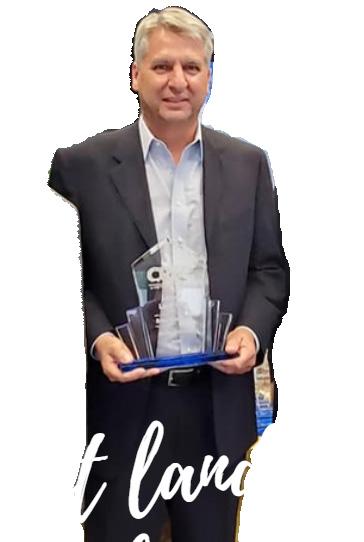


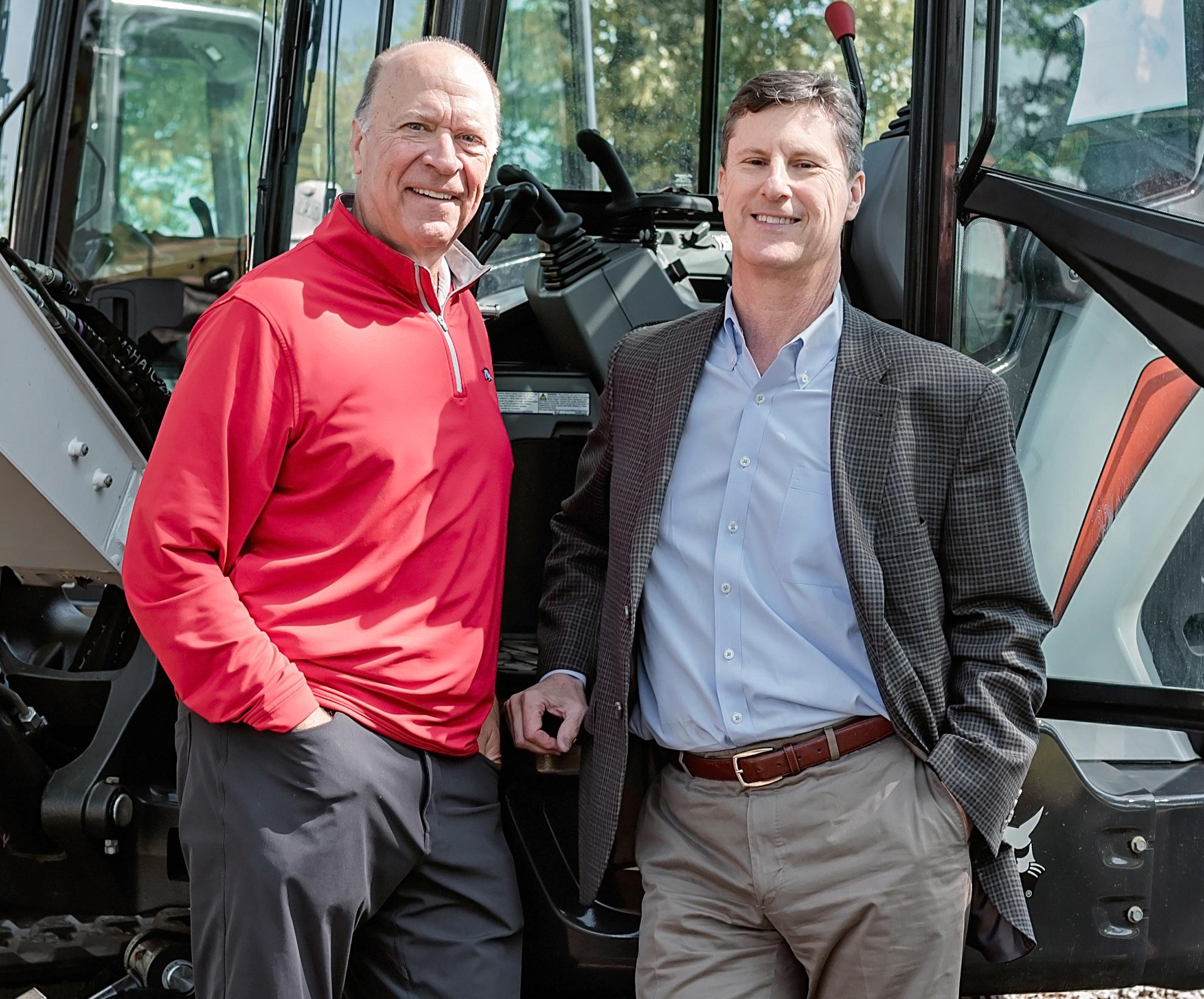 By Kenneth Heard
By Kenneth Heard
Tonka toys, those steel trucks, bulldozers and road graders, were the staples of fun for the children growing up in the 1960s and 1970s.
Kids could feel like construction workers as they dug holes, hauled stones and paved roads in their sandboxes with the yellow, sturdy vehicles.
But John Hugg pretty much skipped that stage of his youth. He didn’t have time to play with toy trucks when he was a tyke. He was too busy around the real ones.
Hugg, 64, was born in Lake Bluff, Ill., a northern suburb of Chicago. His father, Charles Hugg, worked at a forklift company in Chicago in the 1950s and 1960s. The elder Hugg worked his way up in the business from salesman to sales manager to general manager.
“Ever since I was a newborn, I’ve been around the equipment,” John Hugg said.
While seeing success in Chicago and learning important business strategies there, Charles Hugg wanted to own his own heavy equipment business.
In 1970, Charles Hugg bought a dealership in Arkansas and moved his family south.
“We pulled up roots and moved to Little Rock,” John Hugg said. “A lot of friends said he lost his mind. But we replaced the cold weather of Illinois with the warmth of the people in Arkansas.”
Back then, Hugg’s business began with stores in Little Rock and Fort Smith. John Hugg would work in the Little Rock dealership after school, sweeping, cleaning and doing any odd jobs.
Hugg also met Robert Hall, who would become his best friend, brother-in-law and partner in their business, in Little Rock.
“We’ve been friends for 50 years, worked together for 40 years and have been partners for 30,” Hugg said.
Hall joined the company in 1979 and married Hugg’s sister, Marcie. Hugg and Hall purchased the business from Hugg’s father in 1990 and named it Hugg & Hall.
Now Hugg serves as the president of Hugg & Hall, a massive business that features both equipment sales and rentals in 19 markets across Arkansas, Texas, Louisiana, Missouri and Oklahoma. They employ more than 780 people.
Hall is the vice president.
The company sells and rents equipment made by Bobcat, Crown, Doosan, Taylor and Toyota, all major manufacturers. It has Arkansas dealerships in Little Rock, Fort Smith, Jonesboro, El Dorado, Conway, Springdale and Texarkana.
Hugg & Hall’s success also comes from its long-term relationships with customers and quality of service.
In a testimonial about the business on its website, Greenwood School District Superintendent John Ciesla said he was pleased at Hugg & Hall’s reaction to providing air conditioning
for the school’s graduation.
“I was amazed at Hugg & Hall’s response to our inquiry about the possibility of air conditioning such a large facility on only a couple of days’ notice,” Ciesla wrote. “To have a crew on-site within hours to evaluate our needs and to have equipment operational in such a short time period was truly an amazing accomplishment.”
Both Hugg and Hall credit their workers for their success.
“We’ve been blessed with a lot of great people who are effective and loyal,” Hugg said.
Hall said in an interview last year with Arkansas Money and Politics, “We’ve always kept our eyes on the goal.”
“We made sure the company stayed stable, and we weren’t selfish with our money, our time or any of our assets.”
The two have made several decisions over the years that kept their business on a steady path of growth.
In 2011, they bought Arkla Taylor and began operating in Oklahoma and Louisiana. A year later, they purchased Westquip in central Oklahoma, and in 2016, they obtained RMP Service and Rentals of Houma, La.
Finally, the company acquired Southern Material Handling, which strengthened their operations in Oklahoma.
Hugg & Hall also is a unique equipment dealer in Arkansas in that it emphasizes rental equipment as well as sales. The company also provides excellent customer service and has scores of workers on the road constantly checking in with customers after sales and rentals have been made.
“We’ve seen nice, steady growth every year,” Hugg said.
While other businesses struggled during the pandemic, Hugg & Hall still thrived.
“We were considered an essential business,” Hugg said. “We were part of the supply chain. We didn’t slow down. We didn’t know what to expect and we were cautious. But we carried on and met the challenge and supported our customers.”
Hugg said there are no concrete plans for the future other than to continue what they’ve already done.
“Our goal is to keep on finding good customers,” he said. “It’s not necessarily our goal to grow, but if we do our jobs correctly, we will grow.”
It’s not necessarily our goal to grow, but if we do our jobs correctly, we will grow.
Loren “Marshall” Ipsen and his wife, Amy Ipsen, stand at the helm of Ipsen Advisor Group, a Little Rock-based team of financial professionals who believe that more is accomplished together than alone.
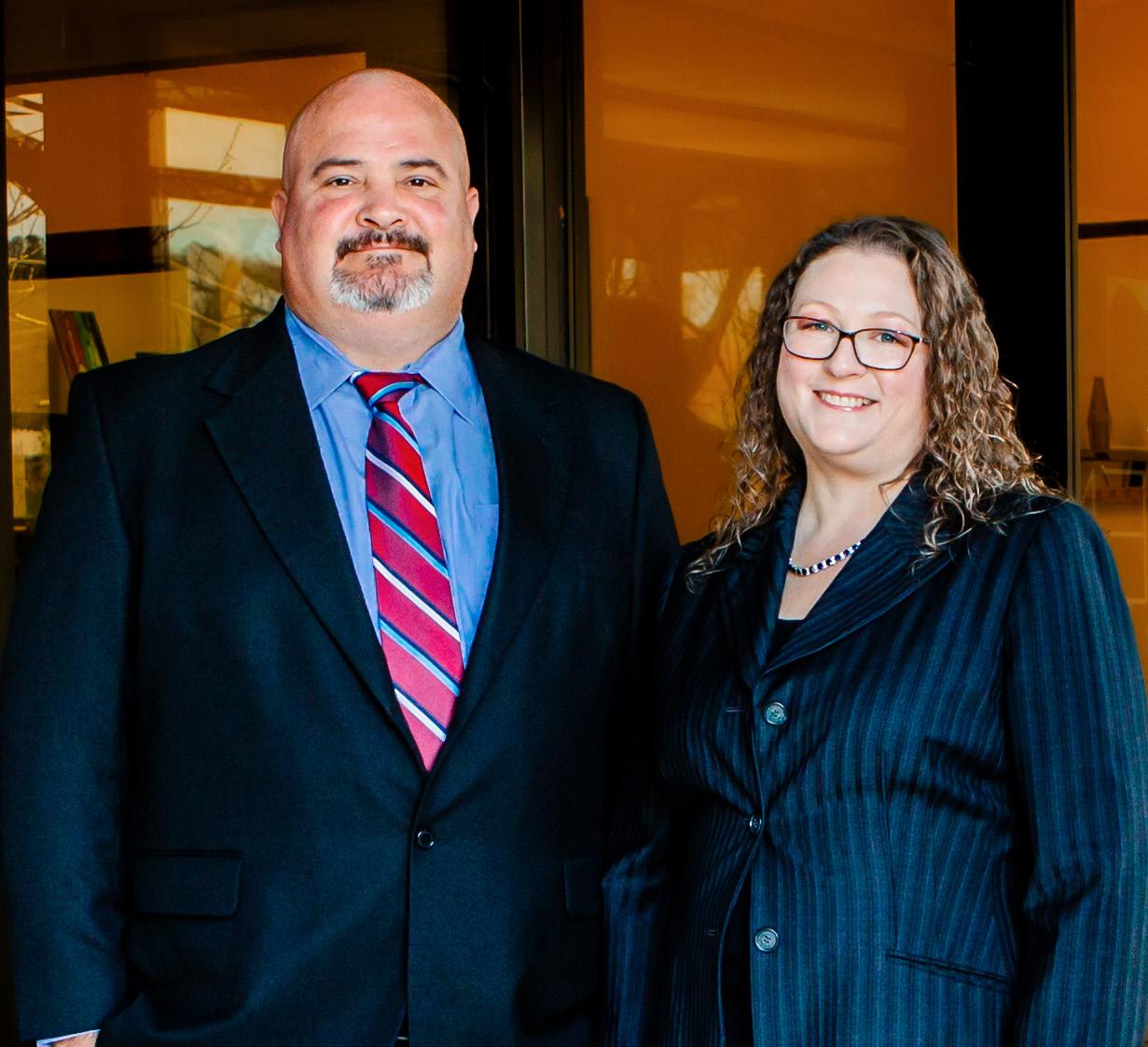
Each has been in the financial services industry for more than 20 years, the majority of that time working together. They connected in 2004 through mutual connections in the industry. Marshall ran his own Ameriprise Financial franchise from 2001 through 2020, and Amy worked at another firm in Little Rock. They were married in 2008, already raising three kids, and last year launched their own RIA, Ipsen Advisor Group.
Marshall is a Certified Financial Planner Practi-
tioner™ and is the firm’s lead advisor, Amy says. He focuses more on client relationships and investment management, specializing in working with small business owners and families looking for multigenerational planning, while she handles compliance, financial planning, client events and office administration.
“The pandemic forced us to take a long look at what we were doing, and like many, we decided the status quo wasn’t the best fit anymore. We ultimately recognized the benefits, to us and our clients, of being more independent outweighed the risks,” Amy said. “For me, the best part of working with my spouse is that our business and personal interests are aligned. We are supporting each other as we work towards the goals we have for our firm and our family.”


Brian Martin and Jonathan Lowman were both born and raised in Little Rock and became friends in fifth grade when Lowman came to Little Rock Christian Academy. From then through graduation, Lowman and Martin both shared a love for the outdoors and spent the majority of their time together fishing, hunting, shooting, camping, etc. Along with a love for the outdoors, they grew up working together on odd jobs for friends and neighbors. As die-hard Razorback fans, the duo both attended the University of Arkansas out of high school.
With a shared passion of the outdoors and firearms, the military was the logical next step for both of them. Lowman served in the Marines as an infantryman, while Martin joined the U.S. Army and served as an infantryman, as well. While serving with the 1st Infantry Division out of Fort Riley, Kan., Martin graduated from sniper school and eventually deployed to Afghanistan as part of Operation Enduring Freedom (OEF). Lowman was deployed to the Horn of Africa as part of Operation Western Accord with 3rd Battalion, 23rd Marine Infantry Division. After approximately 10 years
apart, they both found themselves back in Little Rock, and the friendship picked up where it left off.
After moving back home, both grew frustrated with the lack of shooting sports facilities in central Arkansas. Forced to drive out to public land (45 minutes) to shoot or drive another 30-45 minutes to a nearby town to get some range time, they decided to rectify the problem. In 2021, they started researching the market and visiting other ranges across the country. Not only did they find that Little Rock has a huge market gap and need for a shooting range, but they also realized that Little Rock is one of the only capital cities in the country without one. On top of that, they found that Little Rock has an ideal market for this type of business.
And thus was born Rock City Recoil (RCR). Along with military service, Martin and Lowman each have experience in startups, retail management, emergency medicine and human resources. RCR will be Little Rock’s first indoor shooting range, and the duo’s goal is to make it the first National Shooting Sports Foundation (NSSF) 5-star rated range in the state.

Rachel Morris and Susan Veasey opened Dandelion Home & Garden in Little Rock’s Hillcrest Historic District in 2021. They both come from demanding industries: Susan, a nurse, ran Baptist Health’s COVID-19 unit during the pandemic, and Rachel is an airline pilot and certified flight instructor turned successful entrepreneur. Neither is a stranger to hard work, and after just two years, their budding business venture has become an irreplaceable piece of the Hillcrest fabric.
Dandelion’s eclectic style is a mix of the couple’s personalities. Cozy decor and plants can be found in all manner of antique and unique arrangements, while the furniture consists of Susan’s family heirlooms alongside shelves and displays hand-built by Rachel. They also prioritize local vendors and creatives at every step; the shop now boasts
pieces from 37 local artists in a variety of mediums, from acrylics and oils to needlepoint and polymer clay.

The couple strongly believes in the importance of giving back, seeing Dandelion as a vehicle through which they can support a variety of causes close to their hearts. Those causes already range from animal welfare to organ donation to tackling food insecurity at local elementary schools, and Rachel and Susan aim to expand their philanthropic footprint as Dandelion grows.
In 2022, Dandelion Home & Garden was recognized as a finalist for Emerging Minority Business of the Year by the Little Rock Regional Chamber. Rachel and Susan have proven that Dandelion Home & Garden is much more than a business, however, and the pair’s success is a testament to their passion, perseverance and the power of community.
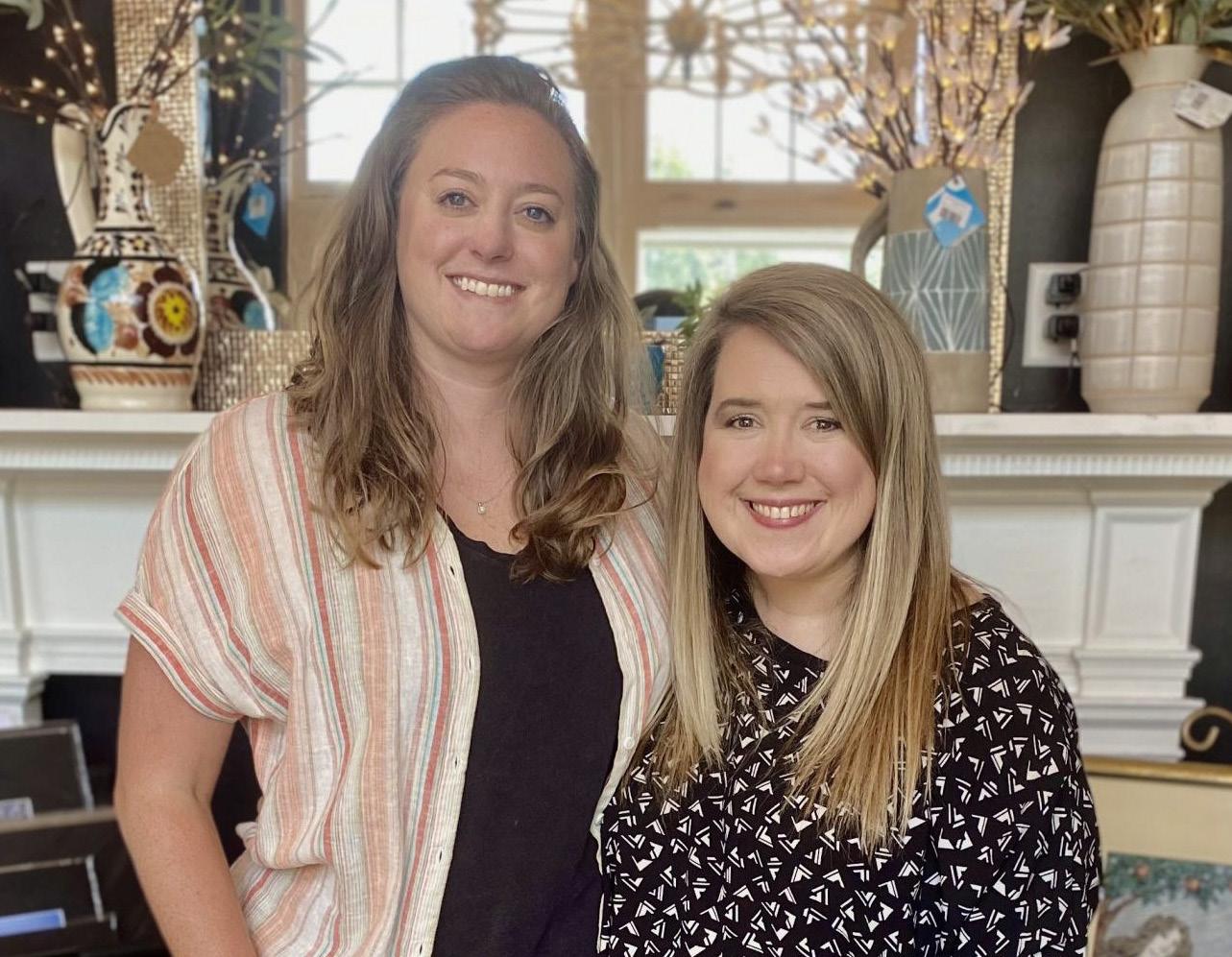
Casey and Matt Finch went from high school sweethearts who took a 15-year break to getting married and being parents to three children. Matt is president, shareholder and director with Gill Ragon Owen, P.A., while Casey is the owner of The Full Moon boutique in Little Rock’s Hillcrest district.
While Matt and Casey both attended Westminster College in Fulton, Mo., Matt came home to pursue law at the University of Arkansas at Little Rock Bowen Law School, and Casey began her retail career in St. Louis. Her family owned a department store in Fort Smith, so retail came naturally to her. Casey’s first job in high school was at The Full Moon. She would end up revisiting her roots and purchasing the store in 2013. Matt, on the other hand, has been
working at Gill Ragon Owen since 1998, representing banks and title companies.

The couple reconnected on social media and got married in 2010. The two are active in their communities and sit on the board of several charitable and nonprofit organizations. Most notably, they headed up the 2018 Southern Silks, which raised $140,000 for Methodist Family Health. Matt has also sat on the board of CARTI’s Ragin’ Cajun event and headed up the inaugural 30 Miles of Men for the Komen Foundation. Time constraints notwithstanding, the pair sees community service as essential.
“I want our children to grow up with a giving heart, and the difference that you can make in your community is important to me,” Casey said.
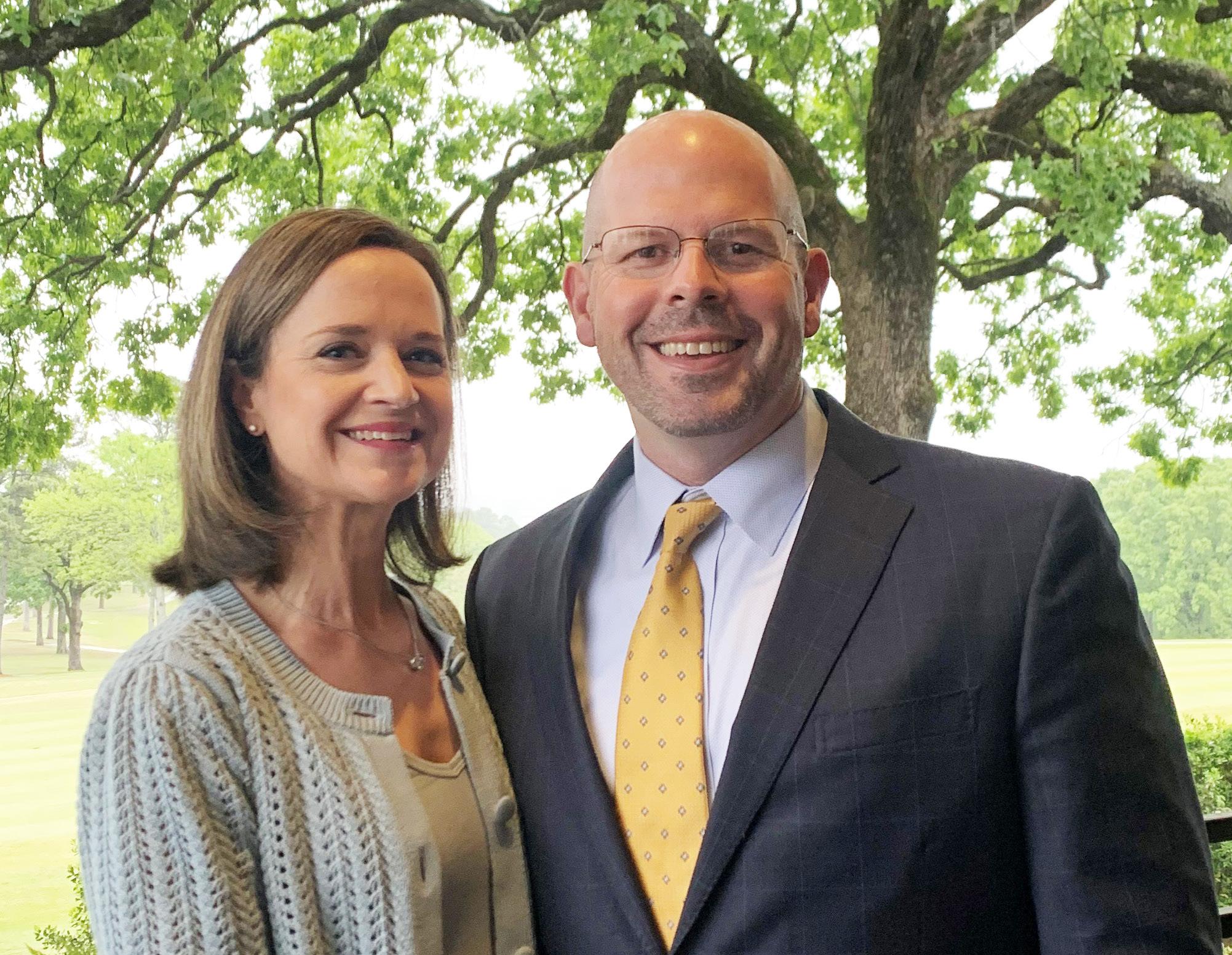
Brothers Justin and Chris Schwilling work for Edafio Technology Partners, the largest Arkansas-based managed services provider and fastestgrowing IT company in the state.

Senior systems engineer Justin is a graduate of Arkansas Tech University, where he completed his Bachelor of Science degree in computer information technology. He has been a crucial part of the Edafio team for more than 17 years, assisting clients in the health care, accounting and nonprofit sectors. In 2018, he led the Edafio team in helping Beall Barclay of NWA and Thomas & Thomas CPAs of Little Rock merge into Landmark CPAs.
Chris originally attended school to be a park ranger, earning his Bachelor of System Science in parks, recreation and leisure studies at Arkansas Tech in 2009. Since joining Edafio, he has been instrumental in helping clients adopt modern workplace solutions through Microsoft 365 and cloud capabilities. In 2021, Chris was promoted to cloud engineer and earned the Microsoft
365 Enterprise Certification Administrator Expert credential; he has led numerous migrations and adoptions of M365 solutions for clients across the region.
The Schwilling brothers’ shared history allows them to work efficiently, with each brother complementing the other’s strengths. They have collaborated on significant projects and clients, including the Arkansas Medical Society, Arkansas Surgical Hospital and the newly reopened Arkansas Museum of Fine Arts. Together, the Schwilling brothers are making a significant impact in their industry and are known for their expertise, teamwork and dedication to their clients.
Both brothers are proud Hot Springs natives. Outside of work, Chris enjoys cycling with fellow Edafio associate Carson Seelinger and regularly drums at Fellowship Bible Church campuses in Little Rock. Justin inherited his love for gardening and landscaping from his father; he also enjoys spending quality time with his wife and son, hiking, camping and being involved with his son’s cub scout troop.

Christy Vandergriff and Julie Barnett are the co-owners of Agency GWL, formerly known as GWL Advertising Inc. Agency GWL is one of Arkansas’ leading creative and marketing agencies and celebrated its 30th anniversary as a business in March of this year. Vandergriff and Barnett renamed the firm to Agency GWL — a name that better represents the full 360-degree approach to providing all services needed in a modern and evolving era of marketing and advertising.
Vandergriff and Barnett, two long-time employees of GWL Advertising, purchased the firm from founder and namesake Gary W. Lay in October 2019. Under its femaleowned leadership, the agency has experienced growth through the uncertain days of the pandemic and is continuing with the next phase of the agency’s future. Vandergriff and Barnett have quickly expanded the client base far beyond the automotive industry, which is what the company was famous for during their three decades in existence.

Additionally, the agency will be celebrating its 30-year anniversary with its new community program, “30 Acts of

Kindness.” GWL has always been focused on giving back to its community, clients and local organizations through various charitable contributions, food drives and pro-bono projects. GWL boasts more than 60 clients in over 20 different industries, spread across 18 states and with an international client based in Italy.
Vandergriff received her bachelor’s degree from Arkansas State University, where she majored in broadcast journalism with a minor in advertising. She has 19 years of creative innovation in advertising under her belt. Barnett graduated from Missouri State University and has worked at Agency GWL for 18 years.
Amy launched her career in the financial services industry in 2002. She has explored several different roles over the years, working with both clients and other financial advisors and their staff. Amy is currently putting her management, technology, and compliance experience to use as the Chief Compliance Officer and Director of Operations for the team. When not working, Amy enjoys reading, camping, entertaining at home, or relaxing on the lake with family and friends.









Corey Dunn is the director of development at Ducks Unlimited, and Erica Willard Dunn is the senior director of development in institutional advancement at University of Arkansas for Medical Sciences. An alumnus of Southern Arkansas University, Corey developed a passion for the outdoors at an early age, which led to a nearly two decades long career in conservation. As the director of development at Ducks Unlimited in Arkansas, Corey aligns donors with projects that benefit wildlife, habitat, and people.

Partnering with the Arkansas Game and Fish Commission and Arkasnas Game & Fish Foundation to restore quality habitat on public green reservoirs has been a primary focus for Corey. Driven by this collaboration, not to mention all its supporters and volunteers, the Arkansas
chapter of Ducks Unlimited is recognized nationally as a leader in wetlands conservation.
Erica has also worked to help conservation efforts across Arkansas. She has worked with the National Wild Turkey Federation as a regional director to increase net revenue and organize an active volunteer base. She has also worked with the National Rifle Association to increase net revenue by engaging volunteers and local business partnerships. Now, Erica is using her development talents and experience to help UAMS in its mission to create a healthier Arkansas and educate and train the physicians of tomorrow.
“Whether it be mallards dropping in through the timber or gobblers thundering through the woods, I can honestly say, I feel closest to God when I am surrounded by His creation,” she said.
Big Joe from Slater, Mo., needs no introduction in Arkansas. Almost 40 years following his all-star collegiate basketball career in Fayetteville, Joe Kleine is at home in The Natural State.
He met wife, Dana, while both were UA students. As Joe followed his NBA dreams with Dana (and eventually, family) in tow through seven NBA cities over 15 years, including an NBA championship run in Chicago with Michael Jordan, the Kleines always knew Little Rock would be the final stop.
Since settling down in central Arkansas, the Kleines have been active givers to their adopted community and are co-owners of two Corky’s restaurants in central Arkansas.
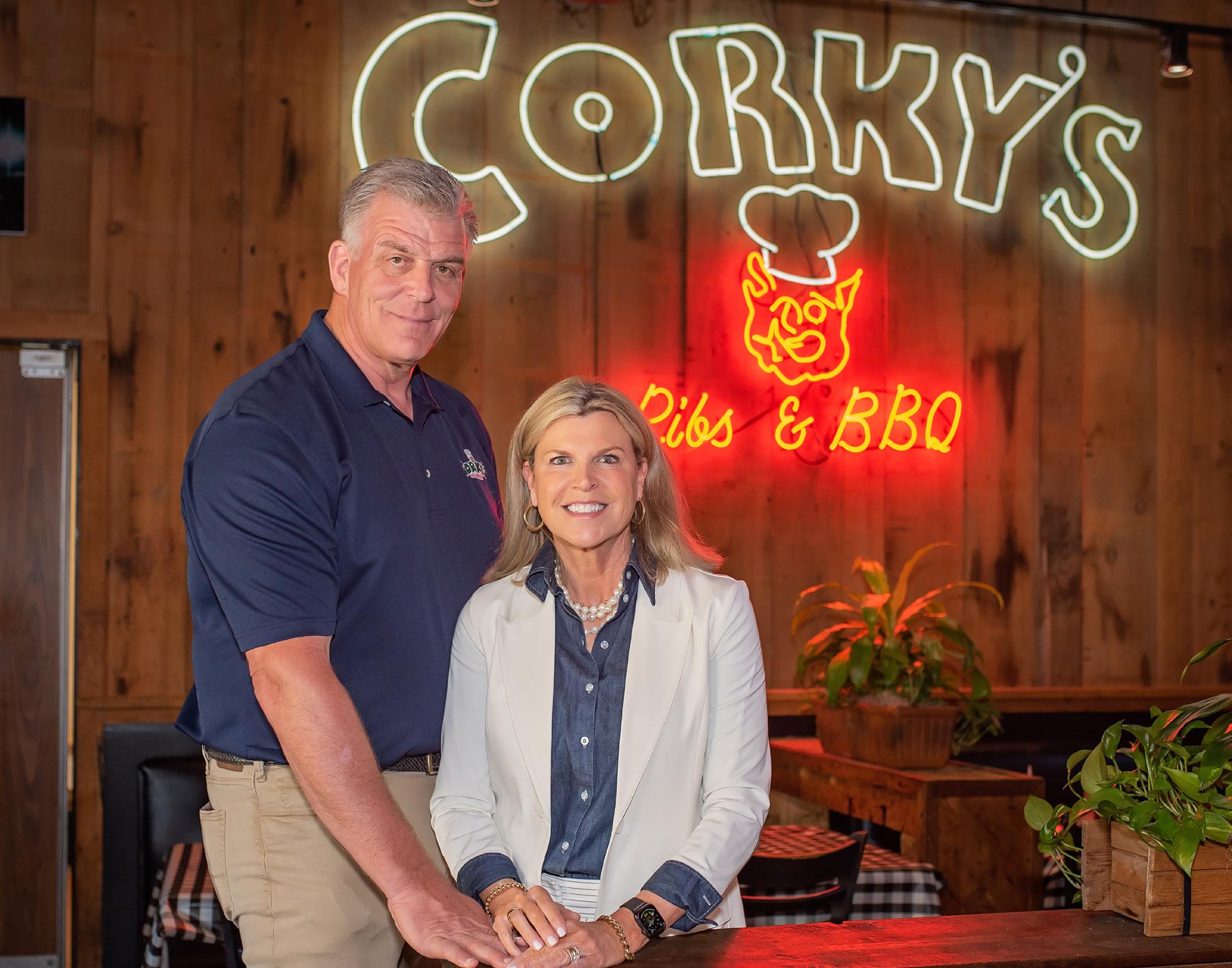
Joe has also dabbled in coaching — as an assistant at the University of Arkansas at Little Rock and as a volunteer coach at Catholic High School in Little Rock. And Dana is his biggest supporter, as well as the force that keeps him grounded.
The Kleines also have remained active in supporting the Hogs and Joe regularly appears on KATV to discuss Razorback basketball. The former 1984 Olympian and gold medal winner also provides color commentary for college basketball on ESPN and the SEC Network.
Dana is in her 10th year as a foundation trustee for the Chi Omega Fraternity and is an independent consultant at Rodan + Fields, for whom she has worked since 2012.
Though neither Dana nor Joe is originally from Arkansas — Dana was raised in Dallas — Arkansas is home.
As devout Catholics, faith is a big part of their lives. Joe once described to Arkansas Catholic the transition from the NBA to the dad life in Little Rock.
“I went from the NBA, where it was kill or be killed every night, straight into coaching a sixth-grade team at Christ the King School, where we all held hands and prayed before every game,” he said. “Needless to say, I was a little confused for a while. I was pretty intense.”



Dawn Scott is one of the most respected and trusted personalities in central Arkansas as a result of 21 years of work as a news anchor with THV11 and as a real estate agent with the Janet Jones Company. Scott spent her time at THV11 helping her community and shedding light on important stories. This community-oriented approach is apparent in her other roles as well. She is a board member of Women and Children First, Centers for Youth and Families Foundation, United Cerebral Palsy of Arkansas and Pulaski County Youth Services. She has received an adoption excellence award from the U.S. Department of Health and Human Services for helping children in
foster care find homes. She has emceed countless nonprofit galas and events, and is a devoted member of the Pulaski Heights United Methodist Church.
Donnie Van Patter is the owner of Donnie’s Foreign Car, a well-known shop that specializes in servicing foreign automobiles, in addition to domestic models. Van Patter is also active in his community, serving on boards and volunteering for multiple organizations. He has been a guest in the fundraising gala “Dancing with Our Stars” to benefit the Children’s Tumor Foundation. He also assisted with clean-up efforts in the aftermath of the tornado that impacted central Arkansas.
Debbie and Shane Broadway are an Arkansas political power couple with a legacy that began when Shane proposed at an Arkansas party on the White House lawn in 1995. He and Debbie were married under the Arkansas State Capitol rotunda in 1996, which they would walk back into two days later as Shane filed to run for a seat in the state House of Representatives.

Debbie spent more than 20 years in public service, working on the staff for Congressmen Bill Alexander, Ray Thornton and Vic Snyder, as well as Attorney General Mark Pryor. She has also worked for the Wilson and Associates law firm and the Bryant District Court. Though multiple sclerosis required an early retirement, she hasn’t let it slow or stop her from helping her community.
She has served on the boards of CASA of Saline County, the Bryant Boys and Girls Club, Saline County 4-H, the Bryant Historical Society, as well as the state and national boards of the Multiple Sclerosis Society. She founded Operation Underwear for the Bryant Rotary Club Kids Closet.
Shane, meanwhile, was elected to the Arkansas House of Representatives in 1996, where he focused on education, serv-
ing as a member of the House Education Committee and as chairman of the Southern Legislative Conference Education Committee. He was elected Speaker of the House in 2001, becoming the youngest person in Arkansas history to hold the position. When he was elected to the Arkansas Senate in 2002, Shane continued to work on legislation that improved educational opportunities for Arkansans across the state.
Shane is the vice president of governmental relations for Arkansas State University, his alma mater, and currently serves as chair of the Arkansas National Statuary Hall Steering Committee, president of the Saline County Economic Development Corporation Board of Directors and chair of the Political Animals Club of Little Rock. And perhaps most importantly to some, he’s one of the founders of the Salt Bowl, the annual tilt between neighbors and rivals Bryant High and Benton High played at War Memorial Stadium in Little Rock. The game draws in the neighborhood of 30,000 each year and has become recognized as the state’s best football rivalry game.
Together, the Broadways’ philanthropic and charitable endeavors would fill their own page.

Jena and John Selva’s story began by chance nearly three decades ago when John’s friends convinced him that a girl at his high school liked him. That wasn’t entirely true, but as fate would have it, those two ended up falling in love. After graduating from the Arkansas School for Mathematics and Sciences, the two took separate paths for education and a four-year stint in the U.S. Navy for John, but they eventually landed back in central Arkansas and were married.
John entered the real estate business after earning two business degrees and later deciding desk life was not for him. He opened his first real estate brokerage in 2007 and never looked back. Real estate was also a second career for Jena, who previously worked in health care as a registered dietitian. The couple currently owns Engel & Völkers Real Estate brokerage in Little Rock, where John serves as the principal broker and Jena serves as the CEO and director of operations while also wearing all the many different hats

required to run a company.

In 2022, they expanded beyond the original Hillcrest location to include a second location in west Little Rock. Their business continues to grow with real estate advisors serving all of central Arkansas while representing clients buying and selling residential and commercial real estate. Engel & Völkers’ extensive network across the United States and internationally also allows them to connect and serve clients beyond Arkansas.
Jena is actively involved in serving with leadership of Junior League of Little Rock, the Quapaw Quarter Association Board and with their children’s schools and PTA. John serves as a founding board member of the West Little Rock Kiwanis, Little Rock Realtors Association Board, Arkansas Realtors Association Graduate Realtors Leadership Academy and Holy Souls Mens’ Club. The couple are also avid supporters of Special Olympics and Our House, organizing and sponsoring fundraising events every year.
Kristen and Jon Kennon are the owners of iRealty Arkansas and consider themselves serial entrepreneurs. Their firm, iRealty Arkansas, is 10 years old, and has sold more than $2 billion in real estate. It is a part of Leading Real Estate Companies of the World because of its high market share in central Arkansas and is the No. 1 independent real estate company in the region.
Jon and Kristen own single family rentals, short-term rentals, commercial retail centers and are currently working on a development in southwest Little Rock. They teach their agents about building wealth through real estate and love helping others invest in real estate.
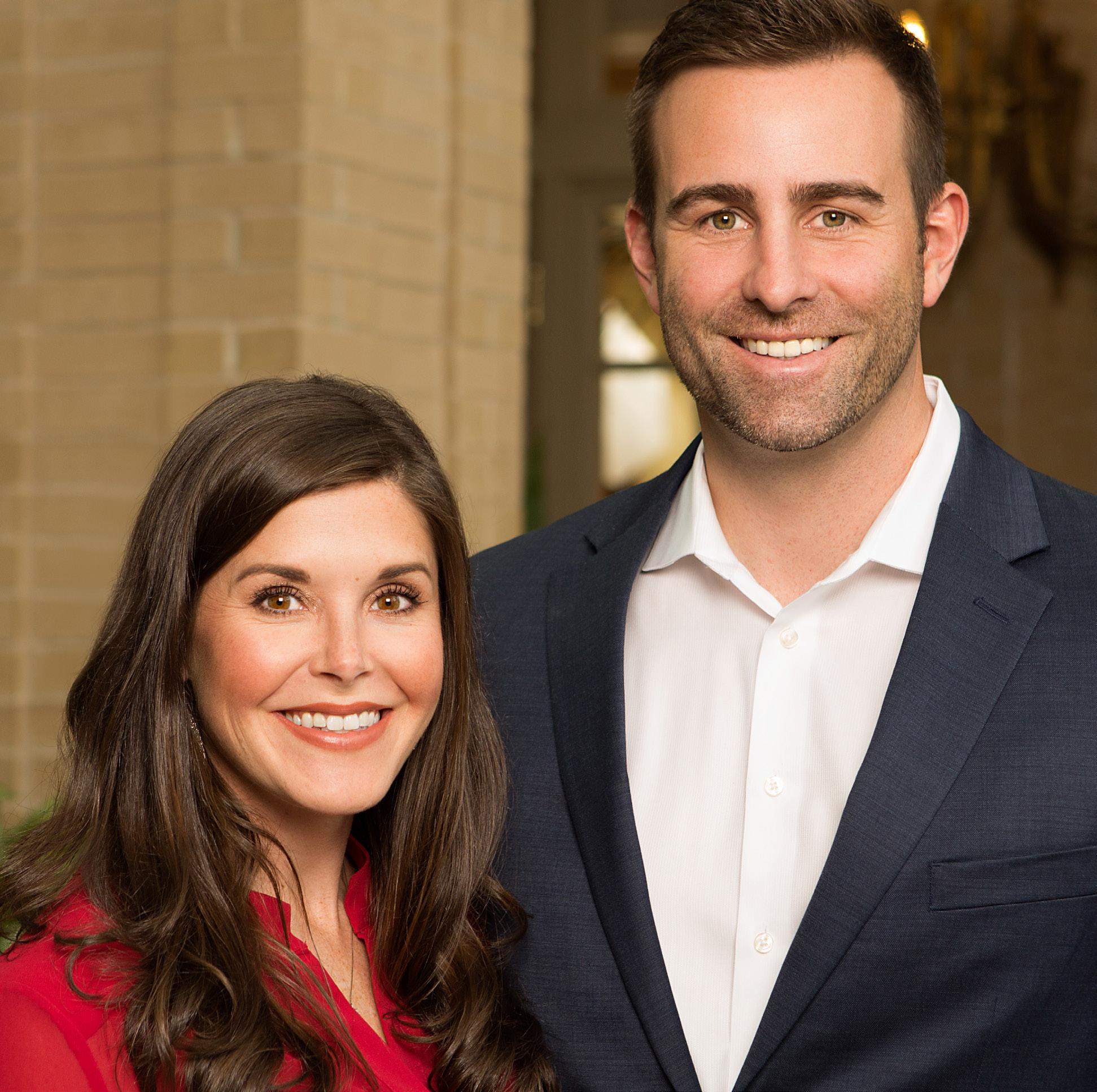
We already started that last fall and then continued the program. Jon is on the LRRA board of directors and has ownership in multiple businesses throughout central Arkansas.
Kristen graduated from Henderson State with a B.S. and M.S. in Sports Administration and was the director of parks and recreation for the City of Jacksonville for eight years before taking the leap into real estate. Jon graduated from UCA with a B.S. in Business Administration and worked his way up through Boyd Metals, leaving as the corporate sales manager to join Kristen full-time to help run this quickly growing business.

Lee Ann and Burke Jolly are the founders of Little Rockbased Jolly Bodies Fitness. Lee Ann serves as creative director and “head fitness geek,” while Burke is COO and “head jolly spreader.” Whether their clients are in the digital studio or the JB Lab, the unique Jolly Bodies method uses “edutainment” (education and entertainment) to provide a positive exercise experience for both body and mind.
Jolly Bodies was born as a Facebook fitness group in 2016 before becoming a full-fledged business in 2020. Lee Ann earned her bachelor’s in biology at the University of Arkansas, where she began teaching group fitness classes her sophomore year. She went on to obtain a Ph.D. in physiology at the University of Arkansas for Medical Sciences and certification from the National

Academy of Sports Medicine. She brings that expertise to bear in each area of the Jolly Bodies curriculum, which focuses on building muscle, moderate- and high-intensity cardio and mobility work. Jolly Bodies serves clients in more than 20 states as well as internationally.
While Lee Ann is the “dreamer, imagination and science side” of Jolly Bodies, Burke is an extrovert responsible for creating a culture of “unadulterated joy.” From the front desk to the studio and everywhere in between, Burke can be found bouncing around, fostering the many relationships that are the bedrock of Jolly Bodies Fitness. Together, the energetic pair make Jolly Bodies live up to its claim to be “the happiest workout place on earth.”

Mike Kirby and Ron Carter are co-owners of Made in the Shade Little Rock, a custom window treatment business with options for blinds, shades, shutters and more.

Kirby is a Service-Disabled & Veteran-Owned Small Business owner who began his career in home construction by flipping homes between overseas deployments with the United States Air Force over a 25year military career. He came to Made in the Shade after retiring as director of the Air Force’s largest Air Operation Center, and his experience with home interiors made the business a natural fit.
Carter is an experienced interior-design professional with 25 years of experience and credentials. He holds bachelor’s degrees in psychology and sociology from Louisiana State University at Shreveport, and has developed an extensive portfolio, which includes whole house renovations, kitchen remodels and high-
end personal consultations.

Together, the two owners offer complementary perspectives on every project. Kirby provides the practical installation point of view while Carter gives an expert design perspective. Both Kirby and Carter were drawn to the Made in the Shade team because they wanted the support and structure of a franchise while also feeling like they were truly in charge of their own business and destiny. Made in the Shade provided the best fit for freedom, support and the structure that they felt would ensure their success.
The duo shares similar personal interests and hobbies. Kirby enjoys home improvement projects, landscaping, live music, directing air shows and personal fitness. Carte also enjoys landscaping, personal fitness and dining at great restaurants. He is a die-hard college sports fan, particularly for his favorite team, the Arkansas Razorbacks.
When Rainwater, Holt and Sexton was formed in 2006, there was not a dynamic duo of Mike Rainwater and Bob Sexton but rather, a trio with late partner Stephen Holt. The three attorneys started what has become the largest plaintiff law firm in Arkansas. Holt passed away in 2014, but Rainwater and Sexton kept the momentum going and continued to grow the firm into one of the most prominent in the state.

When founded, the firm consisted of a handful of attorneys and support staff. Today, Rainwater, Holt and Sexton has grown to 38 attorneys, more than 150 support staff and eight locations across the state, serving a variety of legal needs including personal injury, workers compensation, Social Security disability and nursing-home abuse claims.
Both Rainwater and Sexton are Arkansas natives and share a passion for the state and its people, shown through their commitment to providing top notch legal representation.
“Everything we do is all about putting clients first,” Rainwater said. “That is the foundation of the firm. We

know if we put our clients first, then everything else will take care of itself.”
As the firm grew, more opportunities presented themselves. These opportunities included adding practice areas, hiring more experienced lawyers and paralegals, opportunities to support the community and opportunities to work on complex cases such as the current sex trafficking lawsuits the firm is litigating.
Serving the community has become a major part of the firm ethos as well, evidenced through longstanding partnerships with organizations like ALS Arkansas and Central Arkansas FCA and supporting employee causes. Over the last seven years, the firm has contributed to more than 175 local organizations as a part of these giving programs.
Working to improve the community is not just happening through donations, it’s also something that’s accomplished through the law. Rainwater, Holt and Sexton is a pioneer in Arkansas sex trafficking litigation with a goal of shutting down hotels and other businesses that allow sex trafficking on their premises.

Robert Eason and Kevin Keen are two of the most notable faces when it comes to real estate and land management at Mossy Oak Properties. Eason is the principal broker and owner of Delta Land Management Mossy Oak Properties, and Keen is the executive broker.

Licensed in Arkansas, Eason started as an agent in 2009, soon after he graduated from the University of Arkansas Dale Bumpers School of Agriculture. Eason is active in both real estate sales and farm management for the company. He has listed and sold everything from cabins on Maddox Bay to large row crop farms and premier hunting properties across the state.
Before 2009, Eason worked as a waterfowl guide for over 10 years and has a great knowledge of waterfowl and their seasonal migrations through the state. His lifelong passion and diverse knowledge of the outdoors make him a huge asset to anyone looking
to purchase a property in the natural state. Although he spends as much time possible at the family farm in Monroe County, Eason currently resides outside of Conway with his wife, Brandy, and their two children. He served on the Arkansas Board of Directors for the National Wild Turkey Federation from 2012-2019. He is a Life member of NWTF and Ducks Unlimited and is an active member of Quail Unlimited and the Rocky Mountain Elk Foundation.
Keen is best known by his family and friends as one who loves the outdoors and can never spend too much time outside hunting and fishing. He has row-cropped, raised livestock and been an educator for the Arkansas Game and Fish Commission. His agricultural experience, in addition to a B.S. in wildlife ecology/management and a master’s in biology, gives him the insight into what it takes to operate a farm and manage habitat to reach its full wildlife potential.







Scott Schlesinger, MD, founded Legacy Spine & Neurological Specialists along with former partners Ray Jouett, MD, and Ronald Williams, MD, two pioneers of neurological surgery. Today, Schlesinger and fellow surgeon Dominic Maggio, MD, continue to set the standard in Arkansas for specialized and comprehensive care of the brain, spine and peripheral nerves.
An Arkansas native with decades of experience, Schlesinger specializes in minimally invasive spine surgery. He obtained his medical degree from the University of Arkansas for Medical Sciences in Little Rock. After his neurosurgery residency and general surgery internship at the University of Texas Health Sciences Center in Dallas, Schlesinger went on to complete a fellowship at Centre Hospitalier Universitaire Vaudois in Lausanne, Switzerland. He is certified with the American Board of Neurological Surgery and is nationally renowned as the co-developer of one of today’s most advanced micro-spine surgeries, the VariLift procedure.
Maggio is a Miami, Fla., native, where he attended high school, college, business school and medical school before completing his neurosurgery residency at the University of Virginia-National Institutes of Health. He went on to complete a fellowship in comprehensive spine surgery at Ohio State Wexner Medical Center before moving to Little Rock. Maggio has published more than 30 scientific papers and has won numerous national awards. He performs innovative, first-in-Arkansas surgical techniques such as si joint fusions, cervical- and lumbar-artificial disc replacements. His memberships include the American Association of Neurological Surgeons, the Congress of Neurological Surgeons and the American Medical Association.
Maggio and Schlesinger lead the nation in the development and advancement of computer and image-guided micro spine surgery. The pair delivers life-changing, minimally invasive neurosurgical care at one of the most established practices in the state, with a combined 80 years of experience providing highly-conservative neurological care.


Dr. Alonzo Williams has served as the medical director for Arkansas Diagnostic Center in Little Rock for more than 25 years. Throughout that time, he has been diligent in pursuing the latest gastroenterology research and techniques in order to ensure excellent care for every patient.
The West Helena native and Arkansas State University graduate serves as a gastroenterology consultant for hospitals throughout Little Rock. Since 1984, he has been affiliated with major health care systems such as Baptist Health, CHI St. Vincent, UAMS and of course, Arkansas Diagnostic Center and Kanis Endoscopy Center. An active member of many local professional organizations, Alonzo has been appointed by three gover-
nors to terms on the Arkansas State Medical Board for 25 consecutive years.
His wife, Susan Holley Williams, is a renowned Little Rock artist and a native of Chicago whose preferred medium is bronze sculpture. She is a graduate of the University of Arkansas.
She has served as director of special projects for the Arkansas Diagnostics Center and Associated Properties, on the board of trustees for the former Arkansas Arts Center and was appointed to the Arkansas Humanities Council by Gov. Mike Beebe. Both she and her husband are active in raising scholarship funds for minority students in various fields of health care and serve on the board of directors of the Tidwell Project in Little Rock.

When it comes to athletic power couples in Arkansas, Hunter and Tara Woodhall, married last fall, are among the first to come to mind.

When he was an infant, Hunter had both legs amputated as a result of a rare congenital disability which caused part of his fibula bones to be missing. Doctors told his parents that he would likely never walk, so he learned to run instead. Hunter became the first double-amputee track and field athlete to earn a Division I athletic scholarship, which he accepted at the University of Arkansas. He competed against able-bodied runners in the SEC before going on to compete in the Paralympics. He is a two-time
Paralympian and three-time Paralympic medalist.

Tara Woodhall is an accomplished American track and field athlete and the American junior record holder for the indoor long jump. After breaking records at the University of Georgia, she transferred to the University of Texas, where she set more collegiate records. She qualified for the 2020 Summer Olympics and placed sixth in the women’s long jump Olympic final.
Based out of and training for their professional careers in Fayetteville, Tara and Hunter are influencers and ambassadors for major brands on social media. Plus, the Woodhalls have announced plans to build a training facility in Fayetteville.
The sons of legendary Arkansas restaurateur Jim Keet, Tommy and Jake Keet, are not only brothers and friends but also partners in the JTJ Restaurants LLC. Tommy serves as president of JTJ Restaurants LLC and is a partner in Petit and Keet, Bar and Grill and Cypress Social LLC. Tommy serves as vice president of JTJ Oklahoma Restaurants LLC in addition to his role as vice president and COO of JTJ Restaurants LLC. Tommy and Jake are also partners in Waldo’s Chicken and Beer, with one location in Tulsa and two in central Arkansas. Tommy has also partnered with Count Porkula to open two locations in greater Little Rock.

JTJ Restaurants has brought The Natural State several quality eateries, including eight locations of Taziki’s Mediterranean Cafe, Petit and Keet and Cypress Social. In addition to the Arkansas locations of Taziki’s, the Keet’s also
operate two locations in Oklahoma.
With a legal background, Tommy graduated from Hendrix College in 1998 and the University of Arkansas at Little Rock William H. Bowen Law School in 2003. He made the decision to quit practicing law until 2008 when he began to work on opening the first Taziki’s in Arkansas with his partners, Jim and Jake.
In 2021, the Keet duo was both recognized in AY About You’s Men of Distinction.
Outside of the restaurant industry, Tommy is active in the community and supports numerous charitable endeavors and is the past president of The Hat Club, which was formed to support a variety of local charities in 2010 and has raised more than $1 million for local charities. Jake is also involved in several civic and charitable endeavors through his role in Taziki’s.

Family is big in Arkansas, and it stands to reason that family businesses are, as well.
Generational businesses are the backbone of business in the Natural State, and while we don’t claim to have a comprehensive list of every family operation out there, we nevertheless can shine a spotlight on some of the state’s prominent family-run stores, companies and firms.
Arkansas Money & Politics is proud to once again recognize generational businesses in Arkansas.
Ace Glass Construction Corporation
Windows/Glass, Little Rock
Agency GWL
Advertising, Little Rock
Agency GWL, formerly GWL Advertising, is one of Arkansas’ leading creative and marketing agencies. The company celebrated its 30th year in business in March of this year, when it unveiled its updated name and logo.

Co-owners Christy Vandergriff and Julie Barnett, two long-time employees of GWL Advertising, purchased the firm from founder and namesake Gary W. Lay in October of 2019. As president and vice president respectively, Vandergriff and Barnett have spearheaded the growth of GWL into a full-service agency with over 58 clients in 14 industries across 18 states and Europe
Akel’s Carpet One
Carpet/Flooring, Little Rock
Albright Ideas
Advertising, Little Rock
Alford’s Carpet One
Floor & Home Decor, Fort Smith
Anthony Timberlands
Wood Supplier, Malvern
Arkansas Graphics Inc.
Printing, Little Rock
Arkansas Mailing Services
Mailing Services
North Little Rock
Bank of England
Banking, England
Bell & Company
Accounting Firm, North Little Rock
him got into some trouble and was run out of town. In his absence, Blackmon conducted the auction that night, and the rest is history.
In the ῾60s, Tom Blackmon Sr. took over the business, expanding it from a seasonal operation to a full-time business selling farm equipment and adding construction equipment and eventually trucking, logging, railroad and manufacturing equipment. Under his leadership, Blackmon Auctions evolved from a regional business to a full-blown auction company. Blackmon’s son Thomas has led the company since 2010 and added real estate to the Blackmon portfolio.
Blackmon Auctions provides more than 80 years in the industry, an average of 70 auctions a year, and employees who average 15 years of service.

Blakeman’s Fine Jewelry
Jewelry, Rogers
Bray Sheet Metal
Sheet Metal, Little Rock
Brown Boys Roofing
Home Improvement, Bentonville
Bruno’s Little Italy
Restaurant, Little Rock
Cavender’s Seasoning
Culinary, Harrison
CBM Construction
Construction, Little Rock
CC Jones Produce Trucking
Trucking, North Little Rock
Chi’s Chinese Cuisine
Restaurant, Little Rock
Clark Machinery Company
Construction Services, Fort Smith
Cogswell Motors
Auto Dealership, Russellville
Cooper Family Dentistry
Dental, Jacksonville
Coulson Oil Company
Petroleum Distribution
North Little Rock
Coy’s Southern Eats
Curry’s Termite and Pest Control
Pest Control, Little Rock
CustomXM
Printing/Promotional
North Little Rock
Daniel Orthodontics
Dental, Little Rock
DASH Heating and Cooling
HVAC, Little Rock
DataPath Inc.
Employee Benefits/Tech
Little Rock
David’s Burgers
Restaurant, Conway
Diamond Center Jewelers
Jewelry, Fayetteville
Dillard’s
Clothing, Little Rock
DJ’s Auto Repair
Auto Repair, North Little Rock
Doe’s Eat Place

Restaurant, Little Rock
Doe’s Eat Place originated, of course, in Greenville, Mississippi. George Eldridge, a restaurateur and hobby pilot from east Arkansas, had been flying friends and clients to Greenville for steaks at Doe’s for years. Eventually, he decided to “bring the mountain to Mohammed” and contracted the right to bring the name and menu to Little Rock.
Opened in 1988, Doe’s Little Rock maintains the no-frills tradition of the original and has achieved its own renown as a regional national favorite. All manner of prominent figures – political, celebrity or otherwise – have frequented the storied establishment, and today the restaurant remains a go-to spot for a variety of groups, causes and events.
Doe’s remains family-owned and operated. George’s daughter, Katherine Eldridge, assumed ownership in 2012 and is proudly continuing the Doe’s tradition.
Auctioneer, Little Rock
The first-ever Blackmon auction was conducted in 1938 by founder Eddie Blackmon Sr.
The story goes that Blackmon owned part interest in a cattle barn in DeWitt, but the auctioneer who was working for
Culinary, Hot Springs
Cozy Cavern Storm Shelters
Emergency Prep, Austin
Crews and Associates
Banking, Little Rock
Crow Burlingame
Auto Parts, Little Rock
Don’s Supply
Restaurant Supply, Little Rock
Duffield Gravel Co.
Quarrying, Mineral Mining
Russellville
EC Barton & Company
Retail, Jonesboro
The Faded Rose Restaurant, Little Rock
Feltner’s Whatta-Burger Restaurant, Russellville
Ferstl Valuation Services
Real Estate Appraisal, Little Rock
First Arkansas Bank & Trust Banking, Jacksonville
First Arkansas Bank & Trust is a family owned and locally managed bank with 21 locations in central and north central Arkansas. Since its inception in 1949, FAB&T has been deeply committed to serving the financial needs of the customers of the area, and even more deeply committed to investing time and resources into the communities which it serves.
FAB&T was originally founded as Jacksonville State Bank by Kenneth Pat Wilson and a small group of investors. Today, Wilson’s son, Larry, serves as chairman of the board and CEO, while his grandson, Mark, is president and COO.

FAB&T proudly boasts the ability to offer seven-day-a-week banking with QūB, an interactive teller machine, which provides live customer support with extended banking and service hours. FAB&T also provides live, local customer call center support on a 24/7 basis, to provide customers with the convenience they need and deserve.
First Security Bank Banking, North Little Rock
and the building’s fort-like appearance.
Now in Sherwood with almost 30,000 square feet of retail space, Fort Thompson has become one of Arkansas’ most iconic hunting-related sporting goods stores.
Freyaldenhoven Heating & Cooling
HVAC, Conway
Fuller & Son Hardware
Hardware, Little Rock
Garrett Excavating Construction Services, Benton
Gaston’s White River Resort Resort, Lakeview
Generations Bank
Banking, Fayetteville
George’s Chicken
Food Manufacturing, Springdale
Graham Hardware
Hardware, Wynne
Grandeur Fasteners Inc.
Manufacturing, Danville
Gwatney Chevrolet Company
Car Dealership, Jacksonville
Harp’s Food Stores
Grocery, Springdale
Harrell Bancshares
Banking, Camden
Hathaway Group

Real Estate, Little Rock
Hopkins Orthodontics
Orthodontics, Searcy
Fort Thompson Sporting Goods Sporting Goods, Sherwood
Fort Thompson’s roots go back to 1931 when C.B. Thompson opened a grocery and hardware store in North Little Rock, and sold guns and ammunition out of the back storeroom.
Eventually, C.B. Thompson Jr. took over, and the store evolved into Thompson’s Super Market. The sporting goods side of the business split off in 1985, and a new log building was built across the street from the grocery store.
The new business became Fort Thompson Sporting Goods, with the name paying homage to C.B. Thompson
Hugg & Hall
Equipment Rental, Little Rock
Hugg & Hall Equipment Company was originally formed in Arkansas in 1956 as Lift Truck Sales & Service Corporation. The company was a distributor for Clark Equipment Co., a manufacturer of industrial forklifts.

Charles Hugg purchased the company in 1970, operating from two locations, Little Rock and Fort Smith. Hugg’s son John purchased the firm in 1990 alongside Robert Hall, who joined the company in 1979. Starting out with only 22 employees, Hugg & Hall has grown to become one of the largest in the South,
operating out of 12 locations with more than 750 employees.
While most of the competition focuses on just one brand or one segment of the market, Hugg & Hall has been given the opportunity to represent several major manufacturers. Hugg & Hall offers fullservice rental for those brands, as well as many more products, making it the go-to, one-stop-shopping option for its wide customer base.
Hum’s Hardware and Rental
Construction Services
North Little Rock
Humphrey Funeral Service
Funeral Home, Russellville
Innerplan Office Interiors
Office Interiors, North Little Rock
Iriana’s Pizza
Restaurant, Little Rock
K Hall & Sons Produce
Grocery, Little Rock
Keith Smith Company
Egg Distribution, Hot Springs
Kitchens Pediatric Dentistry
Pediatric Dentists, Little Rock
Kittle’s Garage
Automobile, North Little Rock
Leonard’s Hardware
Hardware, Russellville
Lewis Ford Sales Inc.
Car Dealership, Fayetteville
Lexicon
Construction, Little Rock
The late Tom Schueck founded what was to become Lexicon, Inc., in his Little Rock garage in 1968 with $200 in the bank and a pregnant wife at home. Thanks to his family’s dedication to “Building America,” Lexicon has grown into one of the nation’s leading fabrication and construction companies with more than 2,000 employees. On March 3, 2020, Schueck passed away at age 78. He was the chairman of Lexicon.
Today, under the guidance of President and CEO Patrick Schueck, the Lexicon family of companies combines a commitment to excellence with cuttingedge robotic technology, safety and superior craftsmanship to complete iconic steel fabrication, construction, energy,





From Kenneth Pat Wilson in 1949 to Larry Wilson and Mark Wilson today, family has been the foundation of FAB&T. We continue to be family-led and focused on making banking easier for you and your family.


With 24 hour customer service, 7-day-a-week banking and a variety of personal and business solutions, FAB&T is the perfect bank for your unique financial needs.

industrial, commercial and public projects. Those companies include Custom Metals, Heritage Links, Lexicon Energy Services, Lexicon Fabricators and Constructors, Lexicon Industrial Contractors, Prospect Steel and Steel Fabricators of Monroe.
Lift Truck Service Center
Heavy Equipment, Little Rock
Lindsey’s Hospitality House
Restaurant, North Little Rock
Maple Leaf Awning and Canvas
Outdoor, Sherwood
Martinous Oriental Rug Company
Decor, Little Rock
Mays, Byrd & O’Guinn PLLC
Legal, Little Rock
McCauley Services
Pest Control/Electrical, Bryant
McClendon’s Appliance
Repair, Benton
Meyers Supply and Chemical
Janitorial Equipment Supplier
Hot Springs
Miller’s Drug Store
Pharmacy, Malvern
Moon Distributors
Distribution, Little Rock
themselves, staff members understand their clients’ goals.
Nabholz
Construction, Little Rock
National Custom Hollow Metal
Doors & Frames
Hardware, Little Rock
partment of Transportation and is completely insured, covering bank transit, medical deliveries, electronics and general cargo. The company’s 25,000-squarefoot warehouse also accommodates mailing, warehousing and distribution services. Handling small, medium and large deliveries, both standard and rush, Parrish Delivery prides itself on being more than just an on-call service.
Peneprime of Arkansas
Asphalt, Little Rock
The professionals at Mossy Oak Properties/Delta Land Management Company have been the leading real estate brokers of farmland, hunting properties and natural places since 2005. It is a family owned-and-operated business with agents throughout Arkansas ready to help buy or sell timberland in the Ozarks, the family farm or a hunting property in the Delta.

Its agents are trained in all aspects of rural real estate and have the equipment and expertise to effectively help you buy or sell. The firm’s management team includes wildlife and farm managers who can help take property to the next level. As landowners and hunters
Network Services Group

IT/Telecommunications, North Little Rock
Network Services Group got its start in 1989 as an outgrowth of a telecommunications consulting firm. From the start, NSG has been committed to delivering quality products and service – a focus that hasn’t changed in more than three decades, even as the technology and systems they work with have evolved at a rapid clip.
Ryan Flynn was named president of Network Services Group in 2013 after 15 years with the company. In the decade since, NSG has grown from 11 employees and a single location in North Little Rock to more than 65 employees and three locations in Arkansas.
From installation to support for phone systems, computer networks and a variety of services in between, customers trust NSG to deliver incredible outcomes. NSG serves thousands of customers in Arkansas, including banks, medical firms, lawyers, staffing agencies, manufacturers, car dealerships and service companies.
Oaklawn Racing Casino Resort
Entertainment, Hot Springs
Peters Family Living
Furniture, Russellville
Pettus Office Products
Office Supplies, Little Rock
Phelan Orthodontics
Orthodontics, Little Rock
Phil Wright Autoplex
Auto Dealership, Russellville
Pine Bluff Sand and Gravel
Construction Services, White Hall
Poe Travel
Travel, Little Rock
Power Technology Inc.
Lasers, Alexander
Ranalli Farms
Grocery, Farm Equipment, Feed
Springdale
Red River Auto Group
Auto Dealership, Jacksonville
Refrigeration and Electric
Supply Co.
Hardware, Little Rock
Richards Honda Yamaha
Automotive, Little Rock
Riggs CAT Heavy Equipment
Dealer
Heavy Equipment, Little Rock
Ritter Communications
Telecommunications, Searcy
Roller Funeral Homes
Funeral Home, Little Rock
Parrish Delivery Services
Mail/Courier, Little Rock
Family-owned and operated since 1991, Parrish Delivery Services has provided over three decades of expert service thanks to the professionalism, dedication and hard work of owner Gary Parrish and his staff.
Parrish Delivery Services provides courier services throughout Arkansas and nationwide, is licensed by the De-

Russell Chevrolet and Honda
Automotive Dealership
Sherwood
The history of Russell Chevrolet began in the 1950s, when founder John

Although banking has been a male-dominated industry historically, women are breaking the glass ceiling and rising to the top. AMP wants to feature the women in banking in our state with expertise, professional achievements and personal tenacity to succeed. Please nominate a woman in the banking industry who is a leader and making a significant contribution to her profession. She must work within an organization primarily focused on retail or commercial banking.

NOMINATE YOUR FAVORITES HERE: armoneyandpolitics.com/nominations






Russell went to work as a general sales manager at Critz Chevrolet Co. Russell eventually bought the dealership from John M. Critz, establishing Russell Chevrolet in 1963. His sons, Bob and Rick, started working for the company. Russell opened the first Honda dealership in Arkansas in 1972. After John’s retirement, Bob took over the Chevrolet dealership, and Rick assumed control of the Honda dealership.
The third-generation of Russells still runs those dealerships. Brett, Bob’s son, leads Russell Chevrolet, and Jarrod, Rick’s son, runs Russell Honda. Today, Russell Chevrolet has the largest selection of new Chevrolet vehicles in Arkansas and ranks as one of the 200 largest Chevrolet dealers in the nation. Russell Chevrolet also has the largest GM parts department in the state, and its fleet of vehicles delivers to body shops and other dealerships daily.
Simmons Foods
Manufacturing, Siloam Springs
Smith North Little Rock
Funeral Home
Funeral Home, North Little Rock
Sol Alman Company
Recycling, Little Rock
Sportstop Inc.
Sports Apparel, Little Rock
Star Bolt Inc.
Fasteners, North Little Rock
Stephens Inc.

Finance, Little Rock
Stephens is a leading family-owned investment firm comprising the businesses of investment banking, advisory, sales and trading, research, insurance and wealth management. Stephens’ U.S. operations are headquartered in Little Rock with additional locations in strategic domestic markets and a European presence in England and Germany.
Howard, who assumed the role of president from his father, Joe, in 1984.
Tipton & Hurst was built on a foundation of family: It puts its name on everything it does, working to make sure that every plant, flower, gift and interaction meet the Tipton & Hurst standard of excellence. With an award-winning team and vast resources, including a wholesale warehouse and a network of premier suppliers around the world, Tipton & Hurst continues to lead the market, with locations in Little Rock, North Little Rock, Conway and Pine Bluff.
Triple S Alarm Company
Security, Little Rock
Tyson Foods

Food, North Little Rock
Underwood’s Fine Jewelers
Jewelry, Fayetteville
Venesian Inn
Restaurant, Tontitown
War Eagle Boats
In 1970, Sissy Jones began renting an old log cabin off U.S. Highway 79 in Pine Bluff. In the over half a century since, family-owned and -operated Sissy’s Log Cabin has been renowned for its exemplary customer service and extraordinary selection of fine jewelry and antiques. Today, Sissy’s has evolved into the Mid-South’s largest family owned jewelry store, with showrooms in Pine Bluff, Little Rock, West Little Rock, Jonesboro, Conway and Memphis.
Under the direction of three generations of Jones family members, each store offers the renowned “Sissy’s Experience,” as customers browse curated collections of timepieces, diamond jewelry, estate jewelry and fine gifts. With a deep respect for founder and matriarch Sissy Jones’ vision – and her reminder that “the customer is always right” engraved on a plaque at the entrance of each store – son Bill and family are charting the course for what’s next.
Smith FordAutomotive, Conway
W.R. “Witt” Stephens founded the company in 1933 and was joined by his brother, Jackson T. “Jack” Stephens, in 1946. Jack became president of the company in 1956; his son, Warren, was named president and CEO in 1986, and chairman in 2005.
Stephens is committed to building long-term value for corporations, state and local governments, financial institutions and institutional and individual investors. Stephens’ affiliates include: Stephens Inc. (offers securities products; member NYSE SIPC), Stephens Investment Management Group, Stephens Insurance LLC, Stephens Capital Partners LLC and Stephens Europe Limited.
T&S Sawmill
Lumber Products, Clarendon
Aluminum Boat Manufacturing
Monticello
Wardlaw Orthodontics
Orthodontics, Little Rock
Warren’s Shoes
Women’s Shoes, Paris
Welsco Inc.
Welding, Little Rock
Whisinvest Realty
Commercial Real Estate
Little Rock
WT Equipment
Farm/Outdoor Equipment
Fayetteville
Wilson Law Group

Legal, Little Rock
Wilson Real Estate Auctioneers
Auctioneer, Hot Springs
Wooley Auctioneers
Auctioneer, Little Rock
WWW/AFCO Steel Inc.
Construction Steel Fabrication
Tipton & Hurst
Floral, Little Rock
Truly one of the state’s iconic businesses, Tipton & Hurst has evolved and innovated over 137 years to meet the needs of its community. Founded by Joseph B. Hurst and David Tipton in 1886, the company is now run by Joseph’s grandson,
Little Rock
Xpress Boats
Boat Manufacturing, Hot Springs


Neonatal opioid withdrawal syndrome (NOWS) is a condition that can occur when a pregnant woman chronically uses opioids, causing the baby to experience symptoms of opioid withdrawal such as high-pitched crying, tremors, convulsions and vomiting, and is associated with life-long neurobehavioral problems.
Since 2000, the incidence of prenatal opioid-use disorder has increased more than sevenfold in the United States.
Pediatrica Therapeutics is a pharmaceutical startup company launched in January by University of Arkansas graduate students to help what CEO Megan Reed described as some of the forgotten victims of the opioid epidemic: unborn and newborn babies.

The Pediatrica mission is gaining traction. The startup won first place and a $20,000 cash prize among graduate-level teams in the technology division of the 2023 Arkansas Governor’s Cup Collegiate Business Plan Competition, held in April.
Reed said the condition is treatable but can require a newborn to spend an average of 16 days in the neonatal intensivecare unit, with a treatment cost ranging from $22,500 to $79,900 per child. The annual financial burden of NOWS may be as high as $2.5 billion in the United States alone, accounting for some 13 percent of the $18.9 billion spent on neonatal hospital stays each year, Reed said.
“In general, you could think of Pediatrica Therapeutics as a company that’s trying to tweak or modify already FDA-approved drugs so they’re less harmful to the fetus,” said Chief Scientific Officer Julia Tobacyk. “There are a lot of people that become dependent on opioids. Sometimes, it’s because they’re prescribed painkillers after a surgery. They take it too many times, then they become dependent, and it’s very hard to quit opioids. This is a little bit counterintuitive, but to treat opioid dependence and addiction, you use another opioid.”

The two most common drugs to treat opioid dependence are methadone and buprenorphine. A patient recovering from opioid addiction might be prescribed one of these drugs to suppress cravings for more dangerous opioids like heroin or fentanyl. The dosage of these drugs can then be tapered down, avoiding the harsh symp-
toms of withdrawal and allowing the patient to focus on recovery.
Unfortunately, it is also a chronic treatment, meaning that, in many cases, it never really ends. A patient may have to take methadone or buprenorphine for the rest of his or her life, much like someone with Type 1 diabetes must take insulin. As a result, even if someone has done all of the right things in trying to recover from opioid dependency, there is still more than a 50 percent chance that pregnancy could result in an infant with NOWS.
As Reed explained, NOWS is not only harmful for the child. For a woman who is already trying to recover from opioid dependence, the stress of having a baby but being unable to bond while it is in the NICU can be highly traumatic. In some cases, this trauma may lead the mother to go off treatment, which can jeopardize the longterm stability of the child’s home life.
“For a lot of the opioid-use disorder treatments that are available, there’s not really innovation,” Reed said. “These treatments have been around for decades, and people aren’t really trying to make any changes.”
Tobacyk said Pediatrica is dedicated to bringing its novel drug through the drug development pipeline to prevent neonatal opioid withdrawal syndrome.
“We’re looking at some commonly used drugs that treat opioid use disorder and how we can modify them so there’s less fetal exposure to opioids. Subsequently, that would lead to less neonatal opioid withdrawal syndrome. It would probably also decrease long-term developmental consequences that are associated with prenatal opioid exposure.
“The gold standard treatment for OUD during pregnancy is a medication called buprenorphine. Research shows that it is not BUP itself, but its harmful breakdown products contribute to NOWS. Pediatrica Therapeutics has developed a novel drug by tweaking or modifying its pharmacology, so it serves as a fetal protectant against NOWS.”
Reed and Tobacyk are Health Science Innovation and Entrepreneurship (HSIE) postdoctoral fellows at the University of Arkansas for Medical Sciences. They are joined on the Pediatrica team by Hayot Tuychiev, chief marketing officer, two-time Emmy-winning documentary filmmaker and journalism instructor at the UA in Fayetteville, and COO Veronica Garcia, former director of community engagement and inclusion at the Springdale Chamber of Commerce.
Pediatrica’s novel drug is the result of research from Tobacyk, her research mentor and postdoctoral adviser, Lisa Brents, Ph.D., as well as UAMS Professor of Pharmaceutical Sciences Peter Crooks, Ph.D. Tobacyk and Brents together filed the provisional patent application for the drug with all of the research conducted in Brents’ laboratory.
The HSIE program is designed to teach scientists to think like entrepreneurs and channel their research discoveries into commercial ventures to bring new health care products to patients. As such, Reed and Tobacyk have been required to take business classes in the Graduate Entrepreneurship Program in the UA Sam M. Walton College of Business in Fayetteville, where they have learned how to start a business under the tutelage of Sarah Gorforth, the executive director of the Office of Entrepreneurship and Innovation, and
David Hinton, PhD, vice chancellor for economic development and acting executive director of Technology Ventures.
“If not for the HSIE program, Megan and I would have never formed a company,” Tobacyk said.
The Pediatrica team has competed in other prestigious businessplan competitions and done well, but the Governor’s Cup represented its first win. It reached the finals of the Baylor New Venture Competition and Heartland Challenge, and took second at the Stu Clark New Venture Championships in Winnipeg, Canada.

The team will use part of its cash prize to cover travel costs to other competitions, including the renowned Rice Business Plan Competition in early May.
“There were about 180 applications for the Rice competition, and they selected 42,” Reed said. “It’s amazing, because our team is associated with the University of Arkansas, and we’re competing against teams from Oxford, Harvard and Johns Hopkins. It’s impressive to me, but it also makes me realize how we can do good work anywhere. And it shows that the training they give you at Fayetteville is world-class.”
In addition to winnings from business competitions, the team is also looking into obtaining Small Business Innovation Research grants and other forms of funding to help further its research.

Winrock Automotive Small Business Division

First Place: Waderbuddy – Ouachita Baptist ($10,000)
Second Place: Covered by Grace – Ouachita Baptist ($7,500)
Third Place: EzB – Central Baptist ($5,000)
High-Growth/Technology Division – Undergraduate Track
First Place: AdCharta – University of Arkansas ($20,000)
Second Place: Abily – John Brown ($10,000)
Third Place: MicroCures – Ouachita Baptist ($7,500)
Innovate Arkansas High-Growth/ Technology Division – Graduate Track


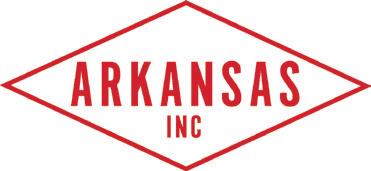

First Place: Pediatrica Therapeutics – UA ($20,000)
Second Place: CareMate Technologies – UA ($10,000)
Third Place: Vitruvian Matrix – UA ($7,500)
Elevator Pitch Competition Winners ($1,000 to each winner)

Winrock Automotive Small Business Division: Waderbuddy, Ouachita Baptist
High-Growth/Technology Division, Undergraduate Track: CarpeDerm, Harding/UCA

High-Growth/Technology Division, Graduate Track: U.N.C.L. – UA
Faculty advisers for the nine winners in the three overall tracks won a cash award of $1,500 each.




Simmons Bank congratulates Tommy May on being selected as an Arkansas Visionary!







Tommy’s leadership – currently as chairman for Simmons First Foundation and previously as Simmons’ CEO – continues to impact our company, community and countless lives. We’re proud of Tommy’s contributions and are especially grateful for his example.



There are many things about retired banking executive and Arkansas Business Hall of Famer Tommy May’s life and career that stretch the imagination and defy belief. His masterful leadership grew a small bank of the Arkansas Delta into a household name, his list of community involvement is long and his courage in the face of personal obstacles continues to inspire people from all walks of life.
But grand as it is, the story of Tommy May pales in comparison to the storyteller himself — a warm, selfdeprecating individual who eschews the credit for much of his accomplishments, deflecting it instead to the people who followed his lead.
that becomes even more important than what your plan is.
“We made sure that it wasn’t about who got the credit; it was about what we were able to do together in the community and make things better. That really is what community banking is all about.”
Born in Prescott and raised in El Dorado, J. Thomas May lived the all-Amer-
TOMMY
said. “I graduated from high school and, like my father and others before me, I decided I wanted to go to the University of Arkansas. With my high school grade point average, that was not an easy thing for me to do to get admitted.”
May did get in and continued his laissez faire approach to his classwork while in Fayetteville.
If there was anything that I wish had my name attached to, it would be a quote I found and have used for a long time. It says, ‘Watch your thoughts, they become words. Watch your words, they become actions. Watch your actions, they become habits. Watch your habits, they become character. Watch your character, it becomes your destiny.’ That’s Leadership 101. Incidentally, the author is unknown. Couple more years, I may put my name on it. It’s been unknown for way too long, and it’s got to belong to somebody.
“First and foremost, I believed in being a benevolent dictator. That’s what everybody thinks I was,” May said with a chuckle. “But it truly has always been about team building, being able to articulate what your philosophy is and
ican life of a small-town high school star athlete with far more academic potential than his grades would have you believe.
“When I was in high school, I was having a great time. I was not what I would consider a serious student,” he
“During those first two years, I had a great time. I was really enjoying college life, everything but studying,” he said. “At the end of the second year, I came home with a cumulative grade point average of about 2.2, and I was pretty im-
pressed that I’d been able to get it up to that level.
“My dad didn’t share that enthusiasm, and he told me that I was going to stay home for one full year until I matured a little bit.”
The elder May got his wayward son a job in the south Arkansas oil fields, a brutal work assignment performed in the elements that included, in May’s words, “mosquitos as big as sparrows.” Six months was all he could take

“I believed we are only as good as the communities that we serve.”
Tommy May
My belief is that if you work hard and you make yourself part of a team concept and you submit to the ‘Do Right’ rule, there’s a 99 percent chance that you’re going to succeed. At the same time, there are three great distractors: negative thoughts, negative words and negative people, the latter of which can destroy a team made up of predominantly good workers. Negativity, in thought and word and people, is destructive. They had no place in our organization. They would always be given an opportunity to change, but if they did not change, they needed to find other opportunities.
before deciding a change was in order.
“I decided that I’d go get my own job, and to show you how smart I was and how much I matured; I went down and joined the Marine Corps,” he said. “I remember [Dad] saying, ‘Boy, you’re not near as smart as I thought you were.’ Anyway, it was the greatest thing that ever happened to me.”
The intense discipline of the service, especially that of an earlier era and in wartime to boot, had a transformative effect on the young Arkie, an education that commenced the moment the bus lurched to a stop at boot camp.
“Shortly after joining the Marine Corps, I saw a movie called ‘The D.I.’ with Jack Webb. I watched it on TV, and it looked pretty fine to me,” May said. “I get on the plane to San Diego and get on the bus, and I’m thinking they can yell at you, they can scream at you, but they can’t hit you.
“Well, you know how movies are, they don’t always tell the truth. I’m about to get off that bus, and a young man in front of me stepped on the [drill instructor’s] boots and he knocked him halfway across the bus. My whole life laid out before me.”
May’s subsequent service in Vietnam from 1967 to 1970 was another major chapter in codifying who he was and what he wanted to stand for.
“Vietnam turned me around both faith-wise and attitude-wise in realizing
that there’s a lot of things that are important in life that I was missing and that I needed to do better at,” he said. “One of those was my education, and when I got back Uncle Sam paid for me to go back to college. Got my undergraduate degree in finance, and then I got my master’s degree in finance.”
Another chuckle. “Shows what a little maturity can do for you.”
His entry into banking was more about available opportunity than following a grand plan for his career. In fact, at the time he accepted his first job with First National Bank of Commerce in New Orleans, job opportunities to join Kroger and a ladies apparel company in Houston, Texas, were under serious consideration.
Over the next five years, May worked in the bank’s national accounts division, dealing with large business clients in the region. In 1976, he came home to El Dorado and Exchange Bank, where he steadily built a stellar reputation over 11 years, ultimately reaching the office of president and CEO. In 1987, he accepted a similar job at Pine Bluff-based Simmons Bank, at the time a $500 million enterprise with just two locations in Pine Bluff and Lake Village. It was a modest start to a career that would ultimately cement May’s legacy in the annals of Arkansas business.
“There were some opportunities for improvement [at Simmons] is the way I
would summarize it,” he said. “We had some challenges in our own portfolio. We had a few challenges in culture relative to spending. As a team, we decided what we had to do to get it to where we wanted it to be, so we could begin expanding.”
May’s early time at the helm was notable thanks to two natural gifts: the ability to assemble and inspire teams and a spartan attitude toward costs.
“To say I was conservative would be a pretty accurate description of me when it came to expense controls, and I was conservative when it came to identifying market potential,” he said. “I spent my first years here dealing with asset quality challenges, and then I became a bear on expense controls, and as those things developed, the earnings of the company were better and the capital accumulation became better.
“We would then seek out acquisi-
What is your philosophy about how this organization is going to run? That was a very important thing I had to articulate. I will tell you that first and foremost it was what I called the Lou Holtz ‘Do Right’ rule. It was sort of a thesis statement; I don’t care where an idea comes from, if it’s not the right thing, don’t do it. Not that I’m a goody-two-shoes or anything like that, I’m just telling you that I have found being on both sides of that, you’ve got to remember others are watching. If you’re the CEO, you’ve got to send the message not only verbally but in your own actions. I truly tried to do that.
tions to begin to diversify where we were based on what our capital would permit us to do. It’s very hard to diversify too far based on the limited capital of $500, $750 million banks, so you had to grow the institution, accumulate good earnings into capital and then expand. My philosophy was more of a long-term, controlled expansion.”
The process worked like a charm, growing the bank to $4 billion in assets over nearly 30 years. And it drew the blueprint for everything that was to come under May’s successor and prodigy George Makris, now passed to May’s longtime underboss Bob Fehlman. Today, the Simmons brand is a $27.5 billion enterprise with more than 200 locations in six states. Throughout its market areas, the bank is as well-known for its community involvement as it is for its return to shareholders, which is another legacy of May’s time at the helm.
“I believed we are only as good as the communities that we serve,” May said. “If there is one type of institution that can really make a difference in the community, it’s a bank. I believe that every institution in the city is important, but none are more important than banking. I brag on Simmons because of your, because of our philosophy to make a difference in the communities that we are in today.”
Navigating the bank through the up and down cycles of the market represented an enormous challenge, yet even this paled in comparison to May’s ALS diagnosis 17 years ago. Commonly known as Lou Gehrig’s Disease, ALS is a progressive neurological condition for which there is no cure. But while the disease forced May into relinquishing his executive role at Simmons Bank, he still leads the charitable Simmons First Foundation and is also chairman of Go Forward Pine Bluff, a group working for the revitalization of the city.
And even though his condition has affected his mobility and speech, no one
who knows him can honestly say the disease has yet to gain the upper hand over May’s mind or his spirit.
“I will tell you, it’s my faith in God,” he said. “I believe that He has a purpose yet for me to fulfill, and that’s not just at work or in my community, that’s with my family and with young bankers. One of my commitments to myself and my
so much of his life, career and faith. He holds no illusions about where the ALS road leads, but mortality is no truer for him than for anyone else living, so he doesn’t let his particular circumstance dictate his purpose or his potential. And anyway, that role in his life has already been filled.
“God didn’t expect me to sit around
Feeling sorry for myself, I do not do. There was a time I did. I went to the very bottom, but I came out of that fairly quickly. You’re not human if you don’t feel the impact of a diagnosis like ALS; sometimes I hear myself saying things that sound like this is good ol’ apple pie and Chevrolet, but it’s not. Time is sort of, of the essence you could say. Who knows? Some people live five years and I’ve lived 17 years with this disease. But instead of sitting around the house, most people with ALS that I know are very involved because they still want to make a difference. Some because of their faith, some because of family and some just because of who they are.
Lord is that I want to live every day as if it is my last day. It’s easy to say, but it’s a hard thing to do because by doing that, it means leave nothing undone, leave nothing on the table. That is a hard, hard thing to do, but if you don’t try, you never will.”
The best example of May’s indomitable attitude may well lie in the fact that despite his condition, he continues to golf, an embodiment of the old-school trash talk, “beating you with one hand tied behind my back.”
“I play with one arm,” May said matter-of-factly. “I have a golf cart that will lift me up basically to where I’m standing, not quite, and I can put a seatbelt on. I play left-handed. Mr. Makris introduced me to a crowd one night at an awards event. He said, ‘I want you to know Tommy May makes the rules, he changes the rules, and he interprets the rules.’”
May’s golf game is the perfect illustration of the adaptation and perseverance in the face of adversity that has informed
and feel sorry for myself. He expected me to make a difference and that’s what I’m trying to do,” he said. “To me, it’s not an issue of legacy, it’s an issue of doing what you can when you can with what you’ve got. That means if there’s a project that we’re working on, I’m going to give it 100 percent.
“I think, if you were to ask my children and my grandchildren and others, they would tell you that my focus was always on doing the right thing. One time one of my grandchildren said, ‘How do you know if it’s the right thing?’ I said, ‘Hopefully, your gut will tell you after all of the years that you’ve heard your parents and your grandparents talking about the right thing.’
“In business and in life, sometimes my interpretation of doing right and somebody else’s interpretation was a little different, and that’s OK. As long as my heart and soul are right, that’s all that I ask for because that takes care of everything else.”

For as long as he can remember, Joseph Wood has felt just a little bit different from the people around him. Adopted into a large family, he felt at times growing up a stranger among siblings, and attending college in diversity-starved Iowa only reinforced how few Black and brown faces there were to mirror his.
Even his political philosophy — a conservative of color — earned him a place in an exclusive club that began in his 20s. And today, in his role as Arkansas Secretary of Transformation and Shared Services, he shepherds a department few people have ever heard of, let alone know what it does.
Yet, after all of this time, being different is precisely the credential that he points to as most essential in his successful career in the corporate world and in public service. Even if it took Wood a little time to realize it himself.
“It was not on my radar — transformation and shared services,” he said. “In fact, I will say even though the governor did her research and said, ‘This is what you’ve done, and that’s what we need,’ I couldn’t initially put two and two together. She said, and I believe it, and she can hire folks with particular skill sets
and qualifications, but do they really understand and can they buy into a vision?
“I starting looking back on what I did as deputy secretary of state and as county judge, where I was that change agent, a disruptor asking the question, ‘Why?’ You’re not supposed to ask why in government; this is just how we’ve always done it. Well, that’s not acceptable to the governor. She wanted someone who can come in and help continue the work of transforming government, looking for effective ways to do our business in the state and how to be more efficient.”
Wood’s department grew out of Gov. Asa Hutchinson’s initiative to reorganize state government departments, a process that stalled during the COVID pandemic and subsequent change of administrations following last fall’s gubernatorial elections. Its purview is broad but goes unnoticed by many rank-and-file citizens, focused as it is on back-office elements such as HR and benefits functions, new employee onboarding and maintaining information systems to support the work of all other state offices.
Dry though that may seem at times compared to overhaul-
ing Arkansas’s education system or luring a major new manufacturer here, it’s nonetheless a critical part of how government operates and functions in service to its constituents. Even if, as is often the case, the public isn’t aware of it.
“Transformation and shared services has the responsibility of helping to reshape and reform state government by looking at sharing services,” he said. “We look at redundancies, duplication and trying to narrow and cut that out for cost savings to the citizens of the state. It also brings nimbleness in how we do state government.
“For me, it’s about being responsive and showing the value. What is it that the citizen is saying they need, and what is our process to help departments fill that need? Are we thinking outside the box or do we need a new box?
“At the same time, continuous improvement means that whatever we come up with to streamline and be more efficient and more responsive, we’ve still got to make sure at the end that we understand who the recipient of that is. Is it an employee or is it a citizen, and are we satisfying them? Are we getting them what they need?”
Wood admits being mere months into the new role means much of what occupies his time now is exploratory, but his resume leaves no doubt as to the capacity he has for affecting meaningful change within organizations at the highest level. Among his stops on the way to Gov. Sarah Huckabee Sanders’ cabinet were stints as head of international recruitment for Walmart and as deputy secretary of state, where he forged a reputation for cutting government waste, reducing red tape for businesses, managing budgets and improving services.
After that, he served two terms as Washington County Judge, where he developed and improved county buildings, roads and bridges; created a crisis stabilization unit; presided over the quorum court; and generally rode herd over the third-largest county in the state and one of the fastest-growing counties in the nation. During that period, he also served as chairman of Community Economic and Workforce Development for the 3,100 counties that comprise the National Association of Counties.
“Where we are now is, it’s still a discovery,” he said. “I’m coming in here and trying to unravel what has already been created and done. Some of that work had already started, and now that we’ve gone from 42 different departments down to 15, we’re looking at what people have identified in each respective department
as ways to share some services to be more streamlined.
“Then, where there was output, the question now becomes have you started executing some of those? If not, are they even still a priority? What was a priority back when you turned it in may be very different given some of the direction of the current governor.”
If it all seems very chaotic, then chaos fits Wood like a welltailored suit. Nothing in his demeanor suggests panic or impatience, but neither is there an equivocating timbre to his voice.
“Gov. Sanders and I get a chance to work with a fresh slate. We’re looking at some of the things going on in the Department of Commerce, for example, where they can share some services and achieve some efficiencies. Those things may not work with the Department of Labor, but they might work with the Department of Education. I get a chance to work with all of them, which is a unique and pretty cool role, to participate and work with all my colleagues.”
Wood’s personal backstory is also a study in managing the unknown into meaningful order. It began sometime shortly before a brutal 8-degree night in his native Chicago. Caesar Johnson, on his way to work where he was a supervisor at the Campbell’s Soup factory, happened to notice a shoebox left on the steps of an apartment building. Something made him nudge the box and when it moved back, he looked closer to find a baby inside wrapped in a thin blanket. Johnson snatched the box from the stoop and, awakening his sleeping wife, warmed the infant and waited for the cops.
Not much came from the inquiry — no one saw anything, and the snow yielded no tracks — so it was unlikely anything would actually come of the discovery. Still, when one of the officers tucked the box under his arm to leave, he had enough humanity to say, “Thank you; you saved the kid’s life,” before disappearing into the night of March 20, 1965.
Wood spent the next decade at St. Vincent’s Infant Asylum, a local orphanage. At age 10, he was placed in foster care with Loretta and Sylvester Wood — she an educator and he a construction worker — but from the word go, his mother made up her mind to adopt him. When the marriage fell apart, Loretta took her four children from the Rosemont neighborhood to Chicago’s notorious Jeffrey Manor and set about the daunting task of providing for her offspring.
“People moved into Jeffery Manor because housing prices
“I definitely want to be seen as what I call a lighthouse; I want to be a beacon of hope and inspiration, if you will, not just for the community in which I came out of back in Chicago or where I was a judge in Washington County, but to the entire state.”
were so much more affordable then,” Wood said. “It was plagued with a lot of drugs and gangs. My mother ended up telling me, ‘You have to do something to keep your brothers and sister from getting caught up in the gangs and drugs. I’ve got to pick up a second job.’ She was a teacher and she did some work in the evening.”
A mere teenager, Wood at first didn’t know what he could do to fulfill his mother’s instructions, but Loretta was relentless.
“Mom, she loved us, she was crazy about her kids.” he said. “She was always saying, ‘You could be anything. You could do anything.’ I couldn’t have had a more supportive, more motivating encourager than my mother.”
At last, Wood formed a teen group called Teens Together to provide his siblings a safe place to go and hang out. Once parents in that neighborhood heard about the club, the once-abandoned Wood discovered just how many honorary brothers and sisters he had.
“The local church gave me keys to the church’s big fellowship hall. So, any time I needed to pull kids together and meet, that’s what they did,” he said. “I remember, it grew so fast and grew so big because so many parents in that neighborhood of Jeffery Manor were really trying to figure out where can they take their kids to keep them safe and keep them from doing something destructive.
“To this day, I’ll get a call from some of those guys who remember that club. I had no idea it made such an impact; I was doing it because Mama told me to do it. But she also told me, ‘For the rest of your life, you need to be engaged in where you live because that’s where you live.’ And that’s what I’ve done my whole life.”
His against-the-current conservatism began when, on a break home from Iowa State University, he was shocked at how little had been improved in his old neighborhood. Once home for good, he started getting involved in local school board elections but to little avail — and his frustration grew. Finally, when an incumbent politician was invited to the front of church during services to make an appeal for votes, his anger boiled over.
“I was so mad that you would stop church to do that,” Wood said. “Then, I was even more mad at the guy who came in, because this same guy we keep electing, he’s passing the same broken buildings and dilapidated streets and yet we keep voting that same type of guy in.”
One night, as he worked his job at the downtown Chicago Hiltonhead Towers, Wood railed to a regular about what was happening.
“He was an older Black man, and he was like, ‘Whoa, whoa. Slow down. You’re talking to me like I’m a Democrat,’” Wood said. “I looked at him like, ‘What are you talking about? Everybody in Chicago’s a Democrat; Black, white, old, young, everybody.’ He said, ‘No, no. I’m a Republican. In fact, I’m a thirdgeneration Republican. I watch what you do in the community and then you go and vote against everything you believe in and stand for on Election Day. Let me help you understand what a Republican is because I know you don’t know anything about it.’
“As he started talking, the scales fell off my eyes. I’m like, ‘Whoa. That lines up with what I believe and what I do.’ Then after he’d shared all that, I switched parties. That was in 1988, and I haven’t looked back since.”
Today, Wood is still acting on his mother’s directive, guided by his conservative conscience. In addition to his job in the public sector, he’s also heavily invested in community service work. He’s a state board member for The Call and an advisory board member for Opportunity Arkansas, and he formerly served in leadership positions for KIPP Delta Public Schools, Sister Cities International and the Chancellor’s Diversity Advisory Board at the University of Arkansas. He’s also authored two children’s books, “Saving Joey” and “Adopting Joey,” based on his unique origins story.

“I definitely want to be seen as what I call a lighthouse; I want to be a beacon of hope and inspiration, if you will, not just for the community in which I came out of back in Chicago or where I was a judge in Washington County, but to the entire state,” he said.
“I will always have a foot in working with the communities in which I live, because that’s what I’ve always done. Writing books, speaking in church, going into schools and speaking and reading to kids, I will always have that as part of my involvement. People can connect through that and then say, ‘You know what? I never thought about that; I think I can do that.’ Or they may be like, ‘If he can do that, surely I can do that! Oh, my word!’ And that’s fine. That is all fine.”
 By Mark Carter
By Mark Carter
Junior Achievement of Arkansas will honor its 2023 Legacy Award winners at the 15th annual Legacy Award Luncheon on May 25 inside the DoubleTree Hotel Ballroom in downtown Little Rock. The Legacy Awards Luncheon is the nonprofit’s largest fundraiser, benefiting thousands of students throughout central Arkansas.
Founded by Sheffield Nelson in 1987, Junior Achievement promotes economic and financial education in central Arkansas schools and recognizes those who champion that mission. The Legacy Awards were established in 2008, and recipients are chosen for their exceptional leadership in supporting academic excellence in Arkansas.

This year’s Legacy Award winners are Miguel Lopez, senior vice president and chief community outreach officer for Encore Bank, and Sharon Vogelpohl, president and CEO of MHP/Team SI. Dr. Fitz Hill, CEO of Arkansas Baptist College Foundation and the Scott Ford Center for Entrepreneurship & Community Development and founder of the Derek Olivier Research Institute for the Prevention of Gun Violence, is the 2023 Education Award winner and US Bank will be honored as the Nelson Summit Award winner for its commitment to JA’s mission.
Arkansas Money & Politics asked award winners about their involvement with Junior Achievement and the importance of promoting financial literacy in local schools. Representing US Bank is Mike Richardson, branch banking market leader for Arkansas and Missouri.

 Miguel Lopez
Dr. Fitz Hill
Sharon Vogelpohl
Miguel Lopez
Dr. Fitz Hill
Sharon Vogelpohl
AMP: Tell us about your involvement with Junior Achievement and promoting education in Arkansas.
Vogelpohl: I became involved in JA nearly 25 years ago when Steve Holcomb was a board member of JA and had the idea of creating the “Future Leadership Board” — a group of young up-and-coming professionals to interject energy, new ideas and a pipeline of “hands on” volunteers to the JA network.
The “FLB,” as it became known, was one of the first young professional auxiliary groups in the nonprofit community and now is a more widely leveraged strategy. The FLB grew significantly, and, as was the vision for FLB, I “graduated” to the JA Board as Steve’s successor a few years later. Some FLB alumni try to get together to bowl in the Bowl-a-Thon each year to continue to support JA. And, yes, I have a few Turkey Bowl championship trophies. (My bowling name is Janis.)
One of my first contributions to the board was a concept in which we approached longtime supporters of JA — like Sam Alley at VCC — to help promote JA by “donating” some of their firm’s planned advertising in the Arkansas Democrat-Gazette to do a campaign to raise awareness of JA, what they do and showcasing the caliber of community leaders and companies that choose to support JA and why. For example, Sam Alley told his story of how he came to the U.S. with nothing and built one of the nation’s largest construction giants. Entrepreneurship in action. Remember … this is before social media existed. So, this was an unprecedented awareness push.
After serving a few more years on the board and the northwest Arkansas market launched, there was discussion of establishing a statewide board for JA, and I was fortunate to be invited to the inaugural board tasked with the strategic planning to bring what is now the statewide board to life, which was truly an honor.
One of the things that really sticks with you about the JA story is the retention rate of volunteers in the classroom. JA makes it so easy for anyone to “just add water” in the form of their personal life and business experience to bring the amazing JA materials to life.
I had also become involved in the Rotary Club of Little Rock, and Rotary International was celebrating its centennial. Then banker, now congressman, French Hill was the president of the club at the time and invited me to be a part of his cabinet and planning high visibility projects for the
club in the community. About that same time, JA was promoting a concept called “JA in a Day” — where a group would basically take over a school and teach six weeks of JA curriculum in a day. I saw that this concept would be very appealing to busy professionals who saw the scheduling aspect of volunteering in the classroom as a hurdle/ excuse for not volunteering.
The Rotary Club of Little Rock adopted a school, and senior executives from business and nonprofits rallied to teach all the curricula in one day. Media was secured to help promote the program for JA as a new option, and many of the Rotarians who participated were able to bring volunteer opportunities back to their places of business.
After I rolled off the board when I had children, we continued to be involved as a firm with pro bono consulting and public relations services, participating in the bowl-athon and the business luncheon.
More recently, the next generation of the agency’s leadership, Kristen Nicholson, earned a slot on the central Arkansas board, then was promoted to statewide board and now is serving as the chair of this Legacy Awards event, which is very special to me.
Lopez: As the chief community outreach officer for Encore Bank, I manage 11 community outreach officers across our footprint. Three of which are right here in Arkansas. We partner with Junior Achievement from San Antonio to Tampa Bay and everywhere in between. I am proud of our involvement in schools here in Arkansas. Out staff is super sharp and diverse. It’s not just about teaching financial literacy but also about representation and showing our children that they too can be a banker one day.
Richardson: I’ve personally been involved with Junior Achievement for nearly 20 years in different capacities. Promoting financial literacy in Arkansas and across the
“JA makes it so easy for anyone to ‘just add water’ in the form of their personal life and business experience to bring the amazing JA materials to life.”
Sharon Vogelpohl
country is a huge priority for US Bank. In 2022, approximately 1,400 US Bank employees served nearly 80,000 people by teaching financial literacy. Some of my career volunteer highlights are working within our schools and among young students to help them gain financial knowledge and build confidence.
Hill: As a native Arkansan, I have been involved in educating students of The Natural State for nearly 30 years. I have had the awesome opportunity to work with students from middle school through postsecondary education. Growth often comes outside of the student’s comfort zone; consequently, I take great pride in encouraging those who I get to work with that being consistent in persistence is fundamental in achieving desired goals.
AMP: How important is it to expose students at an early age to programs that foster financial literacy, work readiness and entrepreneurship?
Lopez: Our education system’s curriculum is flawed in that it does not teach our students practical real-life lessons around money. Money is the most important tool we should learn to master, and the earlier the better. Junior Achievement fills that gap. Teaching our students real-life practical lessons around money, like how to save, budget and invest are crucial for establishing a strong foundation early on. I haven’t used the Pythagorean Theorem since high school, but I check my household budget and investments routinely.
Hill: Financial literacy empowers students’ abilities to make sound decisions regarding their finances, which pays huge dividends in the future by consistently using sound core principles of money management. Strategic financial planning of personal resources and working with appropriate mentors assist students in comprehending financial theory as well as successfully implementing the applied principles for sustainability. These elements are
invaluable in creating an entrepreneurial mindset, which improves the lives of individuals, communities and the overall economy.
Richardson: It is incredibly important to work with students of all ages to teach appropriate financial literacy concepts as well as emphasize work readiness and entrepreneurship. It’s never too early to start discussing the importance of saving and planning for the future.
Vogelpohl: It’s huge … and the need continues to grow. I was fortunate enough to grow up in a family business, so I was issuing payroll, balancing checkbooks and cutting checks to pay vendor invoices and expenses from a very early age.
The family was in the car business, so the importance of consumer credit scores, how interest rates work and monthly budgeting were foundational. When I had to type (yes, I said type … and you couldn’t make a mistake on a four-deep carbon copy form) sales contracts, those boxes listing interest rate, term and seeing the calculation of “total of payments” really gets your attention. Not everyone has that opportunity, and it is imperative that basic financial literacy be established early.
I can’t count the number of times I have overheard (and still can) my dad counseling someone on not buying the car they want but convincing them to buy the car they can afford. He had JA as a student growing up in Illinois and would go to local high schools that didn’t have JA and teach students how to budget, negotiate and make good decisions about buying a car so as not to get “upside down,” as we say in the car business.
AMP: Are schools currently doing enough to help promote these concepts?
Hill: There will always be room for improvement. However, it’s important to find creative ways that inspire students to want interact with educational tools, which promote
“It’s important to find creative ways that inspire students to want interact with educational tools, which promote and train for the desired outcomes to be achieved.”
Dr. Fitz Hill
and train for the desired outcomes to be achieved. Interactive learning through smartphones and Esports can assist educators with teaching financial concepts.
Richardson: I am encouraged by community organizations like Junior Achievement and the unique partnerships that take place in our schools to help promote financial literacy concepts.
In Arkansas, our employees are regularly connecting with teachers and other leaders invested in the lives of students to teach, encourage and come alongside our local youth.
Vogelpohl: Schools and our teachers have an enormous responsibility and numerous expectations to teach core curriculum. If it were up to me, financial literacy would be core curriculum. But since it is not, it is important that the community, business and parents rally around programs like JA that supplement the core.
Lopez: We are making great strides especially here in Arkansas, and JA Arkansas has led the way.
AMP: In what ways have you seen first-hand how the JA mission is making a difference?
Richardson: During a recent JA in a Day event, I was particularly inspired as I watched students and teachers interact. Hearing them talk about making and saving money, and also giving back to their community, was really encouraging.

Vogelpohl: Having been in the classroom as a volunteer before I had children, it is amazing to see the level of excitement and engagement that having a special guest/JA volunteer in the classroom for 45 minutes can engender.
Then, my own children have been the beneficiaries of JA at Our Lady of the Holy Souls under the leadership of Dwain Hebda, a truly tireless and passionate volunteer who has taught countless lessons and reached hundreds of students with JA’s inspiring and practical programming over nearly a decade.
Lopez: When you go to the schools to volunteer, you see firsthand the difference JA makes. I encourage you to get involved!
Hill: Junior Achievement strives to inspire and prepare students to succeed in a global economy. The organization assists participants in discovering what’s possible while connecting what’s learned in the classroom with real life experiences in work spaces.
At long last, the renovated, expanded and rebranded Arkansas Museum of Fine Arts in Little Rock officially opened its doors to the public in April. Executive Director Victoria Ramirez and her staff welcomed visitors to the unveiling of the 20,000-square-foot, reimagined museum.
Photographer Stephen Lewis took part in a media sneak peek and captured the following images from the museum’s eight galleries and its opening exhibition, “Together.”
The museum’s permanent collection includes work by Rembrandt, Picasso, Wyeth and Degas.
In addition to the galleries, the renovated museum includes new entrances, an expanded art school, a performing arts theater, a lecture hall, an atrium, the “glass box terrace,” “the cultural living room” and the Park Grill restaurant with expansive views of the newly landscaped grounds inside MacArthur Park.
The museum was opened in 1937 as the Museum of Fine Arts and renamed the Arkansas Arts Center in 1961. A $70 million renovation project was announced in 2018, and the project was rebranded as the Arkansas Museum of Fine Arts, a nod to the museum’s original name, in 2021. Private fundraising, spearheaded by Harriet and Warren Stephens, had raised roughly $171 million by the opening with proceeds from the city’s hotel tax accounting for $31 million.
International firm Studio Gang served as the architecture lead with help from Little Rock’s Polk Stanley Wilcox while Conway-based Nabholz worked with Pepper Construction Group of Chicago and Doyne Construction of North Little Rock.

Kate Orff of Studio Gang directs visitors at the sneak peek; Harriet and Warren Stephens, co-chairs of the project’s capital campaign, visit with members of the media; AMFA Executive Director Victoria Ramirez discusses the works included in one of the museum’s new galleries; visitors checked out the new Park Grill overlooking the museum grounds.
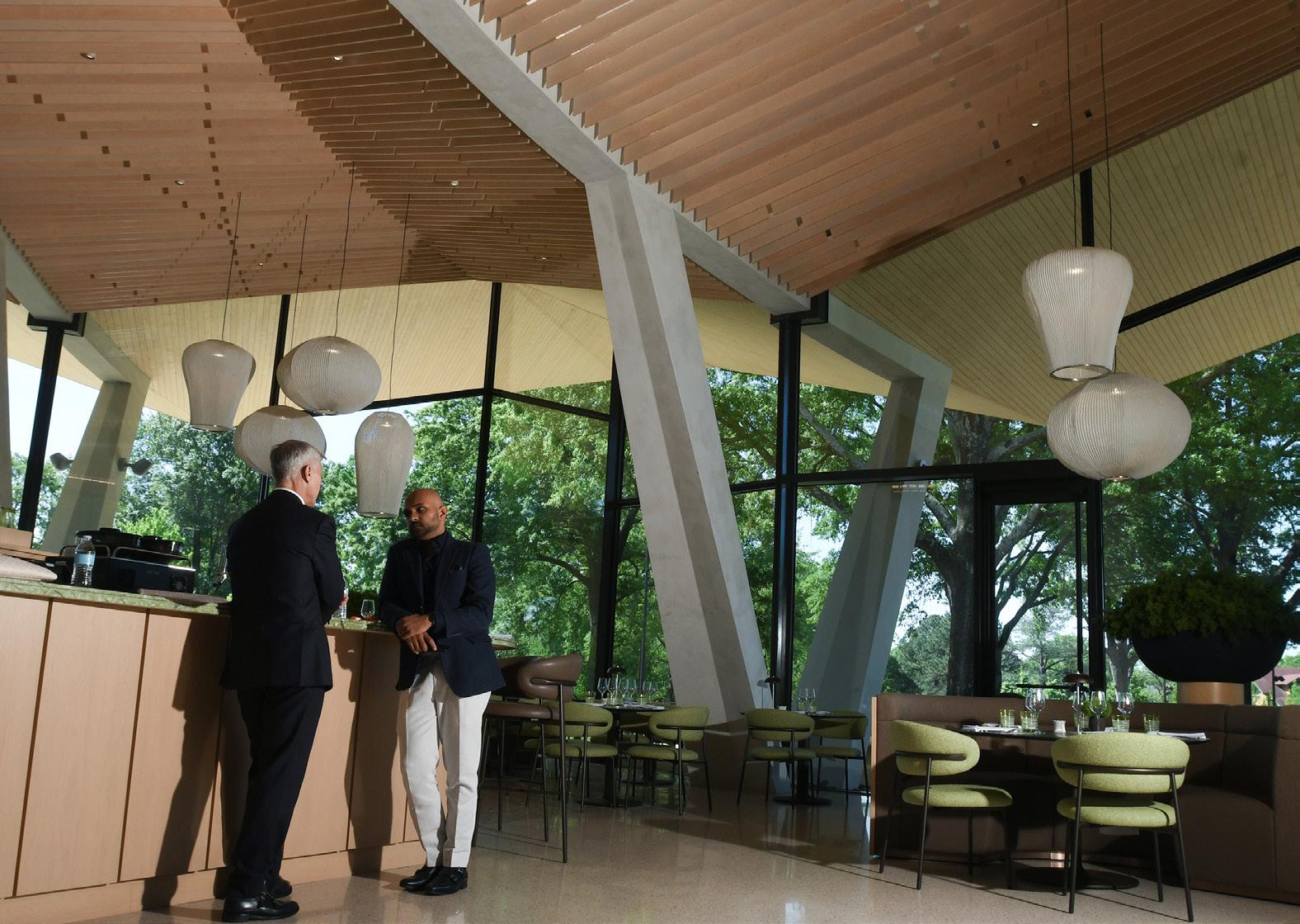


by Stephen Lewis)
 (Photos
(Photos







Stephen Carleson of US Beacon can talk at length about the need for cost oversight in the complicated field of health care, particularly for self-insured businesses and organizations. He’s also well-versed in explaining how the company’s technology performs its work, ferreting out incorrect charges that would otherwise go unnoticed. And as a former managing director and senior vice president with Merrill Lynch, he knows a good business opportunity when he sees one.
But for the uninitiated, all it takes is one glance at an itemized list of incorrect charges to see the genius of the Little Rock-
based company. Carleson provided such a document, the company’s Explanation of Review, produced for an actual client, redacted to comply with HIPAA. The EOR’s tally list of incorrect charges went on for seven and a half pages.
The damage: 424 incorrect charges spread out among 271 individual line items totaling $127,858.94, roughly 40 percent of the original invoice. And considering the sample EOR represented the cost of medical care for just one employee of just one organization, the staggering financial impact of incorrect billing across the board quickly boggles the mind.
“We’re trying to make sure that what our client pays is what they really owe. That’s our job,” Carleson said. “Ninety-nine percent of the bills that we review, we find ineligible charges. We find about 30 percent savings on those 99 percent of the bills; with the bigger guys, we find closer to 35 to 40 percent.”
Health-care billing is an exceptionally complicated process where every tube, needle and bedpan are assigned both a billing code and a cost. Researching the validity of each line item is not only mind-numbingly tedious, but few companies have the manpower required to dissect bills from multiple employees’ care. To say nothing of the kind of expertise that would spot duplicate charges or misapplied codes anyway.
“We come in and we’re looking at the different codes,” Carleson said. “What happens in procedure codes is you have certain items that are in there that we have to take and dismantle to be able to come up with what the ineligible charges are.”
“We do find fraud, waste and abuse, especially when looking at out-of-network providers.”
There are myriad reasons why a patient’s bills may be incorrect, from simple data input errors to something more nefarious.
“We do find fraud, waste and abuse, especially when looking at out-of-network providers,” Carleson said. “We had a client whose employee had an accident out of state and the bill was $2.5 million. We got the bill, we reviewed it, it was $900,000. Our clients often have to receive services from out-of-network providers and that often adds an additional level of complexity. In a very short period of time, we’ve shown we have the capability to unpack those bills effectively and determine what is a valid
charge and what isn’t.”
Often, a patient is incorrectly charged for something multiple times. In the sample EOR Carleson provided, 60 hours of oxygen totaling $4,260 and half of a 25-dose, $1,400 medicine line item were deemed ineligible for payment. Or the cost of an item, let’s say a catheter tube, might be coded individually as well as being baked into another code covering the cost of a hospital room.
“If you’re paying for a surgical suite but then you also have pharmacy, you may have a charge for something, whatever it may be, that’s already in your code,” he said. “You’re
already paying for it.”
US Beacon (us-beacon.com) bases its analysis on rules already on the books. Each inaccurate charge is correspondingly catalogued on the EOS with an explanation as to why the charge is ineligible. Examples include “Integral to service/procedure,” “Exceeds the maximum allowed in a single day,” and “Non-prescription drugs are not billable.” US Beacon’s expertise and meticulous attention to detail has earned an impressive track record when it comes to appeals of its analysis.
“We’re looking at the billing code and we’re dissecting it, we’re unbundling it,”

Carleson said. “A health provider could come back and protest that. However, we’re doing everything by the federal law. Our appeal rate is less than one quarter of one percent and we’ve never had an appeal loss because we’re doing it strictly on federal CMS regulations.”
That fact, said Dr. Dwight Davis, a private pharmacy management consultant who’s worked with US Beacon for four years, is one of the most compelling aspects of the company’s process.
“[US Beacon’s] findings are significant, and if their findings were erroneous more providers would appeal those,” Davis said. “The fact that they have a very low appeal percentage says that their findings are valid.”
On the strength of its track record, the company has experienced explosive growth since Carleson and fellow co-founders Jim Fersch and Carleson’s wife, Kimberly, incorporated US Beacon in 2019. In addition to its Arkansas headquarters, the company has offices in Los Angeles and Virginia and employs a total of 50 people. Carleson said based on business growth, he expects to double employee headcount by the end of the year.

“Things have grown considerably over the past four years,” he said. “Everything we’ve done to this point has been on referral; we work for someone and they tell another employer that has their own [selffunded health care] plan. Now, we’re actually going out and going after business offering this service to employers for health care and workers’ comp.”
Besides the obvious benefit of not paying for things they shouldn’t, companies and organizations are eager to have this kind of oversight to stay in good standing with the feds. Self-insured employee benefit plans fall under the aegis of the U.S. Department of Labor’s Employee Retirement Income Security Act (ERISA), a law that sets minimum standards for voluntarily established retirement and health plans in private industry.
Among ERISA’s requirements are fiduciary responsibilities for those managing and controlling plan assets. Blindly paying inaccurate medical bills instead of employing some sort of oversight to detect errors could be seen as a breach of fiduciary duty, resulting in prosecution and lawsuits.
“If you look at the ERISA regulations under health care, it singles out trustees and managers, meaning the company itself can be held responsible for violations for not doing their fiduciary responsibilities,” Carleson said. “So, we’re saving them money and we’re helping them stay in compliance with ERISA.”
US Beacon isn’t the only company providing these types of services, but it has set itself apart from the field in various ways. For example, the company has no service contracts with its clients but is paid a percentage of established savings. It is also differentiated by the range of medical bills it will review for clients.
“We don’t look at all their medical bills. There’s no way to look at all the bills, but we will look at bills as small as $10,000,” Carleson said. “The companies we compete with usually start at bills of $100,000 and above. Often in those cases, we’ll come in behind them and find things.”
The cost of doing business in this arena is substantial, not only to build the kind of technology US Beacon relies on to help decipher things quickly and accurately, but also to keep that technology current concerning frequently changing governmental regulations, dealing with new or obsolete codes and pushing the capacity of such tools to handle more and more bills. Currently, the company turns around bills submitted for review in 24 to 72 hours, but the likelihood of accelerated growth in the
future means pushing the technological envelope to keep turn times manageable.
Thus far, the effort has been worth it. US Beacon is adding clients at a rapid clip from government and public entities to companies in every category of business and industry including, Carleson notes with a wry smile, hospitals. The company’s record for quality and expertise has also earned it the status of awarded vendor of the National Cooperative Purchasing Alliance, which allows it to do business with the government without going through an RFP.
Carleson said while the business may not be simple, the essential nature of US Beacon’s services and the fundamental benefits client companies realize as a result are easy to appreciate.
“It’s the old 80/20 rule; 20 percent of claims cost companies about 80 percent of their total,” he said. “All we’re saying is no, don’t pay for that Kleenex because Kleenex is already on your room charge. It all adds up. As our clients have said, ‘We just want to pay for what we owe; we don’t want to pay for things twice.’ That’s really what it boils down to.”
With its free-range approach, Happy Egg thriving in the Ozarks

Happy Egg is helping to create a new category within the egg market. Call them free-range eggs, since the chickens have their run of carefully selected family farms across Arkansas and Missouri.
From the layout of the farms to the feed, everything radiates out from the chickens. Happy Egg Company is an artisanal approach to producing eggs at a supermarket scale.
Happy Egg moved from San Francisco to Rogers midway through 2018 in order to be closer to the small family farmers who supply them with eggs. According to Whitney Fortin, Happy Eggs’ vice president for marketing, the move from the big city to poultry country helped connect their employees with these farmers in a fundamental way. It also doesn’t hurt to be close to Walmart.
Happy Egg CEO Alex Worley underlines that the concept begins with the chicken. “We focus on what’s actually best for the physical welfare of the birds.”
Happy Eggs’ go-to breeds are Speckled Legbar and Copper Maran. Birds on their affiliated farms have access to eight or more acres from 8 a.m. to sunset every day. They have access to water, shade, cover from the weather and even play structures. And their diet is carefully tailored to produce the most robust eggs. These chickens cross paths with no antibiotics, no hormones and no pesticides.
Happy Egg is the first commercial egg producer in the U.S. to be American Humane Certified. Happy Egg, an active member of The Poultry Federation, partneredwith the Humane Society to initiate this certification.
“It’s something that we are really proud of,” Worley said. What kind of egg, you might wonder, does this result in?
Happy Eggs’ Heritage Eggs are known for their hard shells, in distinct mahogany brown and pastel blue colors. You might have to try more than once to crack one. Their yolks are bright orange and extra firm. These eggs are sought out by Michelin-starred chefs, foodies and egg lovers across the U.S.
These eggs’ rich, creamy taste and texture make delicious versions of all the traditional egg preparations and contribute robust flavors to cookies, brownies and every baked good imaginable. Happy Egg has recently developed premium products within the premium egg category, including an egg with an enhanced vitamin profile.
According to United Egg Producers, currently about 66 percent of the egg market is caged eggs. For eggs sold directly to consumers, that number is closer to 72 percent. Happy Eggs sees a tremendous potential in increasing sales of its unique products as the egg industry gradually trends away from cages.
Growth is central to Happy Egg’s business plan. Since moving into fowl territory, it has grown from about a dozen employees to more than 50. It is one of the fastest growing companies in its category. And the company is aggressively growing its producing capacity to meet demand for their product.
It has established relationships with more than 100 farms at this point.
Fortin said the recruitment of new farmers has become a two-way street. Not only does Happy Egg search for new farming relationships in the area, but farmers have begun approaching them. Often these farmers are converting from supplying other egg brands because they appreciate Happy Eggs’ more personal approach.
“They like the way that our business operates and the benefits it provides them as farmers,” Fortin said.
Local banks even offer lending programs geared towards helping farmers get into the business of supplying eggs to Happy Egg Co.
The Happy Egg team prides itself on disrupting the egg business. Worley stresses: “We do not follow trends. We set our own standards for farming practices, and we are continuously raising them.”
Fortin said the company is always asking itself whether it is living up to its own values.
“If we have a choice between the easy thing that works against our values we are going to go with the more difficult choice.
“Happy Egg markets its products in recycled biodegradable cardboard, while most of the industry ships in styrofoam. Sourcing our biodegradable paper pulp cartons requires more lead time and effort, but it ties to our overall values as a company,” Fortin said.
Happy Eggs are available at a plethora of major retailers, from Walmart to Kroger to Target to Whole Foods. Its in-house logistics team manages the process of getting hundreds of thousands of eggs transported from farms to retailers.
NOT ONLY DOES HAPPY EGG SEARCH FOR NEW FARMING RELATIONSHIPS IN THE AREA, BUT FARMERS HAVE BEGUN APPROACHING THEM.
 By Dwain Hebda
By Dwain Hebda
Just a few years ago, the mention of pickleball conjured visions of senior citizens in discount sneakers batting about in the glow of their golden years. But if that’s still your perception of the sport, you’re woefully behind the times. Just ask Mike Bernardino of Little Rock, who’s played the game for four years and for whom the geriatric stereotypes are fighting words.
“The early days of pickleball, when people would try to write articles on it or show videos of it, always showed a bunch of older people lightly tapping the ball back and forth across to each other,” he said. “Sometimes the game can be like that, but the game can also be extremely fast and competitive, which is why you have a pro circuit with 16- to 40-year-olds beating the ball at each other and making incredible runs on the court and all that kind of stuff. It can be very athletic, and that’s one of the appeals of it.”
Bernardino, a retired IT account manager, has been playing pickleball for four years. At 61, he would have been considered a youngster during previous eras, but instead finds himself carried along by a tsunami of pickleball popularity sweeping from one corner of the country to another.
“The thing with pickleball is, you can get with groups that are similarly skilled to you,” he said. “If you’re a college athlete, super-fast and superskilled to hit the ball and you want to play at that level, the game can be very fast and competitive. On the other hand, if you’re a senior citizen and you can’t sprint the way a young person can, it’s still a fun game for you, too.
“I have always been interested in athlet-
ics. Heavy racquetball player, heavy volleyball player. When I was in the military, we played all kinds of sports. My wife, who started playing pickleball at the same time as I did, is not as athletic, yet this was something we could easily do together. That’s another attribute of the game — you find a lot of couples playing together who are able to play at different levels and share the same space.”
Pickleball is an American sport and a relatively young one at that. The game was invented in 1965 in Washington state by pals Joel Pritchard and Bill Bell, who were looking for something for their families to do one Saturday. They rummaged around Pritchard’s home, and unable to locate a complete badminton set, dug out an assortment of athletic gear including ping pong paddles, a plastic whiffleball and a badminton net, which they set up on the property’s asphalt badminton court.
The game gained local notoriety quickly, so much so that by 1972 the creators formed a corporation to protect their invention. Four years after that, the first documented pickleball tournament was held at South Center Athletic Club in Tukwila, Washington.
From these humble beginnings, pickleball has grown into one of the more unlikely sports crazes, growing at a rate seldom matched in American history. A study released in January by the Association of Pickleball Professionals estimated there are 36.5 million pickleball players in the United States, ranking the activity third behind cycling (51.4 million) and running (49 million).
The 2022 Margaritaville USA Pickleball National Championships drew nearly 2,300 registered players with the professional players competing for $150,000 in prize money. The Indian Wells Tennis Garden hosted 5,522 fans at the peak of Championship Sunday, the largest pickleball attendance in history, per USA Pickleball.

Bernardino said the appeal of the game boils down to minimal equipment, catering to all skill levels and ease of learning the game.
“Pickleball is a sport that’s like a mash of a lot of different sports,” Bernardino said. “Most people say it’s a mash of pingpong, badminton and tennis. The reason being because it’s played similar to tennis in that you’re serving a ball diagonally

across courts. You start a session and you’re playing the ball back and you can only let it bounce one time. You can hit volleys and all that kind of stuff. It’s similar to tennis in that aspect.
“It’s very easy to learn how to play. If I had you for a half an hour I would spend like, 15 to 20 minutes explaining the rules and how to hit the ball and we would do a couple of practice shots and then instantly you would be able to play a game.”
The explosion of interest in the game hasn’t gone unnoticed by private and public sports-and-recreation entities alike, resulting in a flurry of added competitive and instructional programs.
Corrine Carr, a professor of finance at Campbell University and a former college golf player at South Carolina, is one of several pickleball pros sponsored by Vulcan Sporting Goods of Hot Springs. (Photos provided)The Association of Pickleball Professionals estimated there are 36.5 million pickleball players in the United States, ranking the activity third behind cycling (51.4 million) and running (49 million).
Many of these entities have also begun constructing new courts or repurposing languishing tennis courts to pickleball play.
“We certainly stay in tune with what’s happening in our region and in our state, and pickleball has been increasing in popularity over the last 10 years,” said Lee Farmer, recreation superintendent of Parks, Natural Resources and Cultural Affairs with the City of Fayetteville. “It’s been around a lot longer than that, of course, but the real growth has been in the last 10 years or so.
“We started offering, last fall, pickleball lessons to try to improve our efforts to provide the opportunity to play in our community, as people are looking to learn how to play the sport. We already started that last fall and then continued the program this spring and throughout this year.”
Farmer said while the city’s municipal inventory of athletic facilities and parks don’t contain any courts built just for pickleball, the game has helped bring to life several tennis courts that were otherwise underutilized.
“We have four junior-sized tennis courts at Wilson Park, and we were seeing an increasing amount of usage for those once we painted pickleball lines on those courts last year,” he said. “We did the same at Walker Park, which has two tennis courts. We painted pickleball lines on those courts just to try to meet some of the demand of pickleball in our area.
“We’ve done that to just temporarily meet the demand of pickleball play, but in our future planning, we are hoping to build
some permanent, dedicated pickleball courts in our system.”
Other organizations have grown confident enough as to the staying power of the game that many are choosing to make substantial investment in facilities. Little Rock Athletic Club announced last month it would be making a seven-figure investment to build a dedicated 22,000-square-foot pickleball facility, expected to be completed next year.

“The indoor pickleball facility we’re building will have eight indoor courts and four outdoor courts,” said Frank Lawrence, CEO of Little Rock Athletic Centers, which owns Little Rock Athletic Club. “It is something that our members are demanding, and it’s something that we’re willing to invest in for the future.”
Lawrence said the decision to pull the trigger comes after years of watching the sport grow in popularity among club members of all ages.
“I think if we’d have done this interview two years ago, it would have been, ‘Hey this is a place where people that maybe had a tennis background could come and they could continue the longevity of their racquet sport.’ But now there is no age barrier; it’s from little kids to the most senior people you could imagine.
“I think the reason is the learning curve is so fast on this. It doesn’t take too long for you to be good enough to play and enjoy it.”
Lawrence also admitted that as a private business, the construction project came down in part to keeping up with
competitors and municipal projects that have been springing up in bunches through the area and across the state. Since December, new public court construction has commenced in Bentonville, Rogers, Fort Smith and North Little Rock’s Burns Park, to name a few.
“Locally, we’re seeing the city being invested in courts. All the country clubs now have dedicated pickleball courts, and over the past 12 to 18 months, we have been building our pickleball community,” he said. “We’ve proved the concept within our membership that there was a demand for it, and we didn’t want to sacrifice tennis courts or share those courts with our tennis population. That’s where we really saw the need to make the investment to build a dedicated stand-alone facility.”
The sport is also generating revenue in Arkansas, both for retailers and Arkansas-based Vulcan Sporting Goods of Hot Springs. The company, which is part of Tanners Team Sports, was founded in 2015 as a manufacturer of baseball, softball, tennis, and particularly, pickleball gear. The company makes a full line of paddles and other equipment as well as sponsors tournaments and professional pickleball athletes. The company has even invested in its own court complex, Vulcan Pickleball Park, which is open and free to the public.
Vulcan got into the pickleball industry on the interest of its CEO Vince Signorelli, a move that has paid off handsomely as the sport continues its meteoric rise in participation and popularity.
“Our CEO is a tennis player, and he kind got in on the ground floor of the pickleball craze,” said Lucia DiGiacomo, general manager of pickleball for Vulcan Sports. “We were really lucky to get into that early as [it] really allowed us to get a good foothold in what has been like a gold rush. There have been so many manufacturers pop up just within the last year; it went from a handful to, I think, the list now is close to 300.
“Obviously, that won’t last and it’s going to come down to the brands that got there first and the manufacturers that are creating a superior product. We’re lucky to be one of those.”
The company manufactures five lines of paddles ranging in price from $89 to more than $200, providing equipment to suit every game and every price range. DiGiacomo said the breadth
of the product line is a hallmark of Vulcan being a foremost authority in the sport.
“We have a wide range [of equipment], which is a little bit unusual compared to other companies,” she said. “It is so important for people to play according to their preference; it’s all about weight distribution, the size of the paddle, how long the grip is, the thickness of the paddle.
“If you have a lighter paddle, it’s usually a little bit less substantial whereas with the heavier paddles you get a little more power behind it, and it also softens the ball a little bit more. So, there are a lot of different factors, but I’d say throughout our product lineup that’s kind of a pretty good overview of what we have going on.”
Another thing that sets the company apart is its innovation, which allows it to regularly update its product lines. This helps keep Vulcan at the forefront of equipment.
“There are some paddle brands that literally have had the exact same paddles since they came out with them years ago, and they have not updated anything,” DiGiacomo said. “We don’t have any set rule, but we want to keep up with what the game is evolving into. If you had watched pros play two years ago, that’s not the same game that you’re seeing pros play today, and a lot of that has to do with the way the paddles are made and what players expect from their paddle.
“We’re not going to just continue to do what’s tried and true and expect players to be OK with that. We want to do what is new and cutting edge and that’s what we’ve always done. We are always looking for what the next best thing is and try to do it well.”
While it’s always dicey to predict the long-term prospects of a sports craze, for now all entities are finding there’s plenty of interest in the game for all. And for those who have seen other things come and go, pickleball has all the markings of a sport with big things ahead of it.
“Arguably, I think it’s the biggest rise of an individual sport,” Lawrence said. “Crossfit, maybe, or racquetball, perhaps, back in the ῾80s are things that have had some similar momentum, but nothing quite like this has. This is about as big as anything I’ve seen.”
“ARGUABLY, I THINK IT’S THE BIGGEST RISE OF AN INDIVIDUAL SPORT,” LAWRENCE SAID. “CROSSFIT, MAYBE, OR RACQUETBALL, PERHAPS, BACK IN THE ´80S ARE THINGS THAT HAVE HAD SOME SIMILAR MOMENTUM, BUT NOTHING QUITE LIKE THIS HAS.
Allen Park Community Center
Jonesboro – 3 courts
Alma Park Tennis Courts/Community Center
Alma – 2 courts
Arkadelphia Parks and Recreation Center
Arkadelphia – 2 courts
Balboa Baptist Church
Hot Springs Village – 3 courts
Batesville Community Center
Batesville – 13 courts
Bella Vista H.O.A. - Branchwood
Bella Vista – 6 courts
Bella Vista Metfield Pickleball
Bella Vista – 3 courts
Bell Park
Greenwood – 4 courts
Bentonville Community Center
Bentonville – 11 courts
Berryhill Park
Searcy – 7 courts
Boys And Girls Club of Bella Vista
Bella Vista – 3 courts
Bradley Park
Jasper – 2 courts
Branchwood Pickleball
Bella Vista – 4 courts
Brandon Burlsworth Youth Center
Harrison – 4 courts
Burns Park
North Little Rock – 12 courts
The Center At Bishop Park
Bryant – 5 courts
Central Baptist Church
Magnolia – 3 courts
Chaffee Crossing Pickleball Complex
Fort Smith – 8 courts
Citizens Park Tennis Complex
Bentonville – 8 courts
City Event Center
Greenbrier – 7 courts
City Heights United Methodist
Van Buren – 2 courts
Creekside Park
Bentonville – 8 courts
Danville Pickleball - Arkansas Outdoor Courts
Danville – 4 courts
Sources: Pickleheads.com, Places2Play
Danville School Gym Fitness Center
Danville – 3 courts
Dardanelle Community Center
Dardanelle – 3 courts
DeSoto Family Recreation Center
Pearcy – 14 courts
Don Owens Sports Center Conway – 7 courts
East Side Baptist Family Living Center
Mountain Home – 2 courts
Eastside Park
Magnolia – 3 courts
Eureka Springs Community Center
Eureka Springs – 3 courts
First United Methodist Church
Mountain Home – 1 court
Fort Smith Athletic Club Fort Smith – 26 courts
Greenwood Nazarene Church Greenwood – 2 courts
The Grove Entertainment Complex Lowell – 2 courts
Harry Sbanotto Park
Tontitown – 3 courts
Hays Senior Center North Little Rock – 1 court
Heber Springs Community Center
Heber Springs – 8 courts
Holiday Island H.O.A.
Eureka Springs – 2 courts
Hot Springs Health and Fitness
Hot Springs – 10 courts
Hot Springs Village
Hot Springs Village – 14 courts
Hot Springs Village Church Of Christ
Hot Springs Village – 3 courts
Hot Springs YMCA
Hot Springs – 3 courts
Hughes Community Center
Russellville – 4 courts
Jacksonville High School
Jacksonville – 2 courts
Jess Odom Community Center
Maumelle – 3 courts
Jim Dailey Fitness and Aquatic Center
Little Rock – 2 courts
John Brown University, Walton Gym
Siloam Springs – 4 courts
The Jones Center
Springdale – 2 courts
Jonesboro Community Center
Jonesboro – 3 courts
Kanis Park Pickleball Courts
Little Rock – 6 courts
Kingsdale Tennis Complex
Bella Vista – 1 court
Madison Park
El Dorado – 6 courts
Marvin L Vinson - Multi Purpose Building
Clarksville – 5 courts
Matrix Tennis & Racquet Club
Lowell – 12 courts
Mellor Park
El Dorado – 3 courts
Meriwether Park
Little Rock – 2 courts
Metfield Pickleball Park
Bella Vista – 4 courts
Mount Holly Community Church
Mount Holly – 2 courts
Norfork Youth Center
Norfork – 1 court
North Arkansas Youth Center
Cotter – 1 court
Northwest Park
Rogers – 8 courts
Omaha Center
Cherokee Village – 3 courts
Osage Park
Bentonville – 4 courts
Osage Park at Lake Bentonville
Bentonville – 8 courts
Ouachita Baptist University
Arkadelphia – 6 courts
Ozark Community Center
Ozark – 3 courts
Ozarks Rv Resort
Oak Grove – 3 courts
Paragould Community Center
Paragould – 2 courts
PB&JJ’s
Fayetteville – 4 courts
Pickleball Savings Headquarters
Pearcy – 2 courts
Mountain Home Athletic Club
Mountain Home – 6 courts
Plainview Jesus Name Church
Plainview – 2 courts
Plainview-Rover School Gym
Plainview – 2 courts
The River Center at Riverside Park
Benton – 2 courts
Rogers Activity Center Rogers – 3 courts
Rogers Adult Wellness Center Rogers – 3 courts
Rogers First Church of the Nazarene Rogers – 3 courts
Rover School Gymnasium
Plainview –2 courts
Russellville City Park
Russellville – 2 courts
Silver Springs
Benton – 8 courts
Springdale Recreation Center
Springdale – 6 courts
Stone County Recreation Complex
Mountain View – 3 courts
Summerhill Racquet and Athletic Club
Fayetteville – 6 courts
Trace Creek Country Club
Benton – 8 courts
Veterans Park Community Center Cabot – 3 courts
Vulcan Pickleball Park
Hot Springs – 4 courts
Walker Park Pickleball
Fayetteville – 2 courts
Walnut Ridge High School
Walnut Ridge – 3 courts
Walton Lifetime Health Center
Siloam Springs – 4 courts
Youth Center Cooper Park
Mountain Home – 4 courts
Yvonne Richardson Community Center
Fayetteville – 2 courts






 By Mark Carter
By Mark Carter
That the Europeans who first encountered Arkansas in the mid-16th century — much less the indigenous residents on whom they encroached and ultimately displaced — wouldn’t recognize the state’s physical landscape today is a given.
The lay of the land has changed since Hernando de Soto led a battalion of Spanish mercenaries across the lower Mississippi River in 1547 in search of gold. A primordial wilderness of bayou, swamp and bottomland forest awaited them then. Over the centuries, the steady introduction of European settlers and their methods of farming eventually transformed what we now know as the Delta.
Swamps were drained and forests cleared to free up the rich alluvial soil needed to produce the crops on which the pioneers subsisted and ultimately the commodity crops
on which their economies were built.
And as Arkansas Game & Fish Commission (AGFC) Director Austin Booth notes, modern encroachment even slowly transformed the wooded savannas that historically made up the Ozark and Ouachita highlands.

Of course, pockets of that old Arkansas primordial wilderness still exist, and The Natural State remains just that. Besides, even a landscape untouched by man will change over time.
But mankind’s impact, well-intentioned or not, leaves a mark. And Arkansas is proof of that.
Booth points out that those closedcanopy forests that now adorn the interior highlands threaten the resources necessary to maintain healthy populations of wildlife, for example.
The lay of the land has been altered all right, and the consequences of the transformation could eventually threaten Arkansas’ continued “Natural State” status.
“Accelerated bank erosion is choking our fisheries and negatively affecting water quality; invasive species strive to displace native species and degrade healthy ecosystems,” Booth stressed. “And pockets of rapid population growth throughout Arkansas, though commendable, have greatly reduced the amount of available habitat and splintered much of what is left.
“Never before have we faced such a diversity of challenges.”
Fortunately, mankind has the capacity to learn from past mistakes, even if it sometimes stubbornly refuses to do so. But since AGFC’s creation in 1915, it’s held conservation among its core missions. As state officials contemplate important is-
sues like an evaporating aquifer or the responsible growth of outdoor recreation, conservation is slowly creeping into the forefront of public awareness.
The commission, through the Arkansas Game & Fish Foundation (AGFF), wants to fully establish and keep it there. Its Corporate Partnership Program was created to help it do just that.
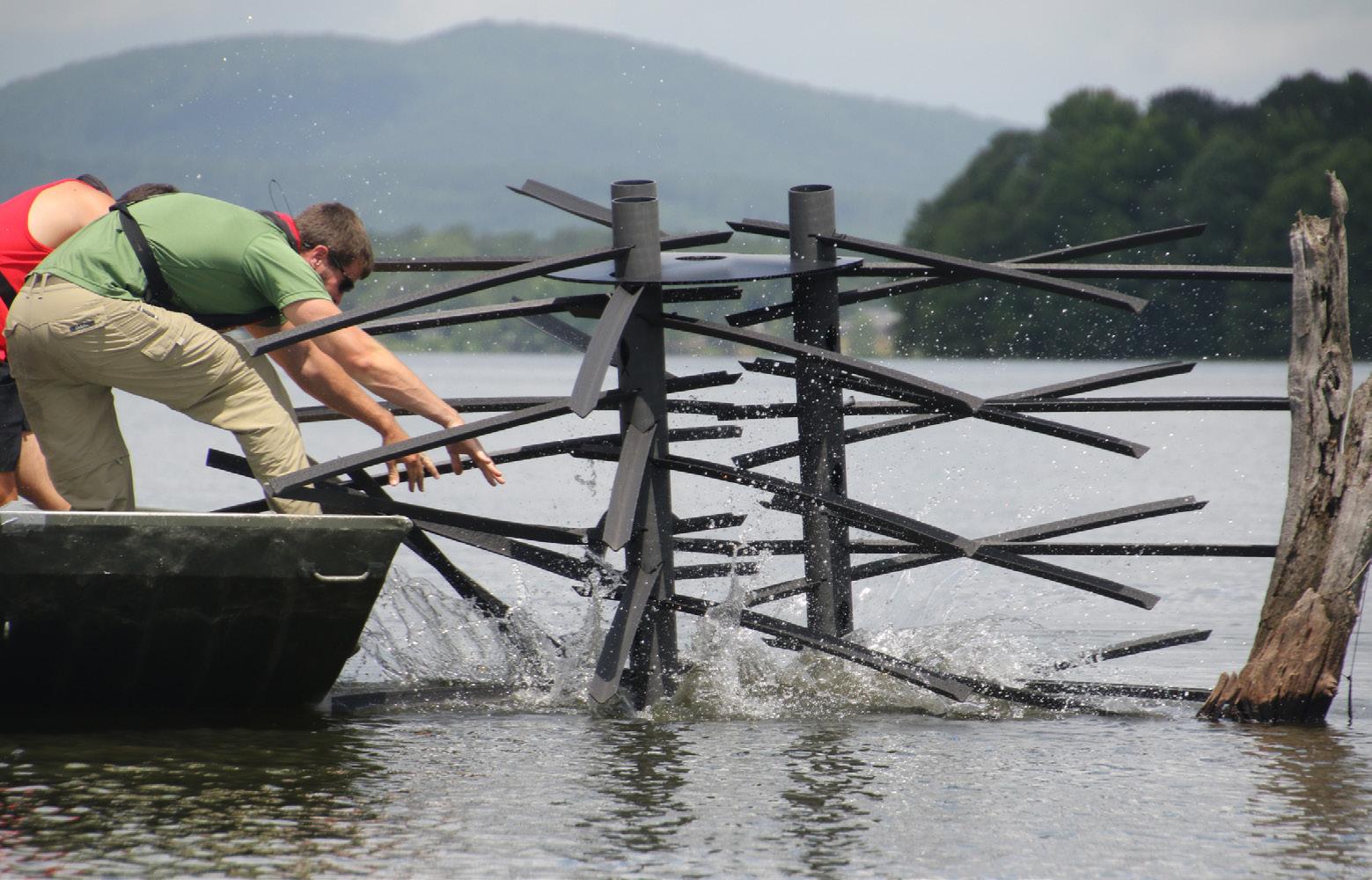
Jibbie Tyler, AGFF’s senior director of corporate partnerships, said the initiative gives companies a chance to support the commission’s programs protecting wildlife and fishing and even co-brand. “It’s a chance for a company to aid the agency and target the desired audience. A true partnership pushing each other to success in honor of our Natural State.”
AGFF President Deke Whitbeck said data overwhelmingly reveals that Arkansans maintain a highly positive perception of the commission and its conservation efforts. Officials decided it was time to capitalize, and initial discussions were held two years ago. AGFC Deputy Director Spencer Griffith and Alan Turner of Turner Sponsorship Consultants contemplated how to use the partner-
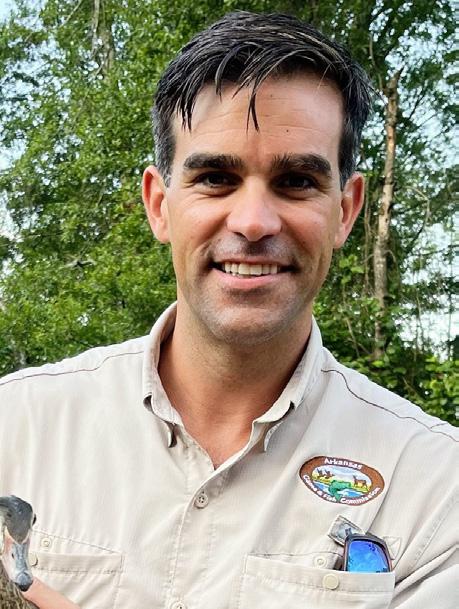
LONG TERM, THE GOAL IS TO SUSTAIN OUTDOOR ACTIVITIES FOR FUTURE GENERATIONS, TO HAND OVER AN ECOSYSTEM IN BETTER SHAPE THAN THAT IN WHICH PREVIOUS GENERATIONS FOUND IT.
ship marketing methodology popular in sports and entertainment and apply it to the state agency space. They pulled Whitbeck in, and an initiative was born.
“We want to share this positive equity with corporate partners that are stepping up to take an active role in conserving habitat in Arkansas for generations to come,” Whitbeck said. “We have both an opportunity and an obligation to pursue efforts to protect and cultivate habitat in Arkansas. It’s a challenge that requires participation from both the public and private sectors, and when successful is mutually beneficial.”
The AGFF’s Corporate Partnership Program is designed to showcase select partners that are dedicating resources to conservation. Commitments have been received from Arkansas-based Greenway Equipment and PRADCO Fishing as well as Fiocchi Ammunition, the Italian

manufacturer with a plant in Little Rock.
Several more commitments are in the final stages, Whitbeck said. He wants to connect with a “limited number” of organizations that share this conservation ideology. In addition to helping do the good work of conservation, partners can benefit by capitalizing on the affinity Arkansans feel for conservation, stewardship and outdoor recreation, and even piggy-back on the AGFC’s popularity, Whitbeck said.
Long term, the goal is to sustain outdoor activities for future generations, to hand over an ecosystem in better shape than that in which previous generations found it.
For Bruce Stanton, vice president and general manager of PRADCO Outdoor’s Fort Smith-based fishing division, conservation is at the heart of the company’s own best interests.


“Conservation is one of those things that almost everyone feels is important, but not everyone actually does something about it,” he said. “We know organizations like Ducks Unlimited, the Theodore Roosevelt Conservation Partnership and the Game & Fish Commission, and even individuals like Johnny Morris of Bass Pro Shops, contribute so much to conserve our wildlife and its habitat. So, PRADCO wanted to do its part both monetarily and through activism to care for our resource and educate folks about our resource.”
In April, PRADCO Fishing announced it would donate $150,000, on top of a $350,000 commitment from AGFC, to revamp the Janet Huckabee Arkansas River Valley Nature Center in Fort Smith.
The company had designated the center five years ago as its “give-back” project to the community, Stanton said. PRADCO employees conduct voluntary quarterly cleanups on and around the center grounds and host a community event at the center on Wells Lake for the commission’s annual Free Fishing Weekend. Stanton said the company has given away as many as 1,000 rods and reels in a day and had folks lined up at 8 a.m. for an event that started at 10.
“With the re-imagining of the nature center in Fort Smith, we wanted to be involved in a big way,” he said. “The commission told us it had committed $350,000 for the revamp. During a meeting of community leaders in Fort Smith, I really felt like we needed to show leadership, because our business is tied to the outdoors and participation in the outdoors by consumers. So, we felt like giving $150,000 to kickstart the local fundraising was a good number.” And in honor of that commitment, AGFC named the fishing pavilion at Wells Lake in honor of 53-year PRADCO employee Bill Jarboe.
Stanton said the contribution served as a challenge to other Fort Smith businesses to get involved. Fourth graders in Fort Smith public schools take a field trip to the nature center each year, so PRADCO’s commitment to it was by extension one to the entire community.
“We know that entertainment has ad-
vanced so much in the past 20 years since the nature center first opened,” Stanton said. “It takes more to ‘wow’ a kid than it used to. We wanted to contribute to that ‘wow’ factor to help introduce kids — and adults — to the outdoors and do our small part in being stewards. It does take money to provide resources to educate folks about conservation and then to actually create programs that provide habitat for fish and game and management of the fish and game.”
Bill Midkiff, president of Greenway Equipment, said the company’s participation in the program represents a chance not only to help the commission but also assist private landowners improve their own resources. Based in Wynne, Greenway operates 32 John Deere dealerships concentrated in the Arkansas Delta with a handful spilling over into southeast Missouri. Conservation of resources is in its corporate DNA.
“Greenway is a local family-owned business with deep roots in both agriculture and land stewardship,” he said. “As farmers ourselves, we know that conservation — leaving the land better than we found it — is a very common goal of all producers and landowners. Much of our daily focus goes into long-term sustainability — not only that of our own business but also of our customers and local communities. So, the mission of the AGFC and its private land programs aligns perfectly with our own.”
Midkiff said Greenway has always provided equipment, parts and service to AGFC operations on state-owned habitats.
“We strongly believe in supporting local, community and state organizations as well as participating in the success and sustainability of our customers’ operations, so this partnership made perfect sense to our company,” he said.
Whitbeck said conservation opportunities are there to be had. One of the commission’s largest is the Waterfowl Rice Incentive Conservation Enhancement (WRICE) Program, which aims to keep “waste rice” available for ducks, geese and other migrating birds when they pass through each winter.
“Fall tillage is becoming increasingly
popular with Arkansas rice growers, but the practice isn’t beneficial for the numerous migrating birds looking to find fuel they need,” he said. “This tilling buries waste rice that would have been available to migrating waterfowl. Under WRICE, farmers may still operate and harvest their rice fields as normal, but can receive added income by leaving stubble and flooding fields during waterfowl migration and allowing permitted public hunting opportunities.”
Whitbeck said that the WRICE program has quickly become a popular one and represents a valuable sponsorship opportunity. The commission’s five fish hatcheries, which produce millions of fish each year for stocking in public waters, represent more enticing sponsorship bait.
“There is opportunity for a corporate sponsor as AGFC will soon make a significant investment in a sustainable water-use program that will save millions of gallons of water annually from depleted aquifers,” Whitbeck explained.
“This sponsorship opportunity allows for an ESG component of water sustainability and will help offset the cost of raising, moving and stocking 20 million fish across the state of Arkansas.”
An added component to a potential hatchery sponsorship is a connection
with the AGFC Family and Community Fishing Program, bringing fishing events, beginner fishing clinics and tagged fish contests to nearly 50 Arkansas communities each year.
Other sponsorships could entail support of agency wildlife programs such as those dealing with deer management, black bass management and urban wildlife, as well as others related to private land management and youth shooting sports.

As outside pressures on habitats increase, emphasis on conservation and stewardship has never been more important, Booth said. And AGFC’s latest strategic plan appropriately includes a major focus on new conservation efforts.
“While our landscape changes under our feet, the people we serve are changing as well,” he said. “The demand for public access has never been greater. Hunter and angler participation is lagging, even after the peak of a pandemic. Arkansans and visitors now approach the outdoors and conservation through a more diverse lens than simply hunting and fishing.”
That means the environment must be equipped to sustain that fast-changing landscape. And leave the lay of the land in the same condition — or better — than it was found.
Arkansas football fans have seen plenty of good in the last few offseasons that didn’t quite pan out come fall.
Malik Hornsby, for instance, looked like a more than serviceable quarterback, and then a potential game-changer as wide receiver, during last year’s spring practice. Fast forward to November, though, and fans were pulling their hair out as Hornsby failed to live up to the promise when thrust into the spotlight. Trey Knox, too, looked like he could burst out as an All-SEC tight end. After a hot start in the 2022 season, though, those hopes fizzled as well.
Nothing, however, has gotten fans’ hopes up more than the prospect of seeing the Razorbacks end up in the Top 10 on either the football field and/or recruiting front. In each of the last two seasons, the Arkansas has ascended into the Top 10 early in the fall, getting as high as No. 8 in the AP poll in 2022 and No. 10 in 2023.
Then the heart of the SEC season struck, and Arkansas was knocked from its oh-so-momentary pedestal. The same dynamic has played out in recruiting circles in recent seasons.
First, there was what in retrospect turned out to be the height of the Chad Morris era, when Morris’ class of 2019 at one point broke into the Top 10 behind the likes of Knox, Jalen Catalon, Treylon Burks and KJ Jefferson.
During last year’s cycle, Arkansas again broke into the national Top 10 in 247Sports’ composite recruiting rankings. Indeed, over at Rivals, the Hogs even briefly, gloriously touched the sun by breaking into the Top 3 before falling back down to Earth in the following months.
That early April 2022 surge was in large part due to Arkansas having 10 commits at that point, which was second in the nation
only to Texas Tech at the time.
By the time the dust cleared on the 2023 signing class, Arkansas stood at No. 22 in the 247Sports Composite, which was still the highest of the Sam Pittman era so far.
Now, Pittman is on pace to finish even higher in the 2024 recruiting cycle. After a flurry of recent four-star commitments, Arkansas is ranked No. 13 nationally in the 247Sports composite. It has more four-star commits than Clemson, Alabama and Florida and just as many as Penn State, Georgia and Notre Dame. (Sure, Alabama, Notre Dame, Georgia and Florida all have more five-stars but, hey, you got to start somewhere.)
The recent additions of Jaden Allen, Charleston Collins and Courtney Crutchfield have elevated Arkansas’ average player rating to 89.66, which is the Arkansas football program’s highest in the modern recruiting era, according to data from 247Sports. They bolster a class that includes a few Alabama natives who have chosen Arkansas over Auburn and/or Alabama, most notably Kavion Henderson, who was at one time the No. 1 recruit in Alabama.
Along with Tevis Metcalf and KJ Jackson, Arkansas now has at least three Alabama native commits for the second straight year. That’s significant because this may be the longest sustained recruiting success the program has ever had in the backyard of the Crimson Tide and Tigers, and may indicate that Pittman and his staff are on the cusp of more recruiting breakthroughs.
Before the recent trio of Alabama natives brought in with the class of 2023, the last time Arkansas brought in three players from Alabama in the same class was 1996, when it signed linebacker Quinton Caver (Anniston High), running back
Chrys Chukwuma (Sidney Lamar High in Montgomery) and linebacker Jamel Harris (Wicksburg High in Newton; recently hired as head coach of Geneva High, Ala.).
Nutt
All three of the above played big roles in the successful first two seasons under former Hogs head coach Houston Nutt, a run that included a share of the 1998 SEC West division crown.
Nutt was able to use that early success, coupled with a dynamic personality that hadn’t quite rubbed many fans wrong, to set the high-mark in Arkansas recruiting in the modern era. With five-star headliner Ahmad Carroll and a star-studded in-state cohort including De’Arrius Howard, Shawn Andrews and Matt Jones, Nutt signed a class in 2001 that ranked No. 9 in the nation. Never mind the Top 10 status; that class remains Arkansas’ only of the modern recruiting era that finished in the Top 15.
But the unusually deep pool of in-state talent of this class of 2024 is helping Arkansas flirt with the possibility of another Top 15 class. Michael Williams, Crutchfield’s coach at Pine Bluff High, an Arkansas native and long-time Razorback fan, sees the recent commitments as a “huge statement” on the part of Pittman and a staff full of hungry younger assistants.

“It kind of feels like back in the Houston Nutt days when we were something to reckon with,” Crutchfield told The Athletic’s Grace Raynor. “I think by them making this statement, (the current staff is) letting everybody know football is about to be back in Arkansas.”
Williams coached much of the last couple decades in Texas, and he’s never doubted the efforts of Razorback coaches there. But this is different. “Being in Texas the last 20 years, I’ve seen Arkansas come there a lot, but I’ve just never really seen them recruit Arkansas like that,” Williams told Rayor. “But I think they’re making a special commitment (to in-state prospects).”
Of course, it’s also easy to look at these lofty numbers, shrug your shoulders and say: “Get back with me when the digital ink’s dried on those NILs.”
The hot start this time around, however, may be more than the glitter of fool’s gold.
This time last year, Arkansas was essentially padding its numbers in the 247Sports composite and Rivals by having more commits than most anybody else. So, in those rankings, a team with 12 three-star commits will chime in higher than a team with 5 four-star commits, even though the latter is probably a better class.
But this year’s different. The Hogs are more in the middle of the pack when it comes to number of verbal commits, and they are still doing well according to On3, which alone among the major recruiting rankings attempts to weigh the fact that classes have varying sizes at this point and uses the current national average of commits (which is six right now) to calculate its rankings.
Indeed, on On3, Arkansas also retains a Top 15 class by coming in at No. 16 (as of April 27). It speaks to the disgusting riches of the SEC that this is still middle of the pack of the conference, but sneaking ahead of SEC West rivals Texas A&M and Ole Miss is no small feat at this stage of the game.

Here’s a list of the Razorbacks’ commitments in the Class of 2024 (as of May 1)
• DE Kavion Henderson — Leeds (Ala.) — committed Nov. 6, 2022
• DT Dion Stutts — Memphis (Tenn.) University School — March 11, 2023
• ATH Noreel White — Ocean Springs (Miss.) St. Martin — March 13, 2023
• ATH JuJu Pope — Batesville (Miss.) South Panola — April 8, 2023
• QB KJ Jackson — Montgomery (Ala.) St. James — April 9, 2023
• CB Jaden Allen — Aledo (Texas) — April 21, 2023
• DE Charleston Collins — Little Rock (Ark.) Mills — April 21, 2023
• WR Courtney Crutchfield — Pine Bluff (Ark.) — April 21, 2023
• CB Tevis Metcalf — Birmingham (Ala.) Parker — April 22, 2023

























 By Jeff Standridge
By Jeff Standridge


In the past two issues, we have discussed the impact of mental toughness (also called mental resilience, perseverance and grit) on both individual and organizational performance. We explored the impact the global COVID pandemic has had on mental resilience, and we reviewed a bit of the research exposing the lack of mental toughness in the world today.
Finally, we scratched the surface to uncover how individuals can fuel their own mental toughness by being more mindful and deliberate in their day-to-day lives. In short, when we refer to mental toughness, we are referencing the ability to cope with uncommon stress, to maintain a positive attitude and to persist in the face of adversity.
Through our discussions the past two months, it has become evident that mental toughness is a critical aspect of success in today’s fast-paced business environment. More and more, companies are becoming aware of the need to promote mental well-being in the workplace, including overall mental health. There are several companies that are well-known for their efforts in developing mental resilience among their employees.
Google has become known for its focus on employee well-being and mental health, offering numerous programs to help employees better cope with stress. These programs include mindfulness training, yoga classes and access to mental health resources such as counseling and support groups. The tech giant also encourages employees to take time off when they feel the need to do so, and provides a supportive work environment that fosters collaboration and community.
Outdoor clothing company Patagonia has been recognized for its unique approach to employee well-being. The company offers a number of programs to help employees manage stress and build resilience, including on-site meditation and yoga classes, mindfulness training and access to outdoor activities such as hiking and
skiing. Additionally, Patagonia encourages employees to engage in volunteer work and other meaningful activities, which can help promote a sense of purpose and well-being.
Customer-relationship management software company Salesforce has a strong focus on employee well-being and mental health. The company offers various resources to help employees build resilience, including mindfulness training, stressmanagement programs and mental-health support services. Additionally, Salesforce has developed a supportive workplace and leadership culture that values collaboration and open communication, which can help foster a sense of community and belonging among employees.
The U.S. Army and other branches of the military are known for their emphasis on mental toughness, which is an essential attribute for soldiers, sailors, airmen and Marines to have in order to succeed in the challenging and high-stress environment of military service. In addition to requiring all new Army soldiers to undergo Basic Combat Training (BCT), the Army also employs specific programmatic approaches to building mental toughness among its soldiers, many of which can be applied to other organizations.
• Leadership Development: The Army places a strong emphasis on leadership development, which is an important aspect











“The quality of being adaptable, with the ability to bounce back despite significant adversity, and to remain focused on a desired outcome, regardless of the external situation, circumstances, or pressure.”
[Editor’s note: This is the third installment of a three-part series on mental toughness in the workplace.]
of building mental toughness among soldiers. The Army offers a variety of leadership training programs, including the Officer Candidate School (OCS) and the Noncommissioned Officer Education System (NCOES). These programs help soldiers develop essential leadership skills such as decision-making, problemsolving and effective communication, which can help them build mental resilience.
• Resilience Training: The Army offers resilience training programs to help soldiers develop the skills they need to cope with stress and adversity. These programs include classes on stress management, mindfulness and positive thinking. Soldiers are also encouraged to seek mental health support when they need it, and the Army provides a range of resources to help soldiers cope with mental health issues such as PTSD and depression.
• Physical Fitness: Physical fitness is an important aspect of building mental toughness in the Army. Soldiers are required to maintain a high level of physical fitness, and the Army offers a variety of programs and resources to help soldiers achieve and maintain their fitness goals. Physical fitness can help soldiers build mental resilience by improving their overall health, reducing stress and boosting self-confidence.
• Realistic Training: The Army places a strong emphasis on realistic training, which exposes soldiers to challenging and unpredictable situations that require them to adapt and overcome obstacles. This type of training helps soldiers build mental toughness by exposing them to the stress and uncertainty that they may encounter in combat situations. Realistic training also helps soldiers develop problem-solving skills and the ability to think quickly under pressure.
Overall, the U.S. Armed Forces takes a comprehensive approach to building mental toughness among its members. These programs help military men and women develop the skills they need to cope with stress and adversity, which is essential for success in military service.
Some common themes among companies that are taking proactive steps to increase the mental toughness and resilience of their workplace can offer a framework for companies looking to build mental toughness among their workforce. Such common themes include the following:
Offering Mental Health Support: One of the most important things that companies are doing to build mental toughness is to offer mental health support. This includes providing access to counseling services, support groups and other resources to help employees cope with stress and mental health issues. Many companies are also investing in mental health training for their managers and supervisors to help them to recognize potential issues more quickly, and then to better support their teams.
Promoting a Culture of Wellness: Another way companies are building mental toughness among their workforce is by promoting a culture of wellness. This includes encouraging healthy habits such as regular exercise, healthy eating and promoting proper sleep habits. Many companies are also providing access to on-site fitness facilities, healthy food options and other resources to support their employees’ general well-being.
Encouraging Work-Life Balance: Many companies are also rec-































ognizing the importance of work-life balance in building mental toughness among their workforce. This includes offering flexible work arrangements such as telecommuting and encouraging employees to take time off when they need it. By promoting a healthy balance between work and personal life, companies can help employees reduce stress and maintain a positive attitude.
Providing Ample Professional Development Opportunities: Providing professional development opportunities is another way that companies are building mental toughness among their workforce. This includes investing in training and development programs to help employees acquire new skills, knowledge and abilities. Many companies are also providing mentoring and coaching programs to help employees reach their full potential. By providing opportunities for growth and development, companies can help employees feel more engaged and motivated in their work.
Fostering a Sense of Purpose: Fostering a sense of purpose is another important aspect of building mental toughness among employees. Many companies are doing this by clearly communicating their values and mission, and aligning employee roles and responsibilities with the company’s goals. This helps employees understand how their work contributes to the company’s success and feel more invested in the company’s mission.

Offering Focused Resilience-Building Programs: Companies are also building mental toughness by deliberately and specifically building resilience among employees. This includes providing training on stress management, time management and other skills that can help employees cope with adversity. Many companies are also developing programs that expose employees to a range of new and challenging experiences, such as offering “stretch assignments,” offering various experiential learning opportunities and providing opportunities for employees to develop problem-solving skills and other capabilities that are essential for resilience.
In the final analysis, mental toughness is an important aspect of success and fulfillment in today’s world, but more specifically in just about any workplace. Companies that proactively seek to recognize the resilience gap among their employee population and take specific steps to close those gaps are not only positively impacting the lives of their employees, but are also increasing the likelihood of sustained success of their organizations.



Dr. Jeff D. Standridge helps organizations and their leaders generate sustained results in the areas of strategy, leadership, profit growth, organizational effectiveness and innovation. He is a three-time bestselling author, executive coach and consultant. Jeff can be reached at JeffS@ InnovationJunkie.com.

“
Mental toughness is a critical aspect of success in today’s fast-paced business environment.
Six stories high and with 500 hospital beds, the massive Nyberg Building, named after Arkansas Representative Leo E. Nyberg, opened in 1940 and served as the point of admission for tens of thousands of tuberculosis patients at Arkansas Tuberculosis Sanatorium south of Booneville.

(Courtesy of Booneville Historical Preservation Society)
In late 2019 – just months before a global pandemic would turn the world on its head – two men began work on a book about a disease far more insidious than COVID and far more deadly than any true crime tale. The result, published this April from the University of Oklahoma Press, is “Stalking the Great Killer: Arkansas’s Long War on Tuberculosis.” Co-authored by historian Larry Floyd and renowned public health figure Joe Bates, MD, MS, the book traces the history of the world’s deadliest infectious disease through an Arkansan lens, from the establishment of the state sanatorium outside Booneville in 1909 to the pioneering work of Bates and his colleagues to revolutionize TB treatment in the 1960s and 70s.
“People don’t realize how bad tuberculosis was. It kind of reached a peak after the industrial revolution, as people started working and living more closely together,” Floyd said. “Arkansas and many southern states, back in the 19th and early 20th century, were hit very hard. It was as bad as COVID was, year after year, for over 100 years.”
Though the disease dates all the way back to the Stone Age, developed countries have only been able to effectively treat tuberculosis in recent generations. For a long time, tuberculosis was the most common cause of death in Arkansas, and it remained a leading cause of death well into the 1950s. Before the development of effective drug therapies, the only real option was to isolate the infected by sending them to the sanatorium, where the fresh mountain air was thought to be beneficial. The Arkansas State Tuberculosis Sanatorium, once the largest in the nation, only officially closed in 1973.

“Stalking the Great Killer” creates a nuanced and compelling telling of this history by weaving together all of the interests at stake, from the social and political to the medical and personal. The book opens in 1949, with a then-teenaged Bates driving his favorite uncle – not much older than Bates,
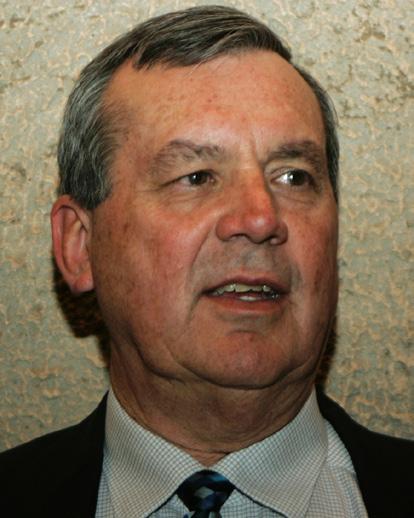
and more like a brother – to the Booneville sanatorium.
“He lived in a little town called Waldo in southwest Arkansas. I drove down there from Little Rock and met him,” Bates said. “He was married and had three young boys, all less than ten. I remember vividly them waving goodbye.”
This experience piqued Bates’ interest in the disease, and as he was coming through college and then medical school in the 1950s, new drug treatments for tuberculosis were being developed. Bates studied tuberculosis and other infectious diseases in graduate school before beginning his research and clinical career, first at the VA Hospital and then at UAMS, where he still works today as a professor of epidemiology and associate dean in the College of Public Health.
In the 1960s, Bates and colleague Paul Reagan began working together to take on the disease. Having seen studies in other countries suggesting the use of drug therapy to reduce infectiousness, Reagan and Bates proposed an experiment of their own: they would treat tuberculosis patients for just two or three weeks at Pine Bluff’s Jefferson Hospital before sending them back home.
“At the time, I was beginning to achieve national recognition for my research in tuberculosis. I became president of the American Thoracic Society; I was the president of the American Lung Association and got all kinds of awards for my work in tuberculosis,” Bates said. “Even as a young man, I had some national status as a legitimate tuberculosis investigator when we were trying to do this.”
Despite the treatment’s potential to be lifesaving for families and communities, vested political and economic interest in keeping the sanatorium open posed obstacles.
“Paul contrasted me; he liked confrontation. He didn’t mind that the legislature was upset and he had to go before legislative committees,” Bates said. “The medical society officials had their meetings, asked him hard questions and didn’t agree with what we were proposing. But both of us had confidence in what we were doing, that it was a good thing to do.”
The pair successfully proved that tuberculosis sufferers could be treated in general hospitals, often in their own communities, rather than being torn from their families and livelihoods for months or years on end at the sanatorium. This was a radical development in the treatment of TB, and Bates and Reagan gained international attention for their findings.
“We presented our report to the American Thoracic Society, which is the leading chest disease organization in the world, and it was chosen as the best paper at this very big meeting,” Bates said. “We were asked to present it in England. Others tried it, and over a two or three year period, most of the sanatoria in the United States closed. People were treated for tuberculosis at selected general hospitals throughout their state.”
This groundbreaking course of treatment propelled Arkansas to the forefront of the fight against tuberculosis; even today, the state’s case rate remains below the national average.
“There were a number of medical authorities at the Centers for Disease Control that were looking at and actively praising Arkansas,” Floyd said. “Many of them visited the state to talk about the pilot program and the success that Arkansas was having under Dr. Bates and his colleagues’ direction.”
Both Floyd and Bates pointed to the critical role of community involve-
From left, medical researchers and treatment pioneers Paul Reagan, Joe Bates and William Stead reminisce a year or so after Stead’s retirement from the Arkansas Department of Health in 1998.
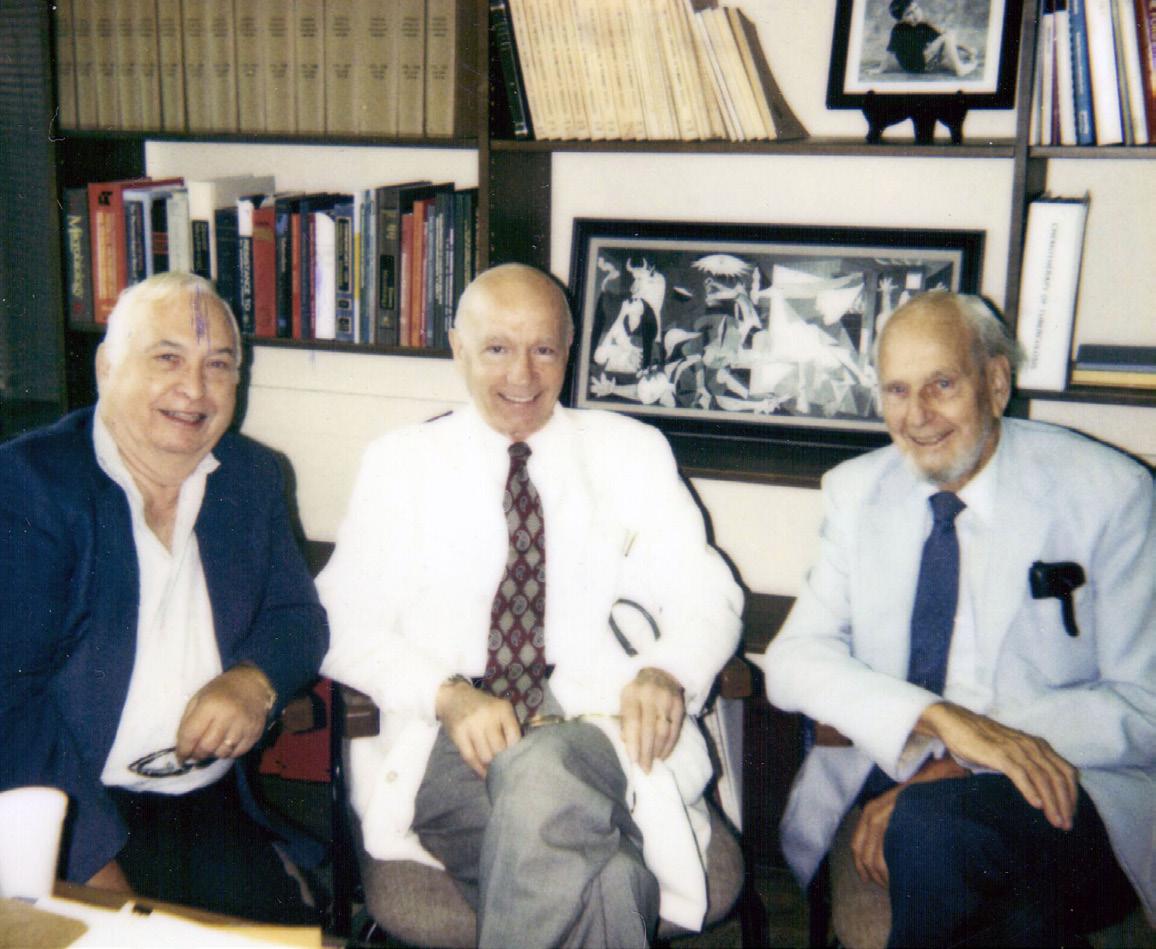
(Courtesy of Dr. Joseph H. Bates)
ment in this history; even in the decades before drug therapies, political, medical and community leaders were coming together to bolster Arkansas’ health infrastructure and educate the public. Throughout “Stalking the Great Killer,” Floyd and Bates highlight the other heroes of this fight, all of whom had a hand in helping the state – and the nation – come out on top against TB.
“I was persuaded to do this, in part, because if I didn’t tell this story, it would never be told. I was the one remaining person that had experience and memory and documentation of how we got it done,” Bates said. “Larry provided the professional historian flavor to it, and I provided the medical knowledge and experience.The two of us together, I think, made a pretty good team.”
Vitally, the book also serves as an important reminder for future generations as the work goes on to eradicate tuberculosis and other diseases worldwide.
“I think in medicine, like many other professions, there are certain traditions. It’s been done that way for a long time, and then some young squirt comes along and introduces a totally different approach,” Bates said. “It takes a long time for fundamental changes in medicine to be broadly adopted. It doesn’t happen overnight. It can take years. A vaccine – if it’s effective – is lifesaving. There’s work going on on HIV, on malaria, on TB. These are the three big killers in infectious diseases, where we need a vaccine. There’s progress, good progress, on all three.”
The Lancet, a prestigious international publication in circulation since 1823, recently reviewed “Stalking the Great Killer” in its respiratory medicine journal. In addition to commenting positively on the book’s “fascinating account” that is “neatly balanced between the local, regional and global,” reviewer Talha Burki remarked, “Bates and Floyd have an astute grasp on the contingency of history. The progress they describe is not presented as inevitable or even irreversible.”
Whether you’re interested in the history, the science or the deeply human moments, “Stalking the Great Killer” is a poignant recounting of a major chapter in the stories of Arkansas and the world.
Floyd and Bates will have their first book signing at the Logan County Public Library, where Floyd spent many hours digging through what he describes as “the finest repository of information about the sanatorium,” in May. There will be another signing at the UAMS Historical Research Center planned for a later date.
To purchase “Stalking the Great Killer” or for more information, visit the University of Oklahoma Press online at oupress.com.

In 1927, George Pappas opened the Fayetteville brick-andmortar that is nationally known, George’s Majestic Lounge. As the oldest and longest-running club and live-music venue in Arkansas, George’s Majestic Lounge has nearly a century’s worth of history held within its walls. History-making, and often referred to simply as George’s, the venue has managed to shine a light on not only Fayetteville and northwest Arkansas, but also on The Natural State as a whole. The venue was the first bar to integrate in the late ῾50s, was the first bar in NWA to offer color TV and pizza delivery service, and has seen many notable figures walk through its doors.
According to co-owner Brian Crowne, the location began hosting live music on a regular basis in the early ῾70s, but was known for its social events, dances and music as far back as the ῾30s. While the venue is small, it has seen great talent leading to its success. Bands such as Florida Georgia Line, Rainbow Kitten Surprise, Old Crow Medicine Show and Fitz and the Tantrums have played here, and solo artists like Pat Green, Sam Hunt, Eric Church, Leon Russell and Cody Johnson have all played on George’s stage.
Pappas, the original owner and namesake of the venue, sold his restaurant, bar and general store to Mary and Joe

Hinton in 1947. Mary Hinton owned the location until she decided to sell it to a couple who had their first date in the ῾50s at the hot spot, Dr. Bill Harrison and his wife, Betty. The couple maintained ownership until 2004, when they sold it to Suzie Stephens, who then sold the property to current owners Day and Brian Crowne. Brian also serves as vice president of the region’s primary concert venue, the Walmart AMP in Rogers.
Crowne understands the language of live music and has experience both as an artist and as a booking manager. Back in his live-performing days, he played happy hours and late nights at George’s, predating his ownership of the venue.
“My wife and I were fortunate enough to buy George’s in 2004. I think the ownership transitions of George’s Majestic Lounge are important because, as the fourth owners of the business over 95 years, it shows me that the owners cared about the business and the community,” Brian said. “I think that the longevity is why George’s still exists, and that’s something that I think is pretty cool.”
George’s Majestic Lounge has served countless people over the years and kept pieces of Fayetteville’s past on the walls of the establishment. Inside George’s, the Crownes have maintained a library of University of Arkansas yearbooks that dates back to 1906, preserving a piece of local — and state — history.
“I find myself asking ‘What if these walls could talk?’ a lot,” Crowne said. “Everybody from President Clinton to Don Tyson has visited this establishment and just a lot of legendary northwest Arkansas people have come through these doors to hang out.”
According to Crowne, there are always things that need to be done in order to stay relevant, especially in a business that has existed as long as George’s. However, Crowne believes that the consistency the venue has provided has helped make it unique and desirable for customers and artists alike.
“When I first started playing music here in late ῾89, we would play from 5 p.m. to 6 p.m. and then come back and play a late night show,” Crowne said, explaining that the Friday night happy-hour concert has been tradition at George’s for approximately 45 years.
“We’ve continued that tradition by making it more of a headline concert that plays from 6 to 8. We have a lot of local bands
that play those slots.”
The crowd at George’s varies depending on who’s playing, and Crowne said ages regularly range anywhere from 40 to 80.

“Our guests that were also guests under other ownership also experienced the same Friday night shows, and that’s been one of the traditions that we’ve maintained, even during times of transition, to keep continuity of experience,” Crowne said.
He also credits the success of the venue to the patron experience, which he and his wife work to keep consistent and exciting.
“Day and I have really tried to run this business thinking about what it’s like to be a patron, and we treat people the way we would want to be treated. I think about how George owned for 20 years and did the same. The patron experience has been consistent through all the owners, and that’s a major reason why people keep coming back.”
With George’s closed during the pandemic, Crowne said he realized just how important live music is to the community, and how much music means for well-being.
“Day and I are proud to be able to be part of offering our community something that we think is important to overall public health, and providing that opportunity to have an escape from reality through live entertainment,” he said. “People missed the interaction; they missed having the chance to stand in front of a band they liked, and it’s so fulfilling to know what it means to people. It’s something that my wife and I take seriously, and it’s cool to look at the sum of it all and see that we are making a positive impact, therapeutically, on the community while also making a really positive economic impact.”
Crowne also explained that George’s, and live entertainment venues in general, are a big part of what he refers to as the “night economy.” The night economy, in live music, brings the gig workers out to the area, provides staff with pay and tips and brings in tourists excited to see the show. But they also stay at hotels, eat at local restaurants and enjoy the community.
“It’s bigger than some people realize. It’s not just about putting on a show, but it’s also about the ripple effect of the entertainment economy and how far the ripples go to other industries,” he said.
As a legacy institution, George’s plans for the future are similar to what they have always been — remain relevant through booking bands and acts people want to see and hear.
“I find myself asking, ‘What if these walls could talk?’ ”
Brian Crowne
The loud freight trains that roar past the Amtrak depot in Walnut Ridge don’t wake her.
The rush of wind from the speeding freights some 40 feet away from the station often blows open the glass door leading to the tracks. In the cold nights, chilled air rushes in, but she doesn’t mind. The woman wraps herself tighter in her blankets and burrows in on the metal bench she calls her bed.
Beneath her are her two dogs, Dan-Dan and Sam. A large bottle of Great Value fruit punch, a bag of crackers and can of soup are near the bench. A hot plate used for cooking sits atop a shelf in the tiny station’s waiting room.
This is her home now, a brief respite for wherever next she may end up.
“I like it here,” she says. “I get to meet a lot of people.”
The woman came to Walnut Ridge earlier this year, looking for a place to stay. A police officer took her to the station and let her sleep there. She repays the city’s kindness by cleaning the waiting area, the two bathrooms and the platform where travelers board the trains. She also picks up trash in the two parking areas.
“I missed it a couple of days,” she says. “There were a lot of cigarette butts to pick up.”
The Texas Eagle, Amtrak’s train that runs daily from Chicago to San Antonio and back, stops in Walnut Ridge in the wee hours of each morning. The southbound Texas Eagle 21 is supposed to roll into the Lawrence County station at 12:37 a.m. The northern train, the Texas Eagle 22 headed to Chicago, is scheduled to arrive in Walnut Ridge at 1:41 a.m.
Often, though, the trains are late, and she hears the wrath of those impatiently waiting in the station on the hard plastic benches.
And here is the contrast: The travelers are rushing off to places for business or to visit families. The clock is important, and it’s vital the trains are running on time, so people can catch the commuter trains out of Chicago or San Antonio.
When those in the waiting room hear the bleating of a train horn approaching the station, they often gather their suitcases, coats and bags and head for the platform. She knows now the difference between a freight train’s wail and Amtrak’s warning horn. If it’s a freight train rather than the Amtrak, the people return to the station angry as the freight blasts through, a reminder that the Amtrak train is late.
The woman, on other hand, at the age of 60, is content to be here and is at peace. For her, the station is one of the better places she’s stayed.
“People ask me questions,” she says. “They may recognize me if they’ve come here before. If they don’t know something about the trains, they’ll ask.”
She also provides homey touches in the station. She placed a decorative plastic croissant roll on a table next to promotional magazines the local Chamber of Commerce displays on a shelf. She also set an apple on a stand.
She buys books at a local flea market and sets them on the
shelf. Michael Crichton’s “Eaters of the Dead,” Thomas Hardy’s “Tess of the D’ubervilles” and other classics once sat out for visitors to read during waits for the train. Within a week of their placements, they were gone.
Here is a story shared by many homeless people. She grew up in Lawrence County but has stayed in Possum Grape, Pangburn, Bald Knob, DeValls Bluff, Hoxie and Marked Tree. She also stayed in Oklahoma for 25 years, using the transients’ word “stayed” in towns rather than “lived.” You don’t “live” somewhere if you don’t know when or where your next stop may be.
She’s worked as a cashier, a cleaning lady and a security guard.
The woman feels safe in the station, despite the doors never being locked. Police patrol the lot at night, and the people who wait for trains are decent, other than being miffed if a train is running late.
One night after midnight, a young man passing through town stops at the station and engages in a long conversation with the woman about religion and his life. He had been addicted to drugs but cleaned up after going to a rehab center. He wants to share his story with anyone who will listen. And she’s a good listener.
Later, he helps her walk the dogs along the train tracks.

Soon, the Amtrak train’s whistle blows. The crossing guard bells ring, and the train glides into the station. People get off the train and head to their cars parked in the lot. Within a few minutes, the train rolls off again; the sudden scurrying that breaks up the stillness of the late Walnut Ridge night returns to silence.
She sometimes wonders about the passengers she’s met. Will they see their families? Will they get to their destinations on time? Will she ever see them again?
The woman also thinks about one day getting on the train herself.
“I hear there’s a train that goes around a mountain near Fort Worth,” she says. “I think about that.
“Someday, I’d like ride that train and see what’s on the other side of that mountain.”









At Conway Regional Cardiovascular Clinic, our highly-skilled group of interventional cardiologists and emergency department physicians have one of the state's best door-to-balloon times for providing emergency heart care. To schedule an appointment with the Conway Regional Cardiovascular Clinic, call 501-358-6905 or visit ConwayRegional.org to learn more.
We’re not just growing—we’re growing together.
 Left to Right: Ronak Soni, MD, Don Steely, MD, Rimsha Hasan, MD, and Yalcin Hacioglu, MD of Conway Regional Cardiovascular Clinic
Left to Right: Ronak Soni, MD, Don Steely, MD, Rimsha Hasan, MD, and Yalcin Hacioglu, MD of Conway Regional Cardiovascular Clinic